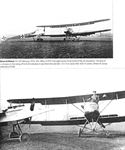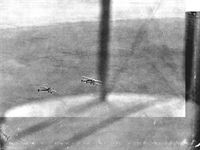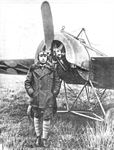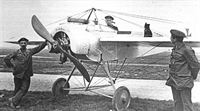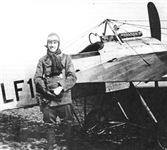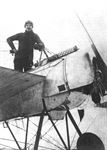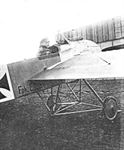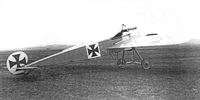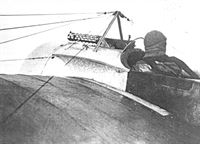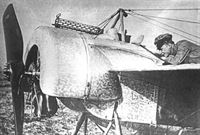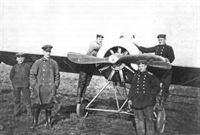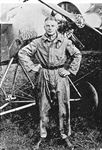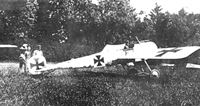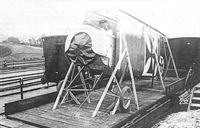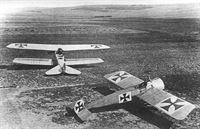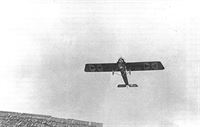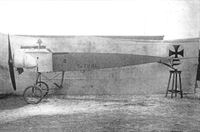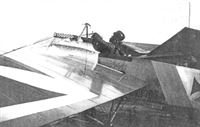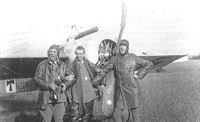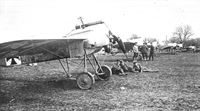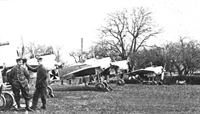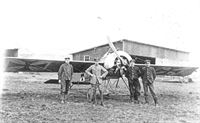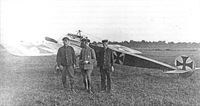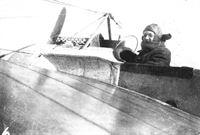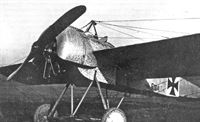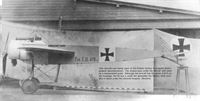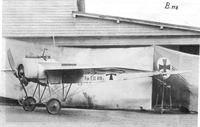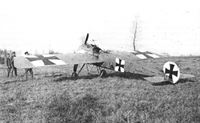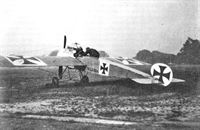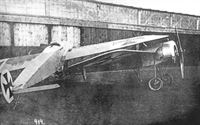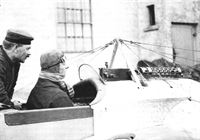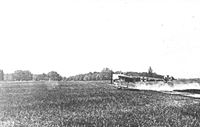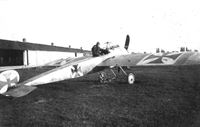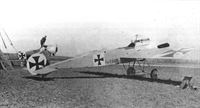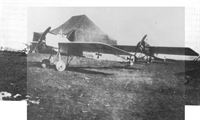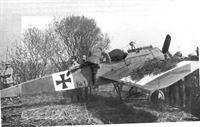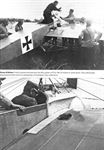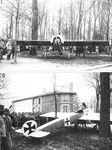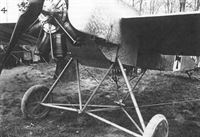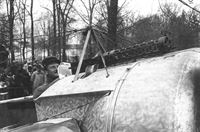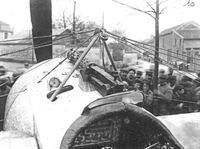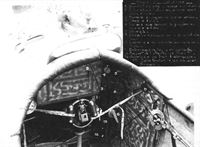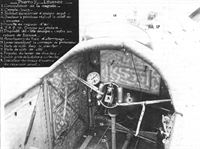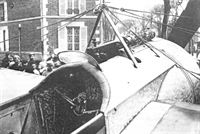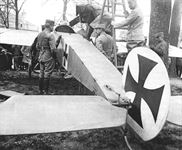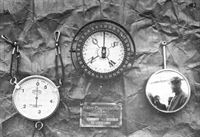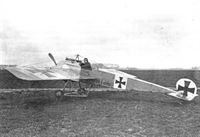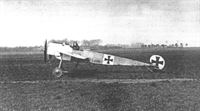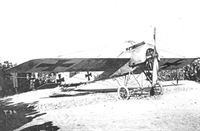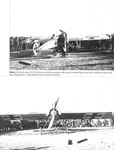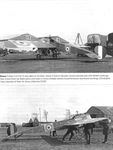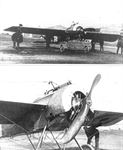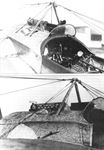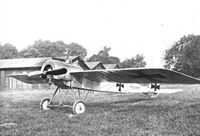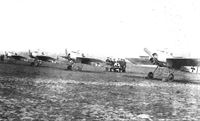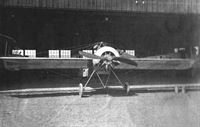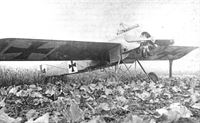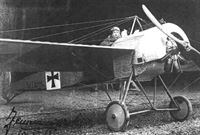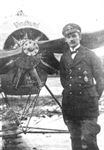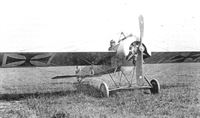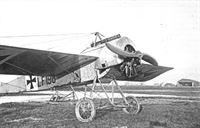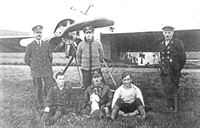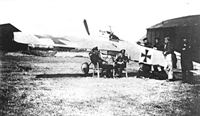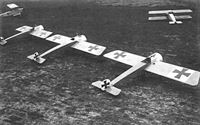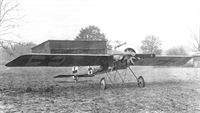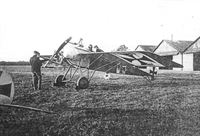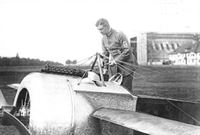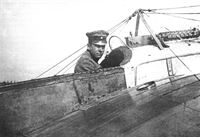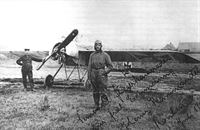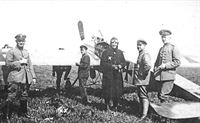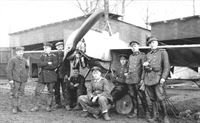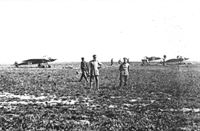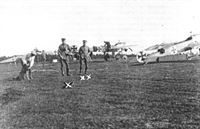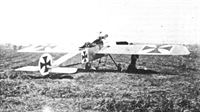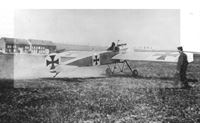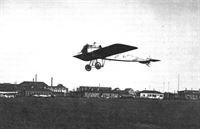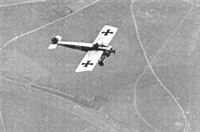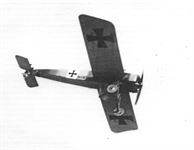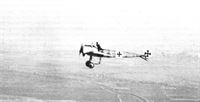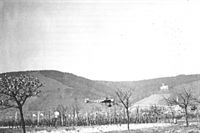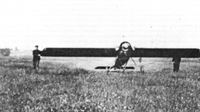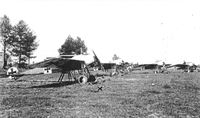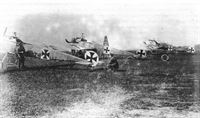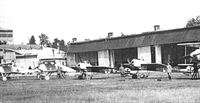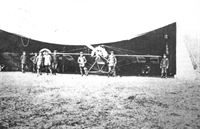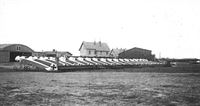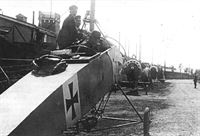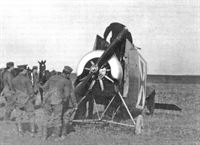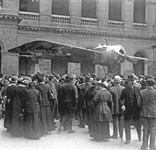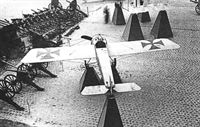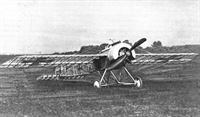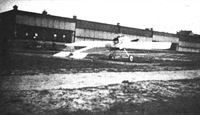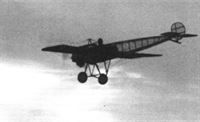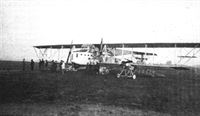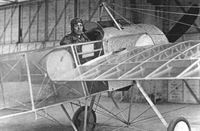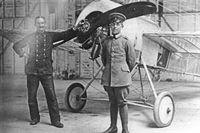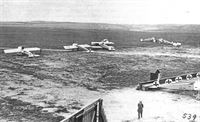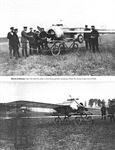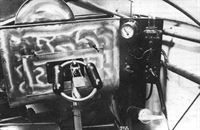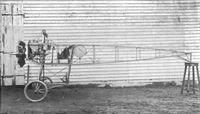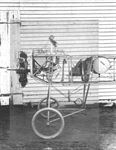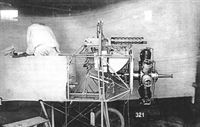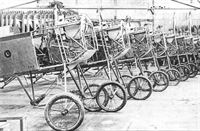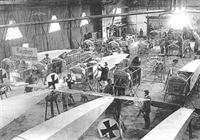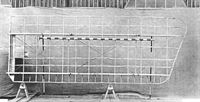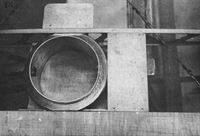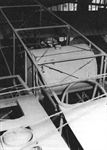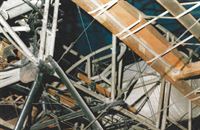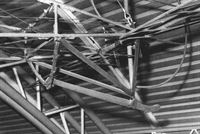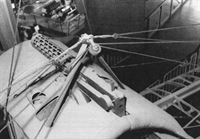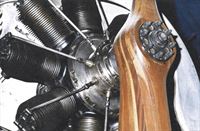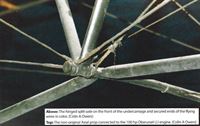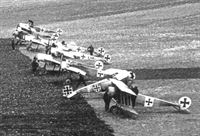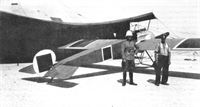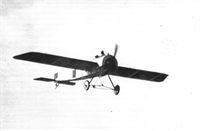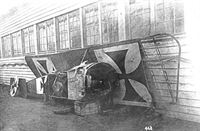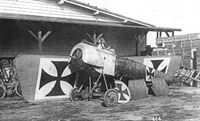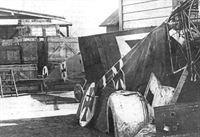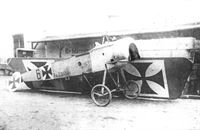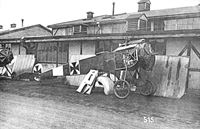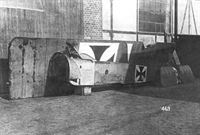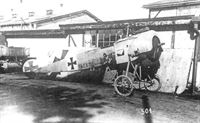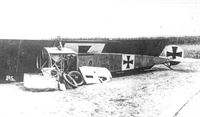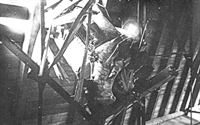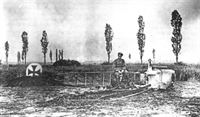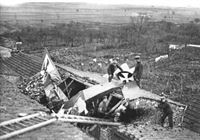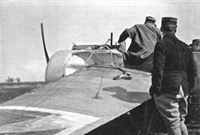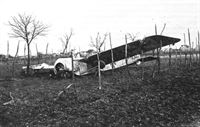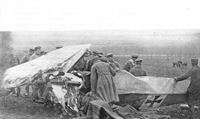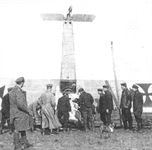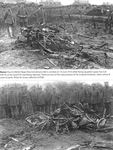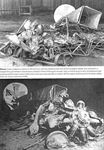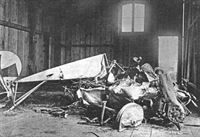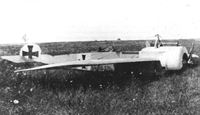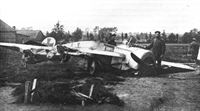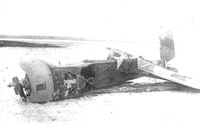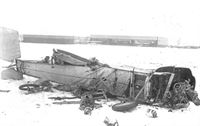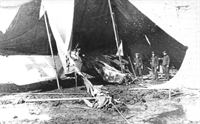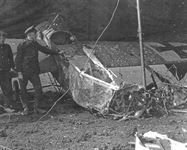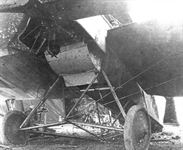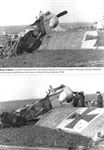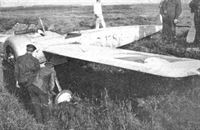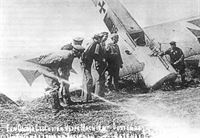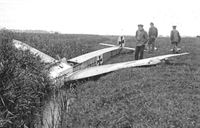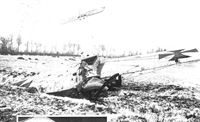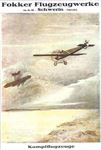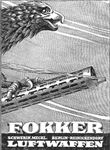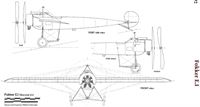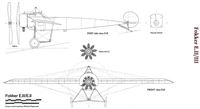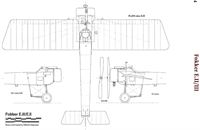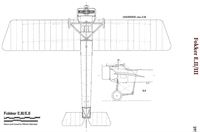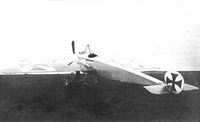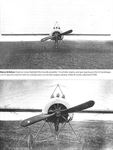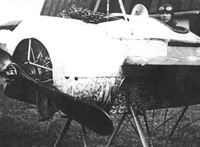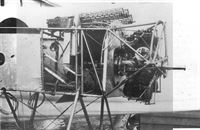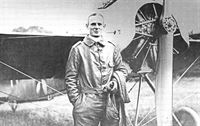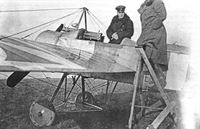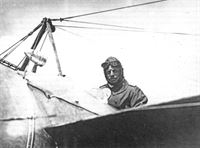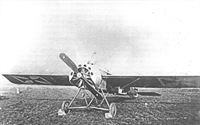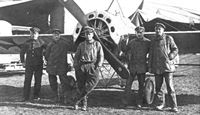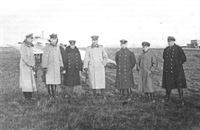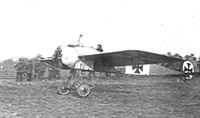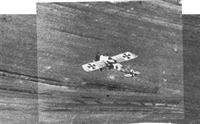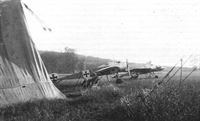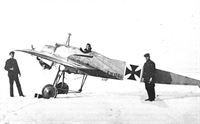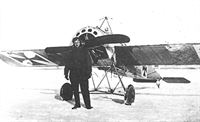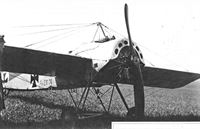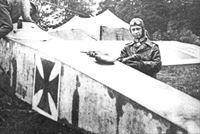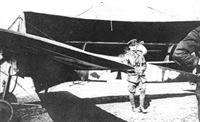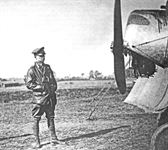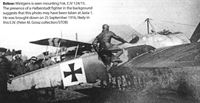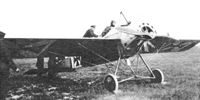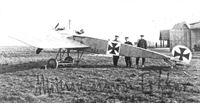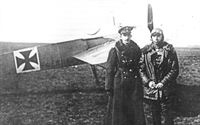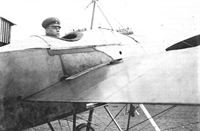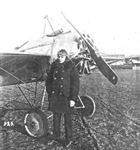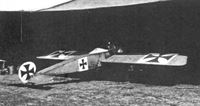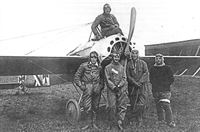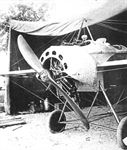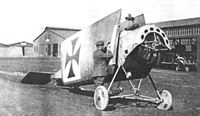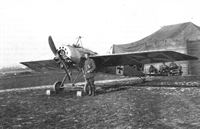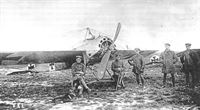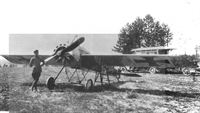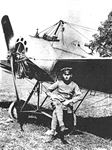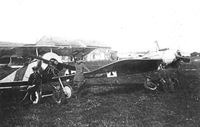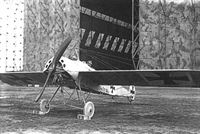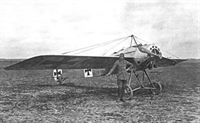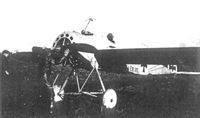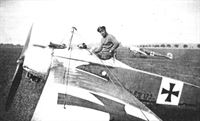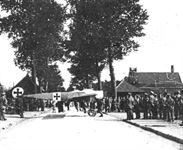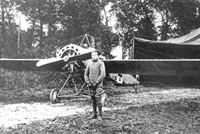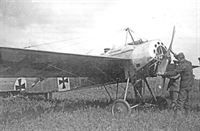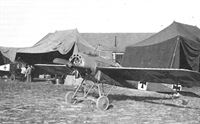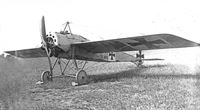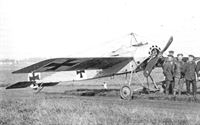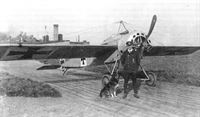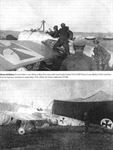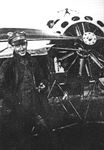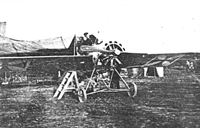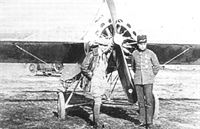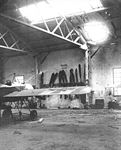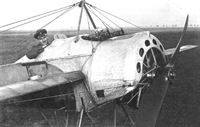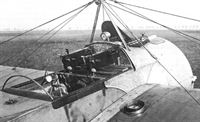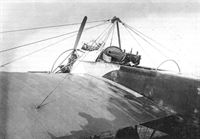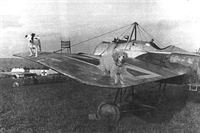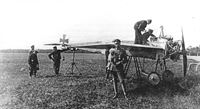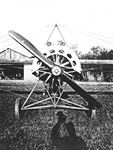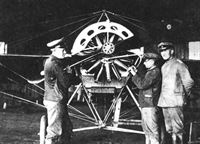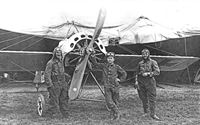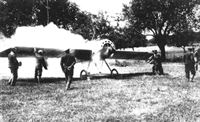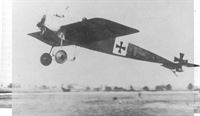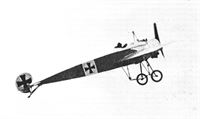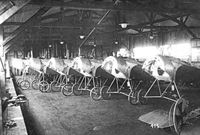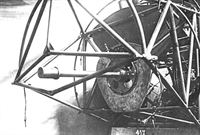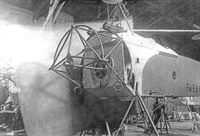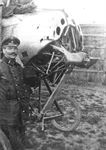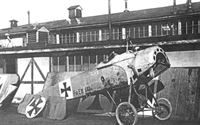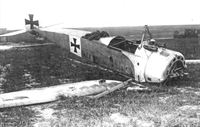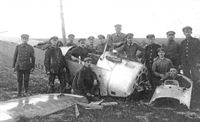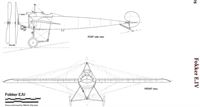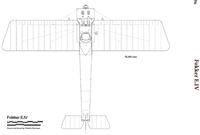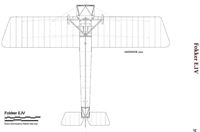Книги
Centennial Perspective
J.Herris, J.Scott
Fokker Aircraft of WWI. Vol.2: Eindeckers
728
J.Herris, J.Scott - Fokker Aircraft of WWI. Vol.2: Eindeckers /Centennial Perspective/ (52)
On 29 February 1916, Vfw. Wass of FFA 3 brought down FE2b 6338 of No.20 Squadron. The lack of a compass in the wing of his E.III indicates it was from the late 86-121/15 or early 400-435/15 series. (Peter M. Grosz collection/STDB)
By the time of Immelmann's 5th victory on 26 Oct 1915 (Vickers FB5 5462, seen in the background), the stripes had been scrubbed off and a pair of large, off-kilter crosses had been painted in their place, much like on his E.I 13/15. (Lance Bronnenkant)
FFA 22 was also equipped with the twin engine AEG G.II. Bulow-Bothkamp and E 29/15 are seen in front of one of the unit's Kampfflugzeuge. (Greg VanWyngarden)
E.33/15 eventually had Eiserne Kreuze applied onto the white portion of the fuselage band. The rudder was painted black as per AA Gaede practice. The Ago C.I in the background also exhibits the unit's sash marking. (Greg VanWyngarden)
The Zeppelin hall at Metz is seen housing a number of Albatros and LVG C-types as well as three Fokker Eindeckers, all of which appear to have been marked with wide white fuselage bands. It is possible that 89/15 and 90/15 are present here. (Peter M. Grosz collection/STDB)
Fokker E.II 90/15 was a sister-ship to 89/15 at Cunei, with very similar markings. It is seen here with several other Fokkers and a couple of Aviatik C.Is from FFA 34. (Collection Schweisthal - archives departementales de la Moselle)
Fokker Eindecker Identification Attributes
Type Engine Armed? Notes
A.I 80 hp Oberursel U.0 (7 cyl) No Shoulder wing, Fokker model M.8
A.II 80 hp Oberursel U.0 (7 cyl) No Fokker model M.5L
A.III 80 hp Oberursel U.0 (7 cyl) One only Only Parschau's A. 16/15 was still marked as an A.III.
E.I 80 hp Oberursel U.0 (7 cyl) Yes Early types based on M.5K airframe. Later types based on M.5 airframe.
E.II 100 hp Oberursel U.I (9 cyl) Yes Fokker M.14 airframe
E.III 100 hp Oberursel U.I (9 cyl) Yes Fokker M.14 airframe. Internal changes unknown.
E.IV 160 hp Oberursel U.III (14 cyl) Yes 2 guns (3 in protos only &. one operational aircraft), based on Fokker M.15 airframe
Type Engine Armed? Notes
A.I 80 hp Oberursel U.0 (7 cyl) No Shoulder wing, Fokker model M.8
A.II 80 hp Oberursel U.0 (7 cyl) No Fokker model M.5L
A.III 80 hp Oberursel U.0 (7 cyl) One only Only Parschau's A. 16/15 was still marked as an A.III.
E.I 80 hp Oberursel U.0 (7 cyl) Yes Early types based on M.5K airframe. Later types based on M.5 airframe.
E.II 100 hp Oberursel U.I (9 cyl) Yes Fokker M.14 airframe
E.III 100 hp Oberursel U.I (9 cyl) Yes Fokker M.14 airframe. Internal changes unknown.
E.IV 160 hp Oberursel U.III (14 cyl) Yes 2 guns (3 in protos only &. one operational aircraft), based on Fokker M.15 airframe
In this photo of the grounds at the Schwerin-Gorries airfield, twenty-three E.IIIs from the 330-389/16 production batch can be seen (along with three E.IVs) waiting for engines and wings. Fok. E.III 368/16 heads the line at left, while 366/16 is third in line on the right side. It is interesting that none of these seemingly complete airframes have had the national insignia applied to their fuselages. The difference in size between the "flying" wheels on 368/16 and the "road" wheels on most of the others is very apparent. Fok A.I 5/16 is in the foreground. (Peter M. Grosz collection/STDB)
In a letter home, Max Immelmann related that Fokker had left eine Ubungsmaschine at Douai, in which Oswald Boelcke had taken him up for his first Fokker lesson on July 30th. This unarmed 2-seat Fokker A.I is very probably that machine, after a later misfortune at the Douai airfield. (Oliver Wulff)
Fokker Eindecker Identification Attributes
Type Engine Armed? Notes
A.I 80 hp Oberursel U.0 (7 cyl) No Shoulder wing, Fokker model M.8
A.II 80 hp Oberursel U.0 (7 cyl) No Fokker model M.5L
A.III 80 hp Oberursel U.0 (7 cyl) One only Only Parschau's A. 16/15 was still marked as an A.III.
E.I 80 hp Oberursel U.0 (7 cyl) Yes Early types based on M.5K airframe. Later types based on M.5 airframe.
E.II 100 hp Oberursel U.I (9 cyl) Yes Fokker M.14 airframe
E.III 100 hp Oberursel U.I (9 cyl) Yes Fokker M.14 airframe. Internal changes unknown.
E.IV 160 hp Oberursel U.III (14 cyl) Yes 2 guns (3 in protos only &. one operational aircraft), based on Fokker M.15 airframe
Type Engine Armed? Notes
A.I 80 hp Oberursel U.0 (7 cyl) No Shoulder wing, Fokker model M.8
A.II 80 hp Oberursel U.0 (7 cyl) No Fokker model M.5L
A.III 80 hp Oberursel U.0 (7 cyl) One only Only Parschau's A. 16/15 was still marked as an A.III.
E.I 80 hp Oberursel U.0 (7 cyl) Yes Early types based on M.5K airframe. Later types based on M.5 airframe.
E.II 100 hp Oberursel U.I (9 cyl) Yes Fokker M.14 airframe
E.III 100 hp Oberursel U.I (9 cyl) Yes Fokker M.14 airframe. Internal changes unknown.
E.IV 160 hp Oberursel U.III (14 cyl) Yes 2 guns (3 in protos only &. one operational aircraft), based on Fokker M.15 airframe
Fokker pilot Richard Schmidt poses with M5K w/n 198 at the Schwerin-Gorries airfield. It is apparently ready to be accepted as an unarmed A.III. However, it would have a Parabellum MG installed and be delivered as an E.I. The propeller seen here is an Integral. (Peter M. Grosz collection/STDB)
Eindecker Development Notes
Fok. E.I (M5K)
While Anthony Fokker was developing a new airframe (the M.14) specifically to mount the 100 hp Oberursel U.I engine and carry a machine gun, he also saw the opportunity to apply the same weapon system to an aircraft he already had in production (and of which he had not sold very many). Existing M5K airframes literally had Parabellum LMG14 guns and their ammunition feeds slapped onto their fuselages. Minimal internal changes were made, although the aft auxiliary fuel tank was removed to compensate for the added weight. The aluminum nose panels were re-configured to enclose the ammunition storage and empty belt container on the sides of the nose (starboard and port respectively) as well as the interrupter pushrods below the gun. About six A.IIIs were converted, the earliest known example being E 1/15, the latest E 6/15.
The next group of M5K(MG) airframes were completed in the Schwerin factory. The general fuselage remained the same but the steel tube structure of the nose was altered to support an internal bin for the empty belts and routing of the Gestangesteuerung. The LMG08 replaced the LMG14 as the armament. The ammunition storage remained on the starboard side of the nose and the aluminum panels were refined. There is photographic evidence to suggest that the M5K wings may have had a reduced chord, but this remains to be confirmed. Eight to ten were built with this configuration, the earliest confirmed specimen being E 8/15 and the latest E 15/15.
After these E.Is, construction of the E.IIs began and the ever-frugal Fokker streamlined production by using common components for both types. The tail unit had always been the same and homogenous undercarriages and rigging pylons had already been introduced. The big change was the adoption of the new, wider-span M.14 wings. Roughly thirty aircraft made up the balance of E.I output in 1915.
A last gasp of ten E.Is were built in 1916, six for the Navy and four for the Army. These were still M5K airframes with M.14 wings and 80 hp Oberursel U.0 engines, but the ammunition bin was finally moved inside the fuselage and the aft fuel tank was reinstated.
Fok. E.II / III (M.14)
The story of the Fokker M.14 is one fraught with mystery and intrigue. The difference(s) between the E.II and E.III defies simple explanation. Here are the basic facts as laid out by Fokker delivery records and the photographic evidence.
Designed to carry the 100 hp Oberursel U.I engine as well as a machine gun, the M.14 was based on the M.5 airframe. The fuselage was lengthened and the wings/undercarriage/cockpit were moved forward to balance the heavier engine and the machine gun/ammunition. Wider-span wings were implemented and an aft auxiliary fuel tank included again. Although the prototype demonstrated by Fokker in June 1915 mounted a Parabellum LMG14, experience with the first Fokker E.Is proved the heavier LMG08 to be more suitable. All subsequent Fokker Eindeckers were armed with the latter. As with the E.I, the ammunition storage was mounted externally on the starboard side of the nose. Of the 85 Eindeckers from the first production batch, 41 were E.IIs. The other 44 were E.Is.
The second production batch (86/15 to 121/15) was entirely M.14 airframes. About ten were marked as E.IIs when they were delivered and the rest as E.IIIs. The reason behind the change in nomenclature remains entirely unclear. The first 20 or so retained the external ammunition storage, after which the bin was moved inside the fuselage. This configuration was consistent for the rest of E.III production.
The M.14 saga does not end with the E.III though. A final batch of twelve M.14 aircraft was built in mid-1916. These were unarmed training machines, powered by the 80 hp Oberursel U.0 engine. Photographs of these Fokkers show that the armeenummern lacked a type designation. It is apparent, however, that by this time Idflieg was using "E.II" to describe these Schuleinsitzers.
<...>
The E.II I E.III Conundrum
As yet, no satisfactory explanation has emerged for the change of the M.14 Eindeckers from E.II to E.III. Theories regarding changes in wingspan or ammunition storage are refuted by the photographic record. An alteration in the fuel capacity is possible, but would this have warranted such a change?
Consider some relevant documentation:
Original Fokker acceptance records (Army, Navy & Kuk)
E.I/E.II* 68
E.II 49
E.III 249
E.IV 49
Total: 415
(*no distinction was made between the first E-types to leave Schwerin)
Post-war Fokker factory production compilation (Army, Navy & Kuk)
E.I 54
E.II 12
E.III 300
E.IV 49
Total: 415
The two factory compilations seem to be contradictory, but in fact they are not. They are looking at the numbers through two different lenses, one at the aircraft as they were leaving the factory and the other in retrospect. What these documents tell us is that at some point Idflieg decided that all armed M.14 airframes with 100 hp engines were considered E.IIIs and only unarmed M.14s with 80 hp engines were E.IIs - i.e. the final 12 Eindeckers produced as the 627-638/16 batch. One must wonder why these were not regarded as Fok. A-types.
There are two possibilities for the original redesignation of the M.14.
1. A physical change was made to the E.II, prompting Idflieg to apply the new E.III label. This was later deemed invalid and "E.II" came to be applied to the training machines. But why not Fok. E.V or even Fok. A.IV? Or...
2. There was a miscommunication between Fokker and Idflieg. The latter had always intended the E.II designation to refer to a training aircraft, while Fokker was of the understanding that it was intended for the armed M.14. The first 57 Eindeckers produced (M5K and M.14) were only marked as "E...", even on the Militar dataplates. Shortly after changing the marking practice to "Fok. E.II...", the E.III designation came into use, as if Idflieg finally got wind of the mistake and advised Fokker to adopt the proper designation for an armed M.14.
Absent official documentation, it is all conjecture. Either way, the pilots who flew the Eindeckers were primarily concerned about the power of the engine, secondarily about firepower. They invariably referred to both the E.II and E.III only as "100 ps Fokkers", making no distinction between the two.
Fokker Eindecker Descriptions from Geschichte der Flugzeugindustrie, 1918
Military Designation Fokker Type Engine & Armament Role
Fok E.I Typ M 5 80 P.S.Gnome m. 1 M.G. Kampfeinsitzer
Fok E.II Typ M 14 80 P.S.Gnome without MG. Schuleinsitzer
Fok E.III Typ M 14 100 P.S.Gnome m. 1 M.G. Kampfeinsitzer
Fok E.IV Typ M 15 160 P.S.Gnome m. 2 M.G. Kampfeinsitzer
Fokker E.I (Fokker M.5K)
Regardless of details of the synchronized gun history, Fokker installed his synchronized machine gun into a Fokker M5K to create the Fokker fighters, five of which were ordered. However, Idflieg now established the E-type for armed monoplanes, and the five armed A.III aircraft were re-designated the Fokker E.I (military designation,- the Fokker factory called these five aircraft type M5KMG). Interestingly, the previous M5L had been a two-seater, but the E.I derived from the smaller M5K was a single-seater. All E.I fighters were powered by a seven-cylinder, 80 hp Oberursel U.0 rotary engine; 50 kg of fuel was carried in a single tank and one synchronized gun was fitted. The Oberursel U.0 used 27 kg (37 liters) of fuel and 7.3 kg (8 liters) of castor oil per hour. The high castor oil consumption was responsible for the large oil stains on these fighters after a short period of use.
The first armed Fokker monoplane, work number 216 and military serial A.16/15, was shipped from the Fokker factory on May 30, 1915, illustrating that type designations were not rigorous at the time. Although Max Immelmann is often credited with the first victory by a Fokker E.I on August 1, 1915, Lt. Kurt Wintgens forced down a Morane-Saulnier L on July 1, 1915. However, he did not receive official confirmation of this victory, probably because the French aircraft, of MS48, landed behind French lines (both crewmen were wounded). Regardless, by July/August 1915 Fokker E.I fighters were active over the Western Front and were starting to make their presence known to their opponents.
The key to the success of the Fokker E.I in air combat was its effective armament. Its performance and maneuverability were good for the time but were not notably better than some contemporary Allied aircraft; its synchronized gun was the essential ingredient in its accomplishments.
Fokker E.II (Fokker M.14)
The Fokker E.II used a newer airframe derived from the M.5K airframe used by the E.I. However, then things get a bit confusing. It turns out that there were two slightly different aircraft that were designated the E.II, and they both used Fokker's new M.14 airframe.
The first E.II was a fighter powered by a nine-cylinder, 100 hp Oberursel U.I rotary engine,- 66 kg of fuel was carried in two tanks and one synchronized gun was fitted. The more powerful Oberursel U.I used 40 kg (54 liters) of fuel and 9.1 kg (10 liters) of castor oil per hour and gave the E.II somewhat higher speed and better climb and ceiling than the E.I. This version of the E.II appears to be identical to the Fokker E.III.
The second version of the E.II was a normally unarmed trainer powered by the 7-cylinder, 80 hp Oberursel U.0 rotary.
From the development discussion, what appears to have happened was a miscommunication between Idflieg and Fokker at a time early in the war when aircraft designations were not yet standardized. When Idflieg ordered a follow-on fighter to the E.I, Fokker apparently thought it would be designated the E.II and the first fighters using the new M.14 aircraft were produced as the E.II, an aircraft that was basically identical to the E.III.
However, Idflieg apparently expected the E.II to be an unarmed trainer with the next production fighter designated the E.III. Or Idflieg later changed its mind for some unknown reason. Later Idflieg documents refer to the E.II as an unarmed trainer powered by the 80 hp Oberursel - in contradiction of many photographs in this chapter of fighters identical to the E.III but designated E.II.
Production of the Fokker airframes normally ran ahead of engine deliveries, which constrained delivery of the finished aircraft. Idflieg ordered and allocated all aero-engines to German aircraft manufacturers, and Oberursel production was not adequate to the demand at this time with the result that Fokker fighters trickled to the front.
Fokker E.III (Fokker M.14)
The Fokker E.III used the same 100 hp Oberursel U.I rotary engine and basic airframe as the E.II, and again a single synchronized gun was fitted. Fokker's M.14 airframe may have been fitted with larger fuel and oil capacity, increasing maximum flight duration from one and a half hours to two and a half hours. These changes were not visible externally and it is not possible to determine if an Eindecker is an E.II or early E.III unless the military serial number is visible. In fact, some E.II fighters sent back to the factory for repair returned to the front marked as E.IIIs.
By the time the E.III was introduced, Oberursel production was expanding and most Fokker Eindeckers produced were E.III models.
Stealth WWI Style - The Cellon Experiment
The desire to reduce observability of airplanes led to trials in Germany with transparent Cellon covering in place of fabric. Cellon was tried on a number of airframes and at the Fokker company, the E.III was the subject. These photos show the result. Although it reduced the visibility of the aircraft, the airframe was still visible.
Moreover, Cellon experiments soon revealed that it was unsuitable for covering airframes. Cellon was weak and easily torn. It absorbed water and became loose on the airframe. Finally, it was shiny and reflected light like glass.
Fokker Early E-Type Specifications
E.I Early E.I Prod. E.II E.III E.IV
Fokker Type M.5KMG M.5K M.14 M.14 M.15
Engine 80 hp Oberursel U.0 80 hp Oberursel U.0 100 hp Oberursel U.I 100 hp Oberursel U.I 160 hp Oberursel U.III
Wing Span 8.95 m 10.05 m 10.05 m 10.05 m 10.05 m
Wing Chord 1.70 m 1.80 m 1.81 m 1.81 m 1.81 m
Wing Area 14.4 m2 16 m2 16 m2 16 m2 16 m2
Length 6.95 m 6.95 m 7.25 m 7.25 m 7.5 m
Height 2.52 m 2.49 m 2.45 m 2.45 m 2.75 m
Empty Weight 358 kg 358 kg 338 kg* 399 kg 466 kg
Loaded Weight 563 kg 563 kg 498 kg* 610 kg 724 kg
Max Speed 130 km/h 130 km/h 140 km/h 140 km/h 160 km/h
Climb: 1,000 m — — — — 3 min.
2,000 m — — — — 8 min.
3,000 m — — — — 15 min.
4,000 m — — — — 25 min.
Armament 1 x Spandau 1 x LMG08/15 1 x LMG08/15 1 x LMG08/15 2 x LMG08/15
* These figures are quite light and may be for the unarmed Schuleinzitzers powered by the lighter, 7-cylinder Oberursel U.0.
Fokker Eindecker Production
Type Order Date Qty Serials
E.I/E.II May 1915 85 1-85/15
E.III July 1915 12 03.41-50, 03.53-54 (note 1)
E.II/E.III Aug. 1915 36 86-121/15
E.IV Sep.1915 6 122-127/15
E.III Oct. 1915 36 400-435/15
E.IV Nov. 1915 6 436-441/15
E.III Nov. 1915 36 601-636/15
E.IV Dec. 1915 6 637-642/15
E.IV Feb. 1916 30 160-189/16
E.III Feb.1916 60 190-249/16
E.l March 1916 4 326-329/16
E.IV Apr. 1916 20 Cancelled
E.III Apr. 1916 60 330-389/16
E.III ? 6 A.4-9 (note 2)
E.II May 1916 12 627-638/16 (note 3)
Notes:
1. For Austria-Hungarian Army, delayed by German Army and delivered February-June 1916
2. For Austria-Hungarian Navy
3. These aircraft were unarmed trainers
4. The Fokker production tabulation has 12 M.14s being built for the Navy. Of the "ex-Army" E.IIIs, the ones with known werknummern did not come from any known Army production batch, so it seems these were specifically built for the Navy.
Fokker Eindeckers in German Naval Service
Serial Type Notes
LF70 E.I Ex-Army (E.32/15?)
LF72 E.III
LF73 E.III
LF178 E.III
LF179 E.III
LF186 E.III
LF187 E.III
LF188 E.III
LF189 E Type unknown
LF190 E.III
LF191 E.I
LF192 E.I
LF193 E.I
LF194 E.I
LF195 E.I
LF196 E.III
LF208 E.I
LF210 E.IV Ex-Ar my 179/16
LF211 E.III
LF212 E.III
LF221 E.III
LF222 E.III
LF225 E.III Ex-Army 244/16
LF226 E.III Ex-Ar my 249/16
LF230 E.III
LF231 E.III
Approximate Eindecker Victories per Type
Type E.I E.II E.III E.IV
# of Victories per Type 24 30 84 87
# of Pilots with Victories 15 13 55 18
These speculative victory tallies are based on information from Sharks Among Minnows by Norman Franks. Original compilations by Michael Zeh.
Pilots with 5+ Eindecker Victories
Pilot (total victories) E.I E.II E.III E.IV
Kurt Wintgens (19) 3 1 14
Oswald Boelcke (40) 2 3 1 12
Max Immelmann (15) 3 4 8
H-J Buddecke (13) 1 2 4
Otto Parschau (8) 1 5
Ernst von Althaus (9) 1 2 5
Gustav Leffers (9) 4 1
Wilhelm Frankl (19) 4 6
Walter Hohndorf (12) 2 9
Rudolf Berthold (44) 5
Max von Mulzer (10) 3 7
Hans Schuz (10) 6
Hartmuth Baldamus (18) 5
Fokker Type Designations for Eindeckers
Fokker Type Military Designation
M.5k MG E.I
M.14 E.II & E.III
M.15 E.IV
Note: The Fokker factory types M.11, M.12, and M.13 have not been identified and may have been unbuilt designs.
Fokker E-types in Turkish Service
Turkish Serial F 1 was an E.II; F 2-13 were E.IIIs (F 4 may have been an E.II). These aircraft were transferred from German Army service.
Fokker Eindecker Identification Attributes
Type Engine Armed? Notes
A.I 80 hp Oberursel U.0 (7 cyl) No Shoulder wing, Fokker model M.8
A.II 80 hp Oberursel U.0 (7 cyl) No Fokker model M.5L
A.III 80 hp Oberursel U.0 (7 cyl) One only Only Parschau's A. 16/15 was still marked as an A.III.
E.I 80 hp Oberursel U.0 (7 cyl) Yes Early types based on M.5K airframe. Later types based on M.5 airframe.
E.II 100 hp Oberursel U.I (9 cyl) Yes Fokker M.14 airframe
E.III 100 hp Oberursel U.I (9 cyl) Yes Fokker M.14 airframe. Internal changes unknown.
E.IV 160 hp Oberursel U.III (14 cyl) Yes 2 guns (3 in protos only &. one operational aircraft), based on Fokker M.15 airframe
Fok. E.I (M5K)
While Anthony Fokker was developing a new airframe (the M.14) specifically to mount the 100 hp Oberursel U.I engine and carry a machine gun, he also saw the opportunity to apply the same weapon system to an aircraft he already had in production (and of which he had not sold very many). Existing M5K airframes literally had Parabellum LMG14 guns and their ammunition feeds slapped onto their fuselages. Minimal internal changes were made, although the aft auxiliary fuel tank was removed to compensate for the added weight. The aluminum nose panels were re-configured to enclose the ammunition storage and empty belt container on the sides of the nose (starboard and port respectively) as well as the interrupter pushrods below the gun. About six A.IIIs were converted, the earliest known example being E 1/15, the latest E 6/15.
The next group of M5K(MG) airframes were completed in the Schwerin factory. The general fuselage remained the same but the steel tube structure of the nose was altered to support an internal bin for the empty belts and routing of the Gestangesteuerung. The LMG08 replaced the LMG14 as the armament. The ammunition storage remained on the starboard side of the nose and the aluminum panels were refined. There is photographic evidence to suggest that the M5K wings may have had a reduced chord, but this remains to be confirmed. Eight to ten were built with this configuration, the earliest confirmed specimen being E 8/15 and the latest E 15/15.
After these E.Is, construction of the E.IIs began and the ever-frugal Fokker streamlined production by using common components for both types. The tail unit had always been the same and homogenous undercarriages and rigging pylons had already been introduced. The big change was the adoption of the new, wider-span M.14 wings. Roughly thirty aircraft made up the balance of E.I output in 1915.
A last gasp of ten E.Is were built in 1916, six for the Navy and four for the Army. These were still M5K airframes with M.14 wings and 80 hp Oberursel U.0 engines, but the ammunition bin was finally moved inside the fuselage and the aft fuel tank was reinstated.
Fok. E.II / III (M.14)
The story of the Fokker M.14 is one fraught with mystery and intrigue. The difference(s) between the E.II and E.III defies simple explanation. Here are the basic facts as laid out by Fokker delivery records and the photographic evidence.
Designed to carry the 100 hp Oberursel U.I engine as well as a machine gun, the M.14 was based on the M.5 airframe. The fuselage was lengthened and the wings/undercarriage/cockpit were moved forward to balance the heavier engine and the machine gun/ammunition. Wider-span wings were implemented and an aft auxiliary fuel tank included again. Although the prototype demonstrated by Fokker in June 1915 mounted a Parabellum LMG14, experience with the first Fokker E.Is proved the heavier LMG08 to be more suitable. All subsequent Fokker Eindeckers were armed with the latter. As with the E.I, the ammunition storage was mounted externally on the starboard side of the nose. Of the 85 Eindeckers from the first production batch, 41 were E.IIs. The other 44 were E.Is.
The second production batch (86/15 to 121/15) was entirely M.14 airframes. About ten were marked as E.IIs when they were delivered and the rest as E.IIIs. The reason behind the change in nomenclature remains entirely unclear. The first 20 or so retained the external ammunition storage, after which the bin was moved inside the fuselage. This configuration was consistent for the rest of E.III production.
The M.14 saga does not end with the E.III though. A final batch of twelve M.14 aircraft was built in mid-1916. These were unarmed training machines, powered by the 80 hp Oberursel U.0 engine. Photographs of these Fokkers show that the armeenummern lacked a type designation. It is apparent, however, that by this time Idflieg was using "E.II" to describe these Schuleinsitzers.
<...>
The E.II I E.III Conundrum
As yet, no satisfactory explanation has emerged for the change of the M.14 Eindeckers from E.II to E.III. Theories regarding changes in wingspan or ammunition storage are refuted by the photographic record. An alteration in the fuel capacity is possible, but would this have warranted such a change?
Consider some relevant documentation:
Original Fokker acceptance records (Army, Navy & Kuk)
E.I/E.II* 68
E.II 49
E.III 249
E.IV 49
Total: 415
(*no distinction was made between the first E-types to leave Schwerin)
Post-war Fokker factory production compilation (Army, Navy & Kuk)
E.I 54
E.II 12
E.III 300
E.IV 49
Total: 415
The two factory compilations seem to be contradictory, but in fact they are not. They are looking at the numbers through two different lenses, one at the aircraft as they were leaving the factory and the other in retrospect. What these documents tell us is that at some point Idflieg decided that all armed M.14 airframes with 100 hp engines were considered E.IIIs and only unarmed M.14s with 80 hp engines were E.IIs - i.e. the final 12 Eindeckers produced as the 627-638/16 batch. One must wonder why these were not regarded as Fok. A-types.
There are two possibilities for the original redesignation of the M.14.
1. A physical change was made to the E.II, prompting Idflieg to apply the new E.III label. This was later deemed invalid and "E.II" came to be applied to the training machines. But why not Fok. E.V or even Fok. A.IV? Or...
2. There was a miscommunication between Fokker and Idflieg. The latter had always intended the E.II designation to refer to a training aircraft, while Fokker was of the understanding that it was intended for the armed M.14. The first 57 Eindeckers produced (M5K and M.14) were only marked as "E...", even on the Militar dataplates. Shortly after changing the marking practice to "Fok. E.II...", the E.III designation came into use, as if Idflieg finally got wind of the mistake and advised Fokker to adopt the proper designation for an armed M.14.
Absent official documentation, it is all conjecture. Either way, the pilots who flew the Eindeckers were primarily concerned about the power of the engine, secondarily about firepower. They invariably referred to both the E.II and E.III only as "100 ps Fokkers", making no distinction between the two.
Fokker Eindecker Descriptions from Geschichte der Flugzeugindustrie, 1918
Military Designation Fokker Type Engine & Armament Role
Fok E.I Typ M 5 80 P.S.Gnome m. 1 M.G. Kampfeinsitzer
Fok E.II Typ M 14 80 P.S.Gnome without MG. Schuleinsitzer
Fok E.III Typ M 14 100 P.S.Gnome m. 1 M.G. Kampfeinsitzer
Fok E.IV Typ M 15 160 P.S.Gnome m. 2 M.G. Kampfeinsitzer
Fokker E.I (Fokker M.5K)
Regardless of details of the synchronized gun history, Fokker installed his synchronized machine gun into a Fokker M5K to create the Fokker fighters, five of which were ordered. However, Idflieg now established the E-type for armed monoplanes, and the five armed A.III aircraft were re-designated the Fokker E.I (military designation,- the Fokker factory called these five aircraft type M5KMG). Interestingly, the previous M5L had been a two-seater, but the E.I derived from the smaller M5K was a single-seater. All E.I fighters were powered by a seven-cylinder, 80 hp Oberursel U.0 rotary engine; 50 kg of fuel was carried in a single tank and one synchronized gun was fitted. The Oberursel U.0 used 27 kg (37 liters) of fuel and 7.3 kg (8 liters) of castor oil per hour. The high castor oil consumption was responsible for the large oil stains on these fighters after a short period of use.
The first armed Fokker monoplane, work number 216 and military serial A.16/15, was shipped from the Fokker factory on May 30, 1915, illustrating that type designations were not rigorous at the time. Although Max Immelmann is often credited with the first victory by a Fokker E.I on August 1, 1915, Lt. Kurt Wintgens forced down a Morane-Saulnier L on July 1, 1915. However, he did not receive official confirmation of this victory, probably because the French aircraft, of MS48, landed behind French lines (both crewmen were wounded). Regardless, by July/August 1915 Fokker E.I fighters were active over the Western Front and were starting to make their presence known to their opponents.
The key to the success of the Fokker E.I in air combat was its effective armament. Its performance and maneuverability were good for the time but were not notably better than some contemporary Allied aircraft; its synchronized gun was the essential ingredient in its accomplishments.
Fokker E.II (Fokker M.14)
The Fokker E.II used a newer airframe derived from the M.5K airframe used by the E.I. However, then things get a bit confusing. It turns out that there were two slightly different aircraft that were designated the E.II, and they both used Fokker's new M.14 airframe.
The first E.II was a fighter powered by a nine-cylinder, 100 hp Oberursel U.I rotary engine,- 66 kg of fuel was carried in two tanks and one synchronized gun was fitted. The more powerful Oberursel U.I used 40 kg (54 liters) of fuel and 9.1 kg (10 liters) of castor oil per hour and gave the E.II somewhat higher speed and better climb and ceiling than the E.I. This version of the E.II appears to be identical to the Fokker E.III.
The second version of the E.II was a normally unarmed trainer powered by the 7-cylinder, 80 hp Oberursel U.0 rotary.
From the development discussion, what appears to have happened was a miscommunication between Idflieg and Fokker at a time early in the war when aircraft designations were not yet standardized. When Idflieg ordered a follow-on fighter to the E.I, Fokker apparently thought it would be designated the E.II and the first fighters using the new M.14 aircraft were produced as the E.II, an aircraft that was basically identical to the E.III.
However, Idflieg apparently expected the E.II to be an unarmed trainer with the next production fighter designated the E.III. Or Idflieg later changed its mind for some unknown reason. Later Idflieg documents refer to the E.II as an unarmed trainer powered by the 80 hp Oberursel - in contradiction of many photographs in this chapter of fighters identical to the E.III but designated E.II.
Production of the Fokker airframes normally ran ahead of engine deliveries, which constrained delivery of the finished aircraft. Idflieg ordered and allocated all aero-engines to German aircraft manufacturers, and Oberursel production was not adequate to the demand at this time with the result that Fokker fighters trickled to the front.
Fokker E.III (Fokker M.14)
The Fokker E.III used the same 100 hp Oberursel U.I rotary engine and basic airframe as the E.II, and again a single synchronized gun was fitted. Fokker's M.14 airframe may have been fitted with larger fuel and oil capacity, increasing maximum flight duration from one and a half hours to two and a half hours. These changes were not visible externally and it is not possible to determine if an Eindecker is an E.II or early E.III unless the military serial number is visible. In fact, some E.II fighters sent back to the factory for repair returned to the front marked as E.IIIs.
By the time the E.III was introduced, Oberursel production was expanding and most Fokker Eindeckers produced were E.III models.
Stealth WWI Style - The Cellon Experiment
The desire to reduce observability of airplanes led to trials in Germany with transparent Cellon covering in place of fabric. Cellon was tried on a number of airframes and at the Fokker company, the E.III was the subject. These photos show the result. Although it reduced the visibility of the aircraft, the airframe was still visible.
Moreover, Cellon experiments soon revealed that it was unsuitable for covering airframes. Cellon was weak and easily torn. It absorbed water and became loose on the airframe. Finally, it was shiny and reflected light like glass.
Fokker Early E-Type Specifications
E.I Early E.I Prod. E.II E.III E.IV
Fokker Type M.5KMG M.5K M.14 M.14 M.15
Engine 80 hp Oberursel U.0 80 hp Oberursel U.0 100 hp Oberursel U.I 100 hp Oberursel U.I 160 hp Oberursel U.III
Wing Span 8.95 m 10.05 m 10.05 m 10.05 m 10.05 m
Wing Chord 1.70 m 1.80 m 1.81 m 1.81 m 1.81 m
Wing Area 14.4 m2 16 m2 16 m2 16 m2 16 m2
Length 6.95 m 6.95 m 7.25 m 7.25 m 7.5 m
Height 2.52 m 2.49 m 2.45 m 2.45 m 2.75 m
Empty Weight 358 kg 358 kg 338 kg* 399 kg 466 kg
Loaded Weight 563 kg 563 kg 498 kg* 610 kg 724 kg
Max Speed 130 km/h 130 km/h 140 km/h 140 km/h 160 km/h
Climb: 1,000 m — — — — 3 min.
2,000 m — — — — 8 min.
3,000 m — — — — 15 min.
4,000 m — — — — 25 min.
Armament 1 x Spandau 1 x LMG08/15 1 x LMG08/15 1 x LMG08/15 2 x LMG08/15
* These figures are quite light and may be for the unarmed Schuleinzitzers powered by the lighter, 7-cylinder Oberursel U.0.
Fokker Eindecker Production
Type Order Date Qty Serials
E.I/E.II May 1915 85 1-85/15
E.III July 1915 12 03.41-50, 03.53-54 (note 1)
E.II/E.III Aug. 1915 36 86-121/15
E.IV Sep.1915 6 122-127/15
E.III Oct. 1915 36 400-435/15
E.IV Nov. 1915 6 436-441/15
E.III Nov. 1915 36 601-636/15
E.IV Dec. 1915 6 637-642/15
E.IV Feb. 1916 30 160-189/16
E.III Feb.1916 60 190-249/16
E.l March 1916 4 326-329/16
E.IV Apr. 1916 20 Cancelled
E.III Apr. 1916 60 330-389/16
E.III ? 6 A.4-9 (note 2)
E.II May 1916 12 627-638/16 (note 3)
Notes:
1. For Austria-Hungarian Army, delayed by German Army and delivered February-June 1916
2. For Austria-Hungarian Navy
3. These aircraft were unarmed trainers
4. The Fokker production tabulation has 12 M.14s being built for the Navy. Of the "ex-Army" E.IIIs, the ones with known werknummern did not come from any known Army production batch, so it seems these were specifically built for the Navy.
Fokker Eindeckers in German Naval Service
Serial Type Notes
LF70 E.I Ex-Army (E.32/15?)
LF72 E.III
LF73 E.III
LF178 E.III
LF179 E.III
LF186 E.III
LF187 E.III
LF188 E.III
LF189 E Type unknown
LF190 E.III
LF191 E.I
LF192 E.I
LF193 E.I
LF194 E.I
LF195 E.I
LF196 E.III
LF208 E.I
LF210 E.IV Ex-Ar my 179/16
LF211 E.III
LF212 E.III
LF221 E.III
LF222 E.III
LF225 E.III Ex-Army 244/16
LF226 E.III Ex-Ar my 249/16
LF230 E.III
LF231 E.III
Approximate Eindecker Victories per Type
Type E.I E.II E.III E.IV
# of Victories per Type 24 30 84 87
# of Pilots with Victories 15 13 55 18
These speculative victory tallies are based on information from Sharks Among Minnows by Norman Franks. Original compilations by Michael Zeh.
Pilots with 5+ Eindecker Victories
Pilot (total victories) E.I E.II E.III E.IV
Kurt Wintgens (19) 3 1 14
Oswald Boelcke (40) 2 3 1 12
Max Immelmann (15) 3 4 8
H-J Buddecke (13) 1 2 4
Otto Parschau (8) 1 5
Ernst von Althaus (9) 1 2 5
Gustav Leffers (9) 4 1
Wilhelm Frankl (19) 4 6
Walter Hohndorf (12) 2 9
Rudolf Berthold (44) 5
Max von Mulzer (10) 3 7
Hans Schuz (10) 6
Hartmuth Baldamus (18) 5
Fokker Type Designations for Eindeckers
Fokker Type Military Designation
M.5k MG E.I
M.14 E.II & E.III
M.15 E.IV
Note: The Fokker factory types M.11, M.12, and M.13 have not been identified and may have been unbuilt designs.
Fokker E-types in Turkish Service
Turkish Serial F 1 was an E.II; F 2-13 were E.IIIs (F 4 may have been an E.II). These aircraft were transferred from German Army service.
Fokker Eindecker Identification Attributes
Type Engine Armed? Notes
A.I 80 hp Oberursel U.0 (7 cyl) No Shoulder wing, Fokker model M.8
A.II 80 hp Oberursel U.0 (7 cyl) No Fokker model M.5L
A.III 80 hp Oberursel U.0 (7 cyl) One only Only Parschau's A. 16/15 was still marked as an A.III.
E.I 80 hp Oberursel U.0 (7 cyl) Yes Early types based on M.5K airframe. Later types based on M.5 airframe.
E.II 100 hp Oberursel U.I (9 cyl) Yes Fokker M.14 airframe
E.III 100 hp Oberursel U.I (9 cyl) Yes Fokker M.14 airframe. Internal changes unknown.
E.IV 160 hp Oberursel U.III (14 cyl) Yes 2 guns (3 in protos only &. one operational aircraft), based on Fokker M.15 airframe
Two of Fokker's star disciples stand in front of the aircraft used for the Fokker demonstrations at Douai aerodrome in late June, along with fellow members of FeldfliegerAbteilung 62. Oswald Boelcke and Max Immelmann would go on to inspire countless young German aviators with their exploits. The personnel here are (l-r) Boelcke, Lt. Porr, Rttm. Keller, Lt. von Teubern, Lt. von Gusnar and Immelmann. Behind them are Fokker M.5K w/n 216 (A.III 16/15) and M.14 w/n 257. (Oliver Wulff)
The view over the cockpit of E.I 5/15 looks out on the Schweriner See. Fok. E.I 5/15's wings carried the werknummer 270. The path of the ammunition can be easily followed here, from the storage bin on the starboard side of the nose to the gun and then channeled to the empty belt receptacle on the port side. (Peter M. Grosz collection/STDB)
Another view of the cockpit of M.5K w/n 216. This aircraft had been accepted as an unarmed scout aircraft prior to it being converted to mount a gun and still carried the A.III designation. Note the fuel filler aft of the cockpit. All subsequent Fokker E.Is (built in 1915) had no rear fuel tank. (Peter M. Grosz collection/STDB)
Above: M.5K w/n 216 was flown by Otto Parschau at the Douai demonstrations and at the time had his name emblazoned on the fuselage. The werknummer 216 may be seen above the rearmost wing attachment point. This aircraft was armed with a Parabellum LMG14. As with other A.IIIs, the wings were mounted high, just under the upper longeron. (Peter M. Grosz collection/STDB)
After being used for the frontline demonstrations, M5K w/n 216 was returned to Schwerin where it was used to develop a new ammunition feed system. This particular configuration was not used on any other Eindecker. Note that the wing attachment sockets have been lowered and the rear fuel tank has been removed. (Peter M. Grosz collection/STDB)
Tony Fokker and his armament developer, Heinrich Lubbe, work on the Parabellum installed on M5K w/n 216, behind the main building at the Schwerin factory. (Peter M. Grosz collection/STDB)
Fokker is seen showing off the Parabellum installation at the Schwerin-Gorries airfield. This appears to be M.5K w/n 216 again, now with extended aluminum side panels. (Peter M. Grosz collection/STDB)
This late photo of M5K w/n 216 (the number may be seen on the bottom of the rudder) reveals that a spindle was installed to collect the spent ammunition belt. It is unclear if this feature was used in conjunction with the feed system in the previous photographs. Short side panels are in use (again?) and the wings remain in the lowered position. (Peter M. Grosz collection/STDB)
This detail photo illustrates the linked pushrod system on a Parabellum-armed E.I. (Peter M. Grosz collection/STDB)
The first of its kind? Otto Parschau is seen with Fokker E.I 1/15 at Koln-Butzweilerhof. The low-mounted wings (all other Parabellum-armed E.Is retained high-mounted wings), belt-collection spindle and association with Parschau all point to this being M.5Kw/n 216. This is yet to be confirmed, however. (Peter M. Grosz collection/STDB)
Clearly visible on the cover for the Oberursel U.0 engine is the werknummer 194, which has been associated with Fok. E.I 4/15. Fokker wings carried their own werknummer, in this case 273. The positioning of the national insignia on the early short-span M5K wings and the relative positions of the rigging attachment points are worth noting. The triangular footplates on the wing-roots are only seen on E.Is with Parabellums and a couple of early examples carrying the LMG08. (William Toohey)
Freshly completed as Fokker E.I 5/15, M5K w/n 198 was posed for a series of promotional photographs outside the Schwerin factory. It had been accepted by the Army on 26 May 1915. The ammunition bin was contained beneath an enlarged cowling cheek.The propeller had been changed to a Garuda. (Peter M. Grosz collection/STDB)
An M.5K/MG (E.I) at the factory with a 7.92mm 08/14 Parabellum machine gun mounted on the cowling.
Freshly completed as Fokker E.I 5/15, M5K w/n 198 was posed for a series of promotional photographs outside the Schwerin factory. It had been accepted by the Army on 26 May 1915. The ammunition bin was contained beneath an enlarged cowling cheek.The propeller had been changed to a Garuda. (Peter M. Grosz collection/STDB)
Freshly completed as Fokker E.I 5/15, M5K w/n 198 was posed for a series of promotional photographs outside the Schwerin factory. It had been accepted by the Army on 26 May 1915. The ammunition bin was contained beneath an enlarged cowling cheek.The propeller had been changed to a Garuda. (Peter M. Grosz collection/STDB)
Apparently at FFA 6b's airfield at Sarrebourg-Buhl, Leutnant Kurt Wintgens and E 5/15 are made ready for takeoff. Once again, an Integral propeller has been mounted on the 7-cylinder Obr U.0 engine. (Peter M. Grosz collection/STDB)
Some of the Parabellum-armed E.Is had downward-view windows fashioned beneath the wings, with E.I 5/15 being one. Wintgens may have achieved the first Eindecker victory on 1 July. (Peter M. Grosz collection/STDB)
As seen here on E.I 5/15, these early aircraft carried the storage lugs for either M5K or M5L wings on the rear bottom longerons. The early E.Is were equipped with headrests to steady the pilot's aim during combat. (Peter M. Grosz collection/STDB)
Wintgens and E.I 5/15 are seen with FFA 6b after a short assignment with FFA 48, a part of Armee Abteilung Gaede. While there, the aircraft had been adorned with that unit's markings of a black rudder and a black & white fuselage band. Wintgens was one of the few pilots who retained use of the headrest. (Peter M. Grosz collection/STDB)
Lt. Kurt Wintgens is seen taking off in Fokker E.I 5/15. It had been shipped from Schwerin on 24 June 1915. (Peter M. Grosz collection/STDB)
Fokker E.I 6/15 may have been the last Parabellum-armed Eindecker built. Nicknamed Habicht (Hawk), it was flown by Unteroffizier Richard Dietrich of FFA 24. (Peter M. Grosz collection/STDB)
Fok. E.I 6/15 Habicht also had an opening installed into the fuselage sides. The use of such a distinct personal marking was highly unusual at this time. (Peter M. Grosz collection/STDB)
Shipped from the factory on 25 June 1915, E.I 8/15 is seen shortly after arriving at the front. The wings were mounted in the lower position and the footplates were changed to narrow strips of textured aluminum. (Peter M. Grosz collection/STDB)
The headrest of E.I 8/15 was removed once in the field. The circular gun sight was common to the first LMG08-armed E.Is. (Peter M. Grosz collection/STDB)
The drift wires for the wings and the rigging pylon attached to common lugs on the nose, a key identifying feature of the E.I. The man in the cockpit of 8/15 has been identified as Leutnant Heinz Freiherr von Beaulieu-Marconnay, an observer in FeldfliegerAbteilung 2. He later became a pilot and surrendered his D.VII "U.10" that is now in the NASM. His brother, fighter ace Leutnant Olivier Freiherr von Beaulieu-Marconnay, earned the Pour le Merite for 25 victories and died of wounds on 26 October 1918. His death likely inspired Heinz to surrender U.10 in November 1918 shortly before the Armistice. (Peter M. Grosz collection/STDB)
Like Fokker E 5/15, LMG08-armed E.I 8/15 (w/n 258), was chosen to document Fokker's latest development behind the main hall at Schwerin. A hallmark of the E.I was the externally mounted ammunition bin, the bottom of which was more or less level with the bottom of the engine cowling. The ammunition feed was more fully integrated with the nose panels than on the Parabellum-armed Eindeckers. (Peter M. Grosz collection/STDB)
Fokker work number 206 was a very early M.5/MG (E.I) serial 8/15. It may have been the first to mount a standard 7.92mm 1908 Maxim LMG.
On the port side of the LMG-armed E.Is, the upper aluminum decking lay flat on the upper longeron. The "short" side panels and lack of an integrated downward-view window were characteristics of the early MG-carrying M5Ks. The propeller is an Integral. (Peter M. Grosz collection/STDB)
On the port side of the LMG-armed E.Is, the upper aluminum decking lay flat on the upper longeron. The "short" side panels and lack of an integrated downward-view window were characteristics of the early MG-carrying M5Ks. The propeller is an Integral. (Peter M. Grosz collection/STDB)
Again looking over the Schweriner See, Fok. E.I 8/15 also featured a headrest for the pilot. Unlike the Parabellum-armed E.Is, the ammunition feed was changed to have the spent belt directed through a hole in the upper decking and into a bin inside the fuselage directly in front of the pilot. (Peter M. Grosz collection/STDB)
With gun removed and in use as a trainer, Fokker E.I 11/15 is seen here in 1916 markings. (Peter M. Grosz collection/ STDB)
Probably taken on the occasion of his first success on 1 August 1915, Max Immelmann is seen sitting in E 13/15. The aircraft appears in its original factory markings. (Lance Bronnenkant)
Lt. Max Immelmann stands in front of Fokker E.I 13/15, in which he achieved his first victories. Ostensibly, this image was taken to mark his first success on 1 August 1915. (Lance Bronnenkant)
In this familiar photo of Immelmann, E.I 13/15 has had a 2-tone sash painted on the sides of the fuselage. At this point in production, the Eindeckers had a third dataplate added to the starboard cowling, which appears to have been rigging instructions. (Peter M. Grosz collection/STDB)
In this portside view of E.I 13/15, it is apparent that the 2-tone sash very closely emulated that seen on the Eindecker used by Otto Parschau during the demonstrations in June 1915. Curiously, comparing the port and starboard views, the sashes do not appear to have been strictly symmetrical. The werknummer 263 is visible on the elevator. (Lance Bronnenkant)
Having been able to remove the sashes from E.I 13/15, rather wonky-looking Eisenkreuze were applied to the fuselage. There are small circles painted on the engine cowling, possibly marking combat damage received on 23 September. (Rainer Absmeier)
By the time of Immelmann's 5th victory on 26 Oct 1915 (Vickers FB5 5462, seen in the background), the stripes had been scrubbed off and a pair of large, off-kilter crosses had been painted in their place, much like on his E.I 13/15. (Lance Bronnenkant)
By the time of Immelmann's 5th victory on 26 Oct 1915, the stripes had been scrubbed off and a pair of large, off-kilter crosses had been painted in their place, much like on his E.I 13/15. (Lance Bronnenkant)
After Immelmann moved on to an E.II, Fokker E.I 13/15 was used by other members of FFA 62. Here, Gefreiter Albert Aschmann (KIC 3 April 1916) is seen in the cockpit. It is unusual to see the triangular footplates on any but the Parabellum-armed E.Is. (Coll. Jorg Muckler)
In one of his letters home from March 1916, Immelmann noted that E.I 13/15 had been sent to the Zeughaus Museum in Berlin. It is seen here later while on display at the Saxon Army Museum in Dresden. Although the markings were changed slightly and the MG was removed, it looked largely as it did when it was in use at FFA 62, including the modifications Immelmann made to the ammunition feed system. (Peter M. Grosz collection/STDB)
The relative rarity of the early-configuration LMG08-armed E.Is suggests that this is Fok E.I 14/15. (Coll. Jorg Muckler)
Fok. E.I 14/15 is seen here at a later date, devoid of AA Gaede markings and possibly serving at a training unit. (Coll. Jorg Muckler)
Close-up photos of Fok. E.I 14/15 provide details of the gun installation, Gestangesteuerung, and external ammunition storage. Unlike with the Parabellum, the pushrod linkage for the LMG08 was completely enclosed by the aluminum panels. (Peter M. Grosz collection/STDB)
The last early-configuration Fokker E.I identified in photographs so far is E 15/15. Looking brand-new after arriving at FFA 23, it was flown by future Pour-le-Merite winner, Hans-Joachim Buddecke. (Tobias Weber)
Subsequent to its service with FFA 23, E.I 15/15 was in use as a training aircraft at Mannheim-Sondhofen. Flugobermaat Boedecker is the naval flieger at left. (Peter M. Grosz collection/STDB)
Since the Navy had no facilities of its own for training single-seat pilots, when Fokker E monoplanes were introduced into naval landplane units, naval pilots were sent to the single-seater School attached to Kampfeinsitzerstaffell (Kest I) on Sonthofen aerodrome near Mannheim. The first pilot to undertake this conversion course was Flugmaat Boedicker, seen (left) with his Army instructor and Fokker E15/15 at Mannheim. Boedicker returned to II Marine-Feldflieger-Abteilung at Neumunster in December 1915 and flew the first Fokker E allocated to the Marine Korps.
Since the Navy had no facilities of its own for training single-seat pilots, when Fokker E monoplanes were introduced into naval landplane units, naval pilots were sent to the single-seater School attached to Kampfeinsitzerstaffell (Kest I) on Sonthofen aerodrome near Mannheim. The first pilot to undertake this conversion course was Flugmaat Boedicker, seen (left) with his Army instructor and Fokker E15/15 at Mannheim. Boedicker returned to II Marine-Feldflieger-Abteilung at Neumunster in December 1915 and flew the first Fokker E allocated to the Marine Korps.
Leutnant Walter von Bulow-Bothkamp of FEA 22 poses with Fok. E.I 29/15, possibly around the time of his victories on 10 & 11 Oct. 1915. The early E-types left Schwerin with no fuselage insignia. They were applied, apparently, at the unit level with little guidance. Location, size, and style could vary widely. (Peter M. Grosz collection/STDB)
FFA 22 was also equipped with the twin engine AEG G.II. Bulow-Bothkamp and E 29/15 are seen in front of one of the unit's Kampfflugzeuge. (Greg VanWyngarden)
Fokker E.I 29/15 was one of the first of the "production" E.Is. These airframes standardized features for the balance of E.I production in 1915, roughly 30 aircraft. One defining feature of this group was the use of the wider-span M.14 wings. The position of the rigging attachment point between the outer arms of the national insignia is a key indicator of the wing type, as it never varies from this point on. (Lance Bronnenkant)
Fokker E.I 30/15 was in service with FFA 42. An additional thin aluminum strip had been introduced between the footplates on the wing root. (Tobias Weber)
E.I 43/15 is seen here with Offizierstellvertreter Willy Rosenstein of FFA 19. (Peter M. Grosz collection/STDB)
This view of Rosenstein and E 43/15 offers a view of the werknummer, 283. Most LMG08s by now came with the soon-to-be ubiquitous rectangular "gate" sight. (Peter M. Grosz collection/STDB)
Fokker E.I 45/15 was assigned to FFA 42 at Bathelemont. Although this unit was not associated with AA Gaede, the markings applied were very similar. A gimbaled compass has been mounted outside the cockpit, as has a good-luck teddy bear on the rigging pylon. (Peter M. Grosz collection/STDB)
The longer "bathtub" cockpit of the M.5K/MG (E.1) is quite evident.
E 46/15 eventually received a complete makeover with a brand-new fabric covering and updated national insignia. The wing crosses are a bit thinner than usual. At this time, this E.I was in use by FFA 19 at Porcher. (Peter M. Grosz collection/STDB)
E 46/15 eventually received a complete makeover with a brand-new fabric covering and updated national insignia. The wing crosses are a bit thinner than usual. At this time, this E.I was in use by FFA 19 at Porcher. (Peter M. Grosz collection/STDB)
This appears to be E.I 46/15, and the pilot's preferred talisman was a monkey toy with a tambourine! This aircraft was on-strength with FFA 7b. (Rainer Absmeier)
Possibly E 46/15 again, but if so, it has gained a mirror, swapped its Garuda propeller for an Integral and lost the monkey as well as the aircraft's dataplates. (Rainer Absmeier)
Fokker E.IV 167/16 sits ready on an airfield with what appears to be Fok. E.I 46/15. (Peter M. Grosz collection/STDB)
Although the armeenummer is partially worn off, this E.I appears to be E 47/15. Its characteristics are consistent with this serial. It remains in factory markings. (Peter M. Grosz collection/STDB)
Fokker E.I 52/15 was revamped with updated markings and returned to the front. Here it serves as a backdrop for Vfw .Carl Holler and Uffz. Walter Godt of KEK Sivry. (Peter M. Grosz collection/STDB)
Peter Grosz identified this E.I as 52/15. It may be, although with altered markings from what is seen above. It is also fitted with an 80 hp Le Rhone 9C engine. (Peter M. Grosz collection/STDB)
Mechanics attend to Fokker E.I 54/15 in front of the hangars at KEK Habsheim.The black and white fuselage sash was one of the identifying markings of Armee Abteilung Gaede. The propeller is a Behrend & Ruggebrecht. (Peter M. Grosz collection/STDB)
E 54/15 soon received another of AA Gaede's signature markings - a black rudder. (Aviation Heritage Trust)
The white portion of the sash on E 54/15 was enlarged to serve as a cross-field, Vfw. Ernst Udet, who would use this aircraft extensively, is marked with an 'X'. (Greg VanWyngarden)
Above: In early 1916, ArmeeAbteilung Gaede ceased using the 2-tone sashes and black rudders as identifying markings. Author Lance Bronnenkant has suggested that 54/15 had the black portions of its sash neutralized to conform to this order. (Aviation Heritage Trust)
Udet sits in E 54/15 which has received yet another new marking, in the form of 3 hieroglyphs on the tail. A larger single piece footplate was now in use on the M.14 wings. (Aviation Heritage Trust)
Another photo of Udet in E 54/15. Note the flare cartridges mounted outside the cockpit. (Peter M. Grosz collection/STDB)
Taken on the same occasion as on the preceding page, Udet appears to be holding a barograph as he stands in the cockpit of E 54/15. One print of this photo dates it as 6 February 1916. The werknummer 305 can be made out on the elevator. (Peter M. Grosz collection/STDB)
The 7-cylinder Oberursel U.0 engine and light-colored diagonal fuselage band identify the Eindecker behind Ernst Udet as E.I 54/15. (Peter M. Grosz collection/STDB)
Vfw Carl Holler received his Einsitzer education at Koln-Butzweilerhof with Fok. E.I 58/15. The dead-straight nature of the upper decking's port edge is apparent. (Peter M. Grosz collection/STDB)
As Fok. E.I 59/15 (w/n 310) is seen in pristine factory-fresh condition, the complete armeenummer can be assumed to be factory-applied. Three dataplates are present on the cowling. (Rainer Absmeier)
Fokker E.I 61/15 was used in mock combat with a cellon-covered Fokker E.III. (Peter M. Grosz collection/STDB)
Vfw. Josef Jacobs of FFA 11 prepares for a sortie beside an E.I. He was known to have flown Fok. E.I 63/15 in January and February of 1916, so this is very probably that machine. A close look reveals a stuffed bear behind the cockpit and a flare gun mounted on the starboard side of the coaming. (Peter M. Grosz collection/STDB)
Vfw. Wilhelm Grubbel also flew with FFA 11. The large fuselage cross, flare gun and teddy bear indicate that this is very probably the same E.I seen with Jacobs. The photo was taken on 12 January 1916. (Peter M. Grosz collection/STDB)
Near the end of Eindecker production in 1916, Fokker built ten E.Is, six going to the Navy and four to the Army. E.I 327/16 (w/n 581) was one of the few in Army service, shipped on 25 March, and it seems to have remained at the AFP in Valenciennes. It was captured along with its pilot, Lt. Helmuth Leitlof, at Plessis-Belleville on 20 Oct 1916. S/Lt. Gustave Laffon, the French pilot who brought it in, is seen sitting in the cockpit of his prize immediately after the incident. The original armeenummer had worn off the fuselage and been re-applied as 'F.E.I 327". The wings had mismatched crosses. (Thomas Leconte collection)
This Fok. E.I, believed to be E.327/15, fell into French hands intact. This photograph was taken at Pau.
The last small batch of E.Is was characterized by further changes in line with the E.IIIs then being built, such as an auxiliary fuel tank aft of the pilot's position, a compass in the starboard wing root and having the ammunition storage moved inside the frame. Note that the starboard side of 327/16 now appears symmetrical with the port side. (Peter M. Grosz collection/STDB)
The last small batch of E.Is was characterized by further changes in line with the E.IIIs then being built, such as an auxiliary fuel tank aft of the pilot's position, a compass in the starboard wing root and having the ammunition storage moved inside the frame. Note that the starboard side of 327/16 now appears symmetrical with the port side. (Peter M. Grosz collection/STDB)
E.I 327/16 was evaluated by the French and alterations were made to it by its new owners. These included being given new fabric with French markings, and having the wheel covers, engine cowling, and propeller swapped for those of French origin. (Peter M. Grosz collection/STDB)
A French report on this E.I transcribed its dataplates as follows:
Mil Flugzeug Fok. E.I. 327/16
FOKKER Flugzeugwerke m.b.H. SCHWERIN MECKLENBURG
No 581 Type M5K. 1916.
It is notable that the E.I frame was still of an M5K configuration. (Peter M. Grosz collection/STDB)
Mil Flugzeug Fok. E.I. 327/16
FOKKER Flugzeugwerke m.b.H. SCHWERIN MECKLENBURG
No 581 Type M5K. 1916.
It is notable that the E.I frame was still of an M5K configuration. (Peter M. Grosz collection/STDB)
Fokker E.I LF70 (LF=Landflugzeug) was the first of several Army Eindeckers to be transferred to Naval service and was on-strength with III MLFA as of 19 August 1915. The pilot here is Oblt.z.S. Albert Reusch. The original armeenummer of this Fokker E.I is usually identified as 32/15 (w/n 282). However, other sources have that E.I as being on-strength with FFA 9 in October 1915 (Imrie/Zankl), used by Ernst Hess (ex-FFA 9) for his first victory in January 1916 (Franks) and at AFP 6b in April 1916 (Zankl), so this ID is in question. (Peter M. Grosz collection/STDB)
Flugmeister Ernst Boedecker of III MLFA is seen sitting in an E.I, nicknamed Huckchen. It has been painted an overall light tone. As LF70 was the only 1915-built E.I known to have been used by the Navy, this is probably the same machine. Author Bernard Deneckere has offered another possibility for its original identity, ex-Army E.I 27/15. (Peter M. Grosz collection/STDB)
A late Fokker E.I stationed at Landflugstation Nordholz. Even among these few M5Ks built in 1916, there were variations. This specimen has the shorter cowling cheeks of an E.III. (Coll. Alexander Notopol via Jorg Muckler)
Apparently the same Naval E.I and pilot seen in the photo above, this Eindecker has an altimeter suspended from the landing wires. Unlike the E.Is built in 1915, these later examples had a compass in the starboard wing. (Peter M. Grosz collection/STDB)
In early 1916, Fokker built six E.Is for the Navy, LF191 to 195 and 208. Like the four E.Is built for the Army, they incorporated numerous features of the E.IIIs then being constructed at Schwerin, such as having the ammunition storage moved inside the fuselage.This E.I, flown by Flugmeister Richter, has an unusual covered feed for the LMG 08. (Peter M. Grosz collection/STDB)
The werknummer on this Parabellum-armed E.I appears to be 192. The werknummern were the Fokker factory's own inventory number and were independent of the armeenummer sequence assigned to the aircraft once they had been accepted for military service. (Peter M. Grosz collection/STDB)
The face of the engine cowling on this LMG14-armed E.I appears to have been painted a solid color. (Rainer Absmeier)
Two views of a Parabellum E.I with FFA 12 at Boulioncourt. The inverted "V" shape of the split-axle undercarriage was considerably deeper than on subsequent Fokker Eindeckers. (Oliver Wulff)
A Frankenstein's monster! This (formerly) Parabellum-armed E.I has had some interesting modifications. An 80 hp Le Rhone 9C engine has replaced the Oberursel U.0, including the use of a carburetor air intake tube. Interestingly, the rigging pylon is from a Fokker A.II (M5L). As the pylons on these early E.I's were attached using a different method than subsequent Eindeckers, replacing a damaged component might mean using whatever could be found. The 1916-style national insignias on the wings indicate that the photo was probably taken after it had been retired from frontline service. (Coll. Jorg Muckler)
A production E.I sits idle on an unidentified Flugplatz. The 7-cylinder Oberursel U.0 engine mounts an Integral propeller. (Rainer Absmeier)
This production Fok. E.I carries a Behrend & Ruggebrecht propeller. (Peter M. Grosz collection/STDB)
This de-fanged E.I appears to have been given an overall dark coating of paint. The small rudder cross is unusual. (Peter M. Grosz collection/STDB)
Tony Fokker is seen with one of the early E.Is at the Koln-Butzweilerhof airfield. Although at times identified as Otto Parschau, the pilot here is Hans Hesse. Hptm. Hesse flew from Berlin to Mosul, Iraq, and was renowned for this feat! (Peter M. Grosz collection/STDB)
Judging by the unique staining pattern in the fuselage fabric, this could be the same E.I seen in the photo on the bottom of p.43. Here it is in the hands of Vfw. Weckbrodt of FFA 58. (Peter M. Grosz collection/STDB)
Kurt Student steadies himself as he gets into the cockpit of a production Fokker E.I while a monteur adjusts an anemometer, winter 1915-16. The mudguards on the wheels are noteworthy. (Peter M. Grosz collection/STDB)
Lieutenant Von Althaus in the cockpit of an armed M.5L (E.I). This aircraft was reportedly also flown by Oswald Boelcke.
Lt. Ernst Freiherr von Althaus began his career as a Jagdflieger with FFA 23. The small (and worn) cross on the fuselage of his Fokker E.I was also seen on his later E.II. The drift wires for the upper pylon and the wing can be seen connecting to a common attachment point on the nose of the E.I. (Peter M. Grosz collection/STDB)
Lt. Ernst Freiherr von Althaus began his career as a Jagdflieger with FFA 23. The small (and worn) cross on the fuselage of his Fokker E.I was also seen on his later E.II. The drift wires for the upper pylon and the wing can be seen connecting to a common attachment point on the nose of the E.I. (Peter M. Grosz collection/STDB)
This early E.I was in use as an unarmed trainer. National markings had been updated to 1916-style crosses. (Peter M. Grosz collection/ STDB)
This early E.I has had a "V" notch cut into the windscreen to clear the view to the sight of the LMG08. (William Toohey)
Another "V" notch in the windscreen, so this is possibly the same early E.I with an added large fuselage cross. A Fokker E.III sits in the background. (Tobias Weber)
The lack of a fuel filler aft of the cockpit and the converging drift wires identify this Fokker as an E.I. It was flown by Otto Parschau and is seen sitting on the airfield of AFA 207. It was certainly well-stocked with flare cartridges. (Peter M. Grosz collection/STDB)
This appears to be Otto Parschau smiling from the cockpit of a production Fok. E.I. The rather substantial ammunition feed housing is noteworthy. (Coll. Jorg Muckler)
Although the majority of Fokker Eindeckers left the factory in natural fabric, this photo reveals that this was not always the case. Hitched up and ready for delivery, this E.I had a dark finish applied to the wings and elevators while the fuselage remained unaltered. This allows us an unusual opportunity to see two rigging instructions on the port wingtip: Rote Spannschlosser nicht offnen and Blaue Spannschlosser offnen ("Do not open red turnbuckles" and "Open blue turnbuckles"), presumably applied in the relevant colors. (Peter M. Grosz collection/STDB)
An early E.I is seen in flight. Markings are original 1915-style with no fuselage crosses. (Peter M. Grosz collection/ STDB)
This Fokker E.I remains marked as it left the factory, as well as lacking wheel-covers. (Peter M. Grosz collection/STDB)
This is a remarkably sharp image of a Fokker E.I coming in for a landing at Trier, home of Kasta 31. It is probably E.I 57/15. The box attached to the rigging would have been a barograph. (Greg VanWyngarden)
Anthony Gerard Fokker stands arms akimbo in front of a Fokker E.II. He looks as proud of displaying his Iron Cross 2nd Class ribbon as he was of the revolutionary aircraft behind him. (Peter M. Grosz collection/STDB)
The original M 5K/MG, with Parabellum gun and head-rest, during demonstration to Feldfliegerabteilung 62 near Douay
Fokker M.14 werknummer 257 was the prototype for what would be designated the Fok. E.II and E.III. A modification of the M.5 frame, it was meant to mount the more powerful Oberursel U.I engine and carry a single machine gun and ammunition. To balance these additions, the fuselage was slightly longer and the wings mounted closer to the nose. (Peter M. Grosz collection/STDB)
Fokker M.14 werknummer 257 was the prototype for what would be designated the Fok. E.II and E.III. A modification of the M.5 frame, it was meant to mount the more powerful Oberursel U.I engine and carry a single machine gun and ammunition. To balance these additions, the fuselage was slightly longer and the wings mounted closer to the nose. (Peter M. Grosz collection/STDB)
Fokker M.14 werknummer 257 was the prototype for what would be designated the Fok. E.II and E.III. A modification of the M.5 frame, it was meant to mount the more powerful Oberursel U.I engine and carry a single machine gun and ammunition. To balance these additions, the fuselage was slightly longer and the wings mounted closer to the nose. (Peter M. Grosz collection/STDB)
Tony Fokker sits in the prototype bearing his name on the fuselage. The ammunition was stored in a bin underneath the starboard cowling cheek and fed across the upper decking. Fok. w/n 257 was the only M.14 to have a horizontally oriented ammo bin where the lower edge was level with the bottom of the engine cowling. (Peter M. Grosz collection/ STDB)
As with the first E.Is, the weapon mounted on the first M.14 was an LMG14 (Parabellum) and it was equipped with a headrest meant to help steady the pilot's aim. (Peter M. Grosz collection/STDB)
Otto Parschau used M.14 w/n 257 for additional demonstrations at other airfields and this image may have been taken while in his use. The cockpit has been kitted out with a flare gun and cartridges and the handgrip for the LMG14 has been removed. Unlike the Parabellum-armed E.Is, this aircraft had the empty belts directed into a bin inside the fuselage, which is visible in this photo. (Peter M. Grosz collection/STDB)
For the 5th Army demonstration at Stenay on 13 June 1915, Fokker was loaned a German uniform. Here he stands before the 100 hp 9-cylinder Oberursel U.I engine. A unique detail of M.14 w/n 257 was the semi-circular "deflection panel" beneath the fuselage. Subsequent Eindeckers would have a larger rectangular version. (Collection Netherlands Institute of Military History)
The commander of the 5th Army was Prussian Crown Prince Wilhelm von Preussen, who took an active interest in his aviation units. Here he is seen talking to Tony Fokker at Stenay, with M.14 w//n 257 as a backdrop. (Peter M. Grosz collection/STDB)
The commander of the 5th Army was Prussian Crown Prince Wilhelm von Preussen, who took an active interest in his aviation units. Here he is seen talking to Tony Fokker at Stenay, with M.14 w//n 257 as a backdrop. (Peter M. Grosz collection/STDB)
Fokker and Kronprinz Wilhelm continue their discussion. M.14 w/n 257 did not carry national insignia on the upper surfaces of its wings at this time, although they were present on the undersides. (Peter M. Grosz collection/STDB)
Unlike the Parabellum-armed E.Is, M.14 w/n 257 had the empty ammunition belts directed into the fuselage. (Peter M. Grosz collection/STDB)
Fokker is given last-minute assistance before firing up the U.I engine at Stenay. (Peter M. Grosz collection/STDB)
By the time of the 6th Army demonstration at Douai aerodrome on the 23rd and 24th of June, crosses adorned the upper surfaces of M.14 w/n 257's wings, streamers had been attached to the wingtips, and the headrest was gone. Here the Army commander, Bavarian Crown Prince Rupprecht, and officers discuss the demonstration while Fokker stands at hand. (Peter M. Grosz collection/STDB / Imperial War Museum)
Bruno Loerzer poses for a portrait with E.II 20/15. At the time he was with FFA 25 at Stenay. (Peter M. Grosz collection/STDB)
Lt. Bruno Loerzer takes off in Fok E.II 20/15. Unlike the E.I, the E.II had the external ammunition bin mounted in a vertical position, with the lower edge of the bin and cowling cheek following the contour of the fuselage chin. (Peter M. Grosz collection/STDB)
Fok. E.II 22/15 is seen in the hands of Vfw. Hugo Stober of FFA 8b. It sports the black and white sash markings of AA Gaede. Although the other early E.IIs had the leather reinforcing patches for short- and long-span wing stowage lugs, this aircraft may have been unique in actually having both fittings. (Peter M. Grosz collection/STDB)
With a large auxiliary fuel tank replacing the MG, E.II 23/15 made the cross continent journey (in stages) to Turkey in August 1915. (Peter M. Grosz collection/STDB)
Hptm. Waldemar von Buttlar inspects E.II 25/15. It was one of the last of these early configuration E.IIs. Von Buttlar had earlier conducted extensive tests of the E.I. (Peter M. Grosz collection/STDB)
Fokker E.II 33/15 was the first of the second cluster of E.II airframes to be built. It largely epitomizes the "classic" E.II appearance.The side panels have been extended back and incorporated the sliding window. A long, single-piece footplate was implemented for the wing root. Leutnant der Reserve Otto Kissenberth of FFA 9b gets a feel for the controls. (Peter M. Grosz collection/STDB)
Eduard Bohme poses in the cockpit of E.II 33/15. These views offer a nice study of the aluminum panel configuration and the external ammunition storage used on the E.II. Like the E.I, the E.II carried three dataplates on the cowling cheek at this time. (Peter M. Grosz collection/STDB)
Vfw. Eduard Bohme perches on the cockpit's edge of E.II 33/15. The armeenummer has largely been worn off of the fuselage fabric. The black and white band on the aft fuselage denoted this as an aircraft of AA Gaede.
Eduard Bohme assists his armorer in loading ammunition for E.II 33/15's LMG08.The distinctive decals on the propeller identify it as an Integral. (Peter M. Grosz collection/STDB)
A view from the port side of a still relatively unblemished E.II 33/15. This aircraft was used by many members of FFA 9b. The pilot here is Otto Lehmann. (Reinhard Kastner)
E.33/15 eventually had Eiserne Kreuze applied onto the white portion of the fuselage band. The rudder was painted black as per AA Gaede practice. The Ago C.I in the background also exhibits the unit's sash marking. (Greg VanWyngarden)
Fok E.II 35/15 served on the Eastern Front with FFA 14. Here the new machine is presented to Grossherzog Mecklenburg-Strelitz. Unusually, the armeenummer has been painted above the cross on the rudder. (Reinhard Kastner)
German ground crewmen make adjustments to a Fokker E.II (M.14), serial 35/15 assigned to Flieger Abteilung 14 on the Western Front.
This Fokker M.14 E.II 35/15 was being wheeled away by its ground crew for maintenance at a forward air field.
Fok. E 35/15 is seen in use with FFA 14 on the Eastern Front. (Peter M. Grosz collection/STDB)
Fok. E 35/15 is seen in use with FFA 14 on the Eastern Front. (Peter M. Grosz collection/STDB)
A still-pristine-looking E 35/15 comes in for a landing over a snowy eastern landscape. (Oliver Wulff)
At some point E 35/15 received a makeover with new fabric and the armeenummer applied further aft, where it was less subject to wear. (Peter M. Grosz collection/STDB)
Hans Joachim Buddecke of FFA 23 sits in Fok. E.II 36/15 as his ground crew primes the engine. The aircraft remains in its original factory markings. (Peter M. Grosz collection/STDB)
This Fokker E.III had a headrest installed. It would have been a custom fitting, as E.IIIs were not generally equipped with these. KEK Vaux was known to have made this modification to its Eindeckers. (Peter M. Grosz collection/STDB)
Buddecke in flight in E.36/15.
Lieutenant Kurt Wintgens in flight with his Fokker M.14 (E.II)
Buddecke in flight in E.36/15.
Lieutenant Kurt Wintgens in flight with his Fokker M.14 (E.II)
Complimentary views of E 36/15 illustrate the features of the Fokker E.II. Althaus was apparently one of the few Fokker pilots to make use of the headrest. (Peter M. Grosz collection/STDB & Lance Bronnenkant)
Lieutenant Ernest Freiherr von Althaus, of Flieger Abteilung 23 poses along side a Fokker M.14 (E.II) fitted with an adjustable headrest.
After Buddecke transferred to the Dardanelles, E 36/15 went to Lt. Ernst Freiherr von Althaus. Judging by the horizontal drip marks, the black paint of the fuselage cross was not yet dry when the aircraft was flown again. (Peter M. Grosz collection/STDB)
After Buddecke transferred to the Dardanelles, E 36/15 went to Lt. Ernst Freiherr von Althaus. Judging by the horizontal drip marks, the black paint of the fuselage cross was not yet dry when the aircraft was flown again. (Peter M. Grosz collection/STDB)
Buddecke’s Fok. E.I, E.36/15, ready for road transport.
E 36/15 has its wings in stowage position and is ready for ground transport. The werknummer on the rudder appears to read 291. Although the Rote Spannschlosser nicht offnen marking is visible on the wing tip, orthochromatic film has rendered the blue Blaue Spannschlosser offnen almost invisible against the light fabric color. (Peter M. Grosz collection/STDB)
E 36/15 has its wings in stowage position and is ready for ground transport. The werknummer on the rudder appears to read 291. Although the Rote Spannschlosser nicht offnen marking is visible on the wing tip, orthochromatic film has rendered the blue Blaue Spannschlosser offnen almost invisible against the light fabric color. (Peter M. Grosz collection/STDB)
Fokker E.II 37/15 was assigned to FFA 62, where it was first flown by Boelcke, then by Immelmann after Boelcke transferred to BAM on 23 September 1915. In this photo, it is wearing a black and white sash similar to that seen on
Parschau's E.I and Immelmann's E.I 13/15, except the sash is slanted in the opposite direction. (Lance Bronnenkant)
Parschau's E.I and Immelmann's E.I 13/15, except the sash is slanted in the opposite direction. (Lance Bronnenkant)
Although notes on this and the previous photo specify that E 37/15 was in use by Immelmann, it is tempting to think that it had these markings when in the hands of Boelcke. The boards on the wing-roots may have been mapholders. (Lance Bronnenkant)
This close-up of Immelmann in the cockpit of E 37/15 offers a better view of the board on the port wing, as well as a peeling decal with a circular motif on it. (Greg VanWyngarden)
Max Immelmann in front of Fokker E.II 37/15 at the site of his fifth victory on October 26, 1915. Both the Fokker Eindeckers and the Hanuschke Monoplane were strongly influenced by the pre-war Morane-Saulnier G & H.
The photo for this widely distributed Sanke card was taken on the occasion of a flying display put on for King Friedrich August III of Saxony on 15 November 1915 at Lille. Unfortunately, both the engine and machine gun were edited out on the card. (Peter M. Grosz collection/STDB)
It is perhaps a tribute to the resilience of Fokker's steel tube design that E 37/15 was repaired and returned to the front. Seen here in November 1916, it had received updated national markings and been rechristened Fok. E.III 37/15. (Coll. Rainer Absmeier via Jorg Muckler)
The man in the cockpit of this Eindecker, aiming an 08/14 machine gun, appears to be Tony Fokker, The small Black spot behind the cockpit is the fuel tank filler cap, identifying this aircraft as a M.5/MG modified to M.14V (E.III) standards.
The E.II in this photograph has previously been identified as E 38/15. Possibly, but with a close look at the scan, it looks more like E 36/15. Either way, it would have had the same appearance, sitting on the Schwerin-Gorries airfield. More of a mystery is the presence of the Parabellum machine gun, mooted as an appropriate armament well before this. (Peter M. Grosz collection/STDB)
The E.II in this photograph has previously been identified as E 38/15. Possibly, but with a close look at the scan, it looks more like E 36/15. Either way, it would have had the same appearance, sitting on the Schwerin-Gorries airfield. More of a mystery is the presence of the Parabellum machine gun, mooted as an appropriate armament well before this. (Peter M. Grosz collection/STDB)
There is no mistaking this Eindecker as E.II 38/15, as the armeenummer had been applied in extra-large digits aft of the fuselage cross. The propeller is a Behrend & Ruggebrecht. (Rainer Absmeier)
This portrait of E 39/15 is a fine study of a mid-production E.II. The werknummer appears to have been 294. It may have been with FFA 8b. (Peter M. Grosz collection/STDB)
Following the previous sequence of werknummern (always a dubious undertaking), Fok E.II w/n 296 would have been E.II 41/15. (Reinhard Kastner)
The pristine appearance of the fuselage fabric and updated markings indicate that Fok E.II 42/15 had just received a makeover. It is seen here with FFA 19 at Porcher. (Rainer Absmeier)
Fokker E.II 69/15 was posed for several photos behind the Fokker factory, with the Schweriner See as a backdrop. It was shipped from the factory on 24 September 1915. No national insignia was applied to the fuselage before leaving Schwerin. (Peter M. Grosz collection/STDB)
Top: Fok. M.14 (E.II No. 69/15) with 100-h.p. Oberursel parked on wooden planking at the factory field.
Bottom: M.14 (E.II No. 69/15) parked in the open near the Fokker factory. This may be the last Fokker E.II to be produced.
Bottom: M.14 (E.II No. 69/15) parked in the open near the Fokker factory. This may be the last Fokker E.II to be produced.
Lt. Kurt Freiherr von Crailsheim flew E.II 69/15 with FFA 53. The werknummer was 320, visible on the bottom of the rudder. The Eisernes Kreuz was painted considerably further aft on the fuselage than was usual. A 4-bar sash was applied to the fuselage, presumably in the colors of the Gold Military Merit medal he received on 20 September. (Peter M. Grosz collection/STDB)
Fokker E.II 69/15 is seen with FFA 3b at Marimbois after being repaired. It still has all 1915-style national markings but now only carries two dataplates. (Thomas Genth)
Fokker E.II 75/15 was assigned to FFA 70 and flown by Lt.d.R. Hans Protz. Like many others, the pilot was fond of teddy bears. It is unclear what was meant by "K-Fokker". Protz was killed on 12 May 1916. (Peter M. Grosz collection/STDB)
Fokker E.II 85/15 (w/n 336) was the final Eindecker of the first production batch. (Peter M. Grosz collection/STDB)
Fokker E.II 87/15 was on-strength with FFA 62. It was known to have been flown by Vzfw. Alfred Prehn, who achieved his first victory on 10 February 1916. (Josef Scott)
Fok. E.II 89/15 bore notable markings with FFA 34/KEK Cunei. The halved wheel-covers were seen on many of the unit's aircraft. The door for the ammunition bin overlapped the upper decking and was attached by Fokker nuts rather than being hinged underneath. This was typical of the late E.II configuration. (Reinhard Zankl)
E.II 89/15 is seen with another Eindecker from FFA 34 on the hill at Cunei. (Collection Schweisthal - archives departementales de la Moselle)
The Zeppelin hall at Metz is seen housing a number of Albatros and LVG C-types as well as three Fokker Eindeckers, all of which appear to have been marked with wide white fuselage bands. It is possible that 89/15 and 90/15 are present here. (Peter M. Grosz collection/STDB)
Fokker E.II 90/15 was a sister-ship to 89/15 at Cunei, with very similar markings. It is seen here with several other Fokkers and a couple of Aviatik C.Is from FFA 34. (Collection Schweisthal - archives departementales de la Moselle)
Although the wide white fuselage band is largely obscured here, the armeenummer and circular wheel cover markings of 90/15 are still on display. (Collection Schweisthal - archives departementales de la Moselle)
Eduard Bohme is seen sitting in the cockpit of Fokker E.II 98/15 at an Armee Flugpark. It had been accepted on 3 November 1915. The ammunition door is of the late variety. (Peter M. Grosz collection/STDB)
Although the flying surfaces still carry 1915-style national markings, the fuselage of 98/15 has been re-covered and received fully updated 1916 markings, including being rechristened Fok. E.III 98/15. There are no obvious physical alterations to the aircraft. This photograph was taken after it had been sent to Schwerin for repair in July 1916. (Rainer Absmeier)
Other than the updated markings on the fuselage, Fokker E.III 98/15 looks very much the same as it did when it was marked as E.II 98/15. (Peter M. Grosz collection/STDB)
Tony Fokker looks on while ground crewmen maneuver an early E.II, reportedly with Otto Parschau in the cockpit. (Peter M. Grosz collection/STDB)
A Fokker technician makes adjustments in the cockpit of an early E.II. The two narrow footplates on the wing root, also seen on early E.Is, have only been noted on the early E.IIs with the curved nose panels. (Peter M. Grosz collection/STDB)
The pilot of this Fok E.II/early E.III may have been Otto Weigel of KEK (Peter M. Grosz collection/STDB)
Like Udet, Willy Glinkermann was a member of KEK Habsheim. The smooth arch of the upper decking edge is indicative of an E.II from the first batch. (Peter M. Grosz collection/STDB)
Separate holes for the drift wires exclude this being an E.I. The lack of an access hole in the upper decking between the LMG08 and the fuel gauge as well as the curve of the upper decking edge indicate an E.II configuration. (Peter M. Grosz collection/STDB)
A fine view of the nose of an Eindecker. The smooth curve along the edge of the upper decking probably indicates it is an E.II. An additional covering seems to have been added to the empty-belt guide beside the MG. (Peter M. Grosz collection/STDB)
Rittm. Erich Graf (Count) Hoick, Richthofen's pilot & mentor, in front of an E.II/early E.III from KEK Jametz.
Unfortunately, the marking on the cowling housing the Oberursel U.I engine is not distinct enough to make out on this early E.II. The fuselage looks very dark, perhaps painted. The pilot bears some resemblance to Lt. Ernst Hess of FFA 62 and Fokkerstaffel C. (Peter M. Grosz collection/STDB)
As a couple of the ground crewmen here are seen in photos of Immelmann and his aircraft, it is likely that this E.II/early E.III belonged to either FEA 62 or KEK 3 in Douai. The propeller is an Integral. (Rainer Absmeier)
Hans Karl Muller was a member of KEK Avillers. The E.II/early E.III he is seen with here bore the name Frechdachs, translated as "cheeky badger". (Peter M. Grosz collection/STDB)
Hans Karl Muller was a member of KEK Avillers. The E.II/early E.III he is seen with here bore the name Frechdachs, translated as "cheeky badger". (Peter M. Grosz collection/STDB)
Oswald Boelcke poses with an E.II/early E.III. This photo may have been taken during his time with BAM in late 1915. (Lance Bronnenkant)
The hinged access door for the external ammunition bin indicates that the Eindecker behind Ernst Udet was an E.II. The clasps on the door are unusual. (Peter M. Grosz collection/STDB)
Vizefeldwebeln Heinrich Bussing and Fritz Loerzer of KEK Jametz are seen with a Fokker E.II. It has updated 1916-style crosses under the wings. (Peter M. Grosz collection/STDB)
Stefan Kirmaier (at left) achieved his first victory with KEK Jametz on 2 July 1916. The Fokker he is seen with here can be identified as an E.II by the hinged access door on the external ammunition bin. (Peter M. Grosz collection/STDB)
A Fokker E.II (M.14) is readied for rollout from the Fokker factory. It is believed that this may have been the last E.II built.
The external ammunition bin is visible just to the lower left of the 9-cylinder Oberursel U.I engine, identifying this as either an E.II or early E.III. (Peter M. Grosz collection/STDB)
The external ammunition bin is visible just to the lower left of the 9-cylinder Oberursel U.I engine, identifying this as either an E.II or early E.III. (Peter M. Grosz collection/STDB)
The pilot (left) and ground crew pose with their Fokker M.14V on a forward airfield in France during 1916.
Unfortunately this photo is not sharp enough to read the armeenummer on the fuselage, but the arched upper decking edge identifies it as an E.II/early E.III. The tail of a Halberstadt D-type can be seen at left. (Peter M. Grosz collection/STDB)
Unfortunately this photo is not sharp enough to read the armeenummer on the fuselage, but the arched upper decking edge identifies it as an E.II/early E.III. The tail of a Halberstadt D-type can be seen at left. (Peter M. Grosz collection/STDB)
Despite the bright sunlight, the opaque quality of the aircraft's fabric prevents any light from passing through on this E.II/early E.III. (Peter M. Grosz collection/STDB)
Despite the high contrast of this photo, the enclosed ammunition feed, shadow of the bin above the starboard undercarriage strut and rear fuel tank filler indicate this was an E.II/early E.III. The wing crosses have been updated to the 1916-style. (Peter M. Grosz collection/STDB)
While a group of German infantry rest along the road, an E.II/early E.III is prepared for use. The aft fuel filler and lack of an access hole in the upper decking beside the LMG08 are keys to identification. (Peter M. Grosz collection/STDB)
Although the armeenummer is not legible, the style of its application and hinged door on the ammunition bin suggest the Eindecker in these two photos was from late in the first production batch. (Peter M. Grosz collection/STDB)
This Fok. E.II/early E.III had 2-tone streamers clipped onto the wingtips. The arched overhang of the upper decking is apparent. The propeller was an Integral. (Peter M. Grosz collection/STDB)
The werknummer stenciled on the engine cover, 333, would indicate that this was Fok E.II 82/15, loaded for rail transport to the front. It was shipped from Schwerin on 11 October 1915. (Peter M. Grosz collection/STDB)
The arched nature of the upper decking edge indicates that this is an E.II. Each of the engine's cylinders had their own covering. Note the bracing cable running from one of the starboard wing's rigging cups to the inside of the cockpit, holding the wing in place. (Peter M. Grosz collection/STDB)
Offz-Stv. Wilhelm Frankl of KEK Vaux achieved his first Eindecker victory on 10 Jan 1916. The E.II/early E.III he is pondering has had the pilot's seat and fuel tank removed for repair. (Peter M. Grosz collection/ STDB)
With the front plate removed, some of the inner workings of the Oberursel U.I engine are exposed. The Gestangesteuerung linkage, external ammunition bin, and wing-storage bar beneath the fuselage are all in view on this E.II/early E.III of FFA 23/KEK Vaux. (Peter M. Grosz collection/STDB)
A monteur rebuilds the Oberursel U.I engine of this E.II/early E.III. (Peter M. Grosz collection/STDB)
An E.II/early E.III runs up its engine on the Schwerin-Gorries airfield. (Peter M. Grosz collection/STDB)
Three 100 hp Eindeckers are ready on the field. It is difficult to determine their types, although the center machine appears to have the external ammunition box of an E.II/early E.III. (Peter M. Grosz collection/STDB)
Oberleutnant Rudolf Berthold of KEK Vaux poses with the unit's ground crews and their charges in early 1916. He is standing in front of an E.II/early E.III with two later-production E.IIIs behind, the furthest of which could be 411/15. All three aircraft appear to be equipped with headrests. (Peter M. Grosz collection/STDB)
A Fokker E.II/early E.III of KEK Avillers is seen with a Pfalz E.II (at left) and Fokker E.III 331/16. In the bright sunlight, the opaque nature of the Fokkers' fabric is contrasted with the translucency of the Pfalz. (Peter M. Grosz collection/STDB)
Two Fokker E.II/early E.III aircraft are made ready for flight on the Stenay aerodrome. (Peter M. Grosz collection/STDB)
The main hangar at Schwerin-Gorries. What appears to be either a Fokker E.II or E.III is attracting a small crowd at left. (Peter M. Grosz collection/STDB)
Reputed to show Lt. Walter von Bulow-Bothkamp, these photos have a late Fok. E.II/early E.III being readied for takeoff on a very wintry day. (Peter M. Grosz collection/STDB)
An E.II with what appears to be a large fuselage sash achieves lift-off. This photo is from an AOK 3 album. (Peter M. Grosz collection/STDB)
The Fokker buzzing the airfield here is either an E.II or early E.III. (Peter M. Grosz collection/STDB)
Eindecker overhead! This Fokker appears to have the external ammunition bin of an E.II/early E.III. (Peter M. Grosz collection/STDB)
The absence of an open access hole in the upper aluminum decking indicates that Fok. E.III 104/15 still used an external ammunition bin, as per the earlier E.IIs. The werknummer 357 can be seen in the standard fuselage location above the lower longeron, aft of the nose panels. (Peter M. Grosz collection/STDB)
E.III 105/15 received a new rudder with a small Eisernes Kreuz that was oriented to be level when the aircraft was at rest. As the handling markings may still be seen on the fuselage, it can be assumed that the aircraft generally remained in natural finish at this time. (Peter M. Grosz collection/STDB)
In this photo of E.III 105/15, the fuselage appears darker, traces of the original markings are gone, and even the staining seems muted. It appears to have been painted and there are areas around the wing where this paint has been scraped off. (Aviation Heritage Trust)
Vfw. Udet checks the rounds as they are being loaded into Fok. E.III 105/15. Another monteur is setting up a barograph. The Luger P08 with stock, fastened to the cockpit side, was truly an anomaly. (Aviation Heritage Trust)
At the beginning of 1916, AA Gaede ceased the use of black and white fuselage markings and black rudders. Here, E.III 105/15 has had the black portion of the sash painted out with a neutral tone. The pilot here may be Udet. (Peter M. Grosz collection/STDB)
A popular musician under the stage name of Niels Sornsen, Vfw. Karl Holler (center) and comrades belt out a tune in front of Fok. E.III 106/15. (Peter M. Grosz collection/STDB)
Taken on the same occasion as the previous photo, E.III 106/15 (w/n 359) exhibits the typically E.II traits seen on the first Fokker E.IIIs. Photographed during the summer of 1916, this aircraft was carrying updated markings. (Peter M. Grosz collection/STDB)
Fokker E.III 115/15 of FFA 2 was one of the first M.14s to befitted with internal ammunition storage (a blemish on this photo makes the armeenummer appear to be 45/15). An early production E.I sits behind it. (Peter M. Grosz collection/ STDB)
Foremost in a line-up of Eindeckers, Fok. E.III 117/15 is followed by E.II 20/15, another E.III, E.IV 637/15, an E.II/early E.III and lastly E. IV 122/15. (Lance Bronnenkant)
Fok. E.IV 637/15 was in the middle of a line-up of various E-types, including a couple of E.IIs, an E.III and Parschau's Fokker E.IV 122/15 at the end. (Lance Bronnenkant)
Zastrow sits in E.III 401/15. The werknummer of this aircraft was 381 N. The significance of the N is uncertain. Rigging plates were no longer attached to the cowling cheek by this point in production, but the other dataplates were still arranged to allow for one. (Peter M. Grosz collection/STDB)
Lt. Bruno Loerzer of KEK Jametz gives Kronprinz Wilhelm a guided tour of Fokker E.III 401/15 of the third production batch. (Josef Scott)
Considering the flare gun and unusually large bands on the top of the undercarriage struts, this appears to be Fok. E.III 401/15 again. (Peter M. Grosz collection/STDB)
Leutnant Helmuth von Zastrow and crew pose with E.III 401/15 on the Jametz flugplatz. (Peter M. Grosz collection/ STDB)
Ernst Udet stands with arms akimbo in front of Fok. E.III 404/15. It had a thin 2-tone band around the tail and a rudder with a small Eisernes Kreuz. Fok E.III 105/15 is in the background along with a pair of Pfalz Eindeckers. (Aviation Heritage Trust)
Vfw. Udet & OffzStv. Hermann Weingartner pose in front of what could be E.III 405/15.The propeller is a Behrend & Ruggebrecht. (Peter M. Grosz collection/STDB)
Fok. E.III 405/15 was also assigned to KEK Habsheim and several of the unit's members, including Udet, are seen with it here. (Aviation Heritage Trust)
Weingartner, Udet, and Lt. Otto Pfalzer of KEK Habsheim lounge in the sunshine with what appears to be E.III 405/15. (Peter M. Grosz collection/STDB)
Possibly E.III 405/15 again. Udet and a comrade are seen in a photo dated 25 June 1916. (Peter M. Grosz collection/STDB)
This Fokker E.III shares many traits with 405/15 so it could be one and the same. It also has many large circular patches on the wings, similar to those seen on Immelmann's Fok. E.II 37/15. (Peter M. Grosz collection/STDB)
With such notable details as a Wolff propeller, conical spinner, and unusual bands on the undercarriage struts, this appears to be Fok. E.III 406/15 of KEK Jametz, flown by Hans Gutermuth. Also like that aircraft, the lower deflector panel has been cut off, allowing a clear view of the downward-view aperture in the floor of the cockpit. The cowling has what could be stylized "HG" initials on it. (Josef Scott)
This photo of Fok. E.III 410/15 was captioned as showing the aircraft of Lt. Wolfgang Heinemann of FFA 62/KEK 3. (Rainer Absmeier)
And here is Lt. Heinemann sitting in the cockpit of 410/15. The empty belt guide was modified to be more enclosed. (Oliver Wulff)
Lt. Rudolf Berthold of KEK Vaux poses with his mechanics in front of Fok. E.III 411/15. (Peter M. Grosz collection/STDB)
Seen inside a crowded hangar with assorted Fokker aircraft, Fok E.III 413/15 appears to be part of a training unit's inventory. So far, this is the earliest Eindecker to be confirmed as having a compass installed in the root of the starboard wing. (DEHLA collection)
This E.III of FFA 34/KEK Cunei could be 416/15, or possibly 418/15. (Collection Schweisthal - archives departementales de la Moselle)
Oblt. Kurt Student of AOK 3 poses with his groundcrew in front of a Fokker E.III with partially obscured identification numbers. The werknummer on the rudder appears to be 401, which would be Fokker E.III 419/15. (Peter M. Grosz collection/STDB)
This aircraft was being used at the Fokker factory to prepare photographic documentation. The stripped pole under the aircraft was used as a measurement scale. Although the aircraft has the serial 419/15 on the fuselage, the fin has a small 401 (probably the factory work number) in Black under the national insignia.
These three photographs show Fok. E.III 419/15 after it had received a complete makeover at the factory. As this was by no means a new aircraft, the photos may have been taken to document the new marking standards being applied in 1916. (Peter M. Grosz collection/STDB)
These three photographs show Fok. E.III 419/15 after it had received a complete makeover at the factory. As this was by no means a new aircraft, the photos may have been taken to document the new marking standards being applied in 1916. (Peter M. Grosz collection/STDB)
A Fokker M.14V (E.III, 419/15) at the Fokker factory No. 401 during 1915. The aircraft was powered by a 100 hp Oberursel rotary engine and armed with a single 7.92mm 08 machine gun.
The purpose of the open port in the upper decking was for accessing the internal ammunition bin and is one of the key indicators in differentiating the E.III from the other E-types. (Peter M. Grosz collection/STDB)
The purpose of the open port in the upper decking was for accessing the internal ammunition bin and is one of the key indicators in differentiating the E.III from the other E-types. (Peter M. Grosz collection/STDB)
E.III 419/15 mounted a Heine propeller on its 9-cyliner Oberursel U.I engine. After Integral ceased operations in late 1915, Heine joined Garuda as the Eindeckers' airscrews of choice. (Peter M. Grosz collection/STDB)
Unarmed E.III 421/15 was used to examine the feasibility of recycling the castor oil, which was used in excessive quantities by the rotary Oberursel engines. A fully enclosed cowling and pump was installed. (Peter M. Grosz collection/STDB)
This is probably E.III 421/15 again, with a slightly different cowling arrangement. (Peter M. Grosz collection/STDB)
Fokker E.III 422/15 was assigned to FFA 34/KEK Cunei. It had the armeenummer re-applied further aft on the fuselage, where it was less likely to be worn off. The 2-tone marking on the wheel covers was used on many of this unit's aircraft. (Peter M. Grosz collection/STDB)
The completed fuselage of Fok. E.III 423/15 (w/n 405) was documented outside of the Schwerin facility. (Peter M. Grosz collection/STDB)
Fokker E.III 428/15, along with another E.III, is seen on the Sivry airfield. It wore updated crosses on the fuselage. (Coll. Reinhard Kastner via Jorg Muckler)
Oswald Boelcke poses for a photo with Fok. E.III 428/15 as a backdrop at KEK Sivry. It is not clear if this was an aircraft he flew. (Greg VanWyngarden)
The first digit of the armeenummer, which has been applied to the tail, appears to be a 4, but further identification cannot be made. (Reinhard Zankl)
The same E.III as the previous photo, this aircraft had been given an approximation of updated 1916 markings. (Reinhard Zankl)
Fokker E.III 601/15 was the first of 36 aircraft in the 601-636/15 production batch. Marking practices for this batch were very much like the previous one. Here it is seen with FFA 3b at Marimbois, accompanied by a Fok. E.II. (Thomas Genth)
The pilot is settled into the cockpit of Fok. E.III 603/15. The aircraft was relatively free of oil blemishes at this point. (Coll. Jorg Muckler)
Although soiling has partially obscured the armeenummer, E.III 603/15 can still be confirmed as the identity of this Eindecker. The flyers perched on the fuselage are Diekmannshemke and Schurz of FFA 19. (Peter M. Grosz collection/ STDB)
Fok. E.III 605/15 was assigned to FFA 34/KEK Cunei. Here it has the fuselage cross in place and has had the armeenummer re-applied to the tail. (Collection Schweisthal - archives departementales de la Moselle)
Fokker E.III 605/15 had a run-in with E.IV 639/15. This may have occurred at Schwerin, as it has not had the fuselage insignia applied yet and it appears to be carrying a wooden machine gun. (Peter M. Grosz collection/STDB)
Fok. E.IV 439/15 had a run-in with Fok. E.III 605/15. No fuselage cross had been applied yet. (Peter M. Grosz collection/ STDB)
On 12 May 1916, Lt.d.R. Josef Jacobs, of Fokkerstaffe/West, brought down a Caudron for his first victory. He was flying Fok E.III 608/15 and this photograph commemorates that occasion with a wreath decorating his aircraft. The E.III had been given updated markings. (Peter M. Grosz collection/STDB)
Fokker E.III 615/15 appears to be brand-new as it has its LMG08 set up in the gun-pit at Armee-Flugpark Metz. (DEHLA collection)
This view of E.III 615/15 provides a fine study of the LMG08.The pilot is Vfw. Karl Ehrnthaller. (DEHLA collection)
Fok. E.III 617/15 is readied for flight as its pilot, Oblt. Karl Rummelspacher, offers a casual pose for the photographer. (Reinhard Kastner)
Vfw. Jakob Wolff of Kampfstaffel Metz receives congratulations as he stands at attention beside Fok. E.III 619/15. Heavy staining has precipitated moving the armeenummer to the rear of the fuselage. (Greg VanWyngarden)
No wheel-covers, no problem. Jakob Wolff is seen in his Fok. E.III at Metz. (Peter M. Grosz collection/STDB)
Jakob Wolff, in heavy flight clothes and gravity-defying moustache, poses with his Fok E.III. (Peter M. Grosz collection/STDB)
A pleasing portrait of Jakob Wolff in his heavily soiled E.III. Vzfw. Jakob Wolff was a patriotic citizen and wealthy businessman. He owned a successful cigar manufacturing business in Hamburg. Considered too old for military service, he nevertheless paid for private pilot lessons to qualify for a pilot's license. He also purchased his own aircraft and showed up to offer his services. He faced a number of obstacles but persevered and was able to enter frontline service at the highest level as a fighter pilot. He was credited with four victories before being severely wounded in air combat and was discharged from the service after recovering. (Greg VanWyngarden)
Jakob Wolff takes off in what may be E.III 619/15, although in this photo the rudder retains a 1915-style Eisernes Kreuz. (Peter M. Grosz collection/STDB)
Lt. Johannes Kinzelmann of Kasta Metz poses in the cockpit of Fok. E.III 621/15. Perhaps they should have painted the new armee serial a little higher as it is already in peril of being swallowed up by the creeping castor oil stains. (Coll. Jorg Muckler).
Vfw. Alfred Prehn of FFA 62/KEK 3 is photographed with his mechanics and Fok. E.III 632/15 in front of the hangars at the Douai airfield. The aircraft has received a complete set of 1916-style markings. (Peter M. Grosz collection/STDB)
While fabric soiling has taken hold in the E.III in the background, it is only beginning to mark the new covering of Fokker E.III 635/15. The fuselage cross is the updated 1916-style. Nominally, this was the second-last E.III of the "/15" batches. (Peter M. Grosz collection/STDB)
A Fokker M.14V (E.III) of Kampf Einsitzer Kommando Vaus parked on a German Army air field near the front. The aircraft in the background is a Pfalz E.II. The Fokker carried the serial 635/15.
In the company of a Pfalz E.II and another Fokker, E.III 635/15 now appears to be sporting a Heine prop. (Peter M. Grosz collection/STDB)
In the company of a Pfalz E.II and another Fokker, E.III 635/15 now appears to be sporting a Heine prop. (Peter M. Grosz collection/STDB)
Like the previous specimen, this E.III from the 601-636/15 batch has an updated cross on the fuselage. The Eindecker behind it appears to be of the same vintage. (Peter M. Grosz collection/STDB)
On 10 April 1916, Fokker E.III 196/16 (w/n 488) was captured by French forces at Courmelois. A combat with a Caudron had holed its fuel tank and drained all of the petrol. The aircraft had only left the Schwerin factory on 26 March. The pilot was Uffz. Anton Roesler from FFA 22. Roesler was also new to the front, having arrived on March 15, but already having been in three air battles and claimed a French aircraft forced to land. (Peter M. Grosz collection/STDB)
French personnel examine the MG system of E.III 196/16 where it came down. The submerged attachment of the mirror is interesting. (Christophe Cony collection)
The day after it was captured (11 April), E.III 196/16 was put on public display in Saint-Memmie, near Chalons-sur-Marne. With the exception of the rudder, the aircraft was completely marked in 1916-style national insignia. (Peter M. Grosz collection/STDB)
E.III 196/16 mounted a Garuda propeller on the 100 hp Oberursel U.I engine. (Peter M. Grosz collection/STDB)
The inner cover was missing from the starboard wheel on 196/16 after its capture. The use of a small wind-driven pump for transferring fuel from the auxiliary tank to the main gravity tank was unusual on an E.III. This repetitive task was usually accomplished with a hand-pump operated by the pilot. (Peter M. Grosz collection/STDB)
There is a bare patch on the starboard cowling cheek where 196/16 had its dataplates attached. These were displayed nearby with other items removed from the aircraft. The smooth look of the patch infers that the characteristic Fokker "swirl" pattern applied to the aluminum panels was done after the plates were riveted in place. This is also a fine view of the wooden fairings that were strapped to the undercarriage struts. (Peter M. Grosz collection/STDB)
Like other Fokker Eindeckers, 196/16 carried the standard armament of an LMG08, with a wide "gate"-type sight. A blast plate was riveted to the cowling, beneath the muzzle of the gun. (Peter M. Grosz collection/STDB)
A detail-rich image of E.III 196/16. The "staggered" arrangement of the fuel and oil fillers seen here began with the 400-435/15 production batch. The airframe werknummer 488 can be seen on the rigging pylon. The wings are stenciled "M.14 613". (Peter M. Grosz collection/STDB)
"Photo 6 Legend: 1) three-way valve between the front and rear tanks; 2&3) front tank combining valves (oil and fuel); 4) rear tank pressure gauge; 5) oil bell; 6) hand pump giving pressure to the rear tank; 7) interrupter; 8) machine gun fire control pedal; 9) internal armament lever of the machine gun; 10) door of box collecting cartridge links; 11) support for 5000 m altimeter; 12) landing gear shock absorber; 13) cable limiting shock absorber play." (Peter M. Grosz collection/STDB)
Photo 7 Legend: 1) magneto switch; 2) rev counter; 3) valve for front fuel tank; 4) quadrant for regulating fuel flow; 5) air adjustment lever; 6, 7, 8, 9,10) same as photo 6; 11) so-called "black head" device against backfire; 12) landing gear shock absorbers; 13) lever locking the elevator control; 14) inspection door in the floor; 15) side inspection door; 16) steering lever handles; 17) channel guide for the cartridge chain; 18) front tank fuel level indicator." (Peter M. Grosz collection/STDB)
In this look inside the cockpit of 196/16, there appears to be hooks sewn into the upper edge of the fabric cockpit wall. (Peter M. Grosz collection/STDB)
Additional photos of the cockpit of 196/16 were taken at St Cyr aeronautical park. Details abound, but the focus here seems to be on the heel-guides attached to the interior of the chin panel. (Christophe Cony)
On the tail of 196/16, the werknummer 488 can be seen in three standard locations: inner corner of the elevator; bottom of the rudder; and trailing edge of the fuselage. (Christophe Cony collection)
Although most Eindeckers used hemp belts for the ammunition feed, some utilized metal links that would fall apart once the bullet was fired and cartridge ejected. Such was the case with E.III 196/16. (Peter M. Grosz collection/STDB)
A selection of components from 196/16 were removed and displayed separately. Here we have the altimeter, compass, mirror, and manufacturer's dataplate. (Peter M. Grosz collection/STDB)
A close-up of E.III 196/16's manufacturer's dataplate, stamped with the werknummer, aircraft type, and year of manufacture. (Peter M. Grosz collection/STDB)
In May 1916, Fok. E.III 196/16 was sent to Villacoublay for evaluation, where it received French markings. After that it went to the flight school at Pau. This aircraft was the subject of an extensive article in L'Aerophile, which remains a prime source of information on the Eindeckers. (Peter M. Grosz collection/STDB)
The fuel filler caps have tubes emanating from them on E.III 205/16 (w/n 497). Presumably, as this Eindecker had a wind-driven generator on the undercarriage, these were part of the automated system of driving the fuel in the aft auxiliary tank into the main gravity tank in the nose. (Reinhard Kastner)
Fokker E III (serial 210/16) became the first Eindecker captured by British forces when the inexperienced pilot lost his way and landed at the wrong airfield on 8 April 1916.
On 8 April 1916, a young Gefreiter of FFA 5b was ferrying Fokker E.III 210/16 (w/n 509) back to his unit when he lost his way and landed deep behind Australian lines, where he and the brand-new Eindecker were promptly captured. (Peter M. Grosz collection/STDB)
As can be seen, E.III 210/16 was a pristine specimen with as-yet unsullied fabric and fresh markings, having only been delivered on 1 April. (Peter M. Grosz collection/STDB)
Fokker E.III 210/16 was taken to St Omer, where it had its German crosses painted over with British markings. Here, it was flown by Allied pilots and used in mock combats (where its performance was found wanting). (Christophe Cony collection & Peter M. Grosz collection/STDB)
Still at St Omer, the werknummer 509 is visible just above and to the left of the wing-storage bar underneath the fuselage. 210/16 carried a Heine propeller. (Peter M. Grosz collection/STDB)
Two photos of the nose of 210/16. The dual cables running over the wing and into the cockpit are from a pitot tube for an Ogilvie airspeed indicator, installed by the Eindecker's new owners. (Peter M. Grosz collection/STDB)
After stays at St Omer and Candas, Fok. E.III 210/16 was sent to Upavon in England for further evaluation. German markings were restored to the airframe once it arrived in May. (Peter M. Grosz collection/ STDB)
After stays at St Omer and Candas, Fok. E.III 210/16 was sent to Upavon in England for further evaluation. German markings were restored to the airframe once it arrived in May. (Peter M. Grosz collection/ STDB)
Fokker E.III 210/16 is seen in flight while at Upavon. This airframe still exists, on display at London's Science Museum, devoid of any fabric or instruments but largely intact, if a little worse for wear.
Definitely Fok. E.III 220/16. It looks ghostly in the almost-white appearance of the new fabric (white cross-fields can be made out though). Unusually, it has a 80 hp Le Rhone 9C engine mounted. No werknummer is visible. (Rainer Absmeier)
At right is E.III 221/16, which has a three-part fuselage band. It is followed in this Eindecker line-up by another E.III, an E.IV, and one more E.III. (Reinhard Zankl)
Judging by its unsullied fabric, Fok. E.III 239/16 had not yet had much flying time when this photo was taken. (Coll. Jorg Muckler)
The crossed 2-tone sash on the tail of Fokker E.III 245/16 was seen on several Eindeckers associated with KEK III. One wonders if this marking may have been in tribute to the unit's fallen leader, Max Immelmann. (Reinhard Kastner)
What is possibly the same E.III as in the previous photo is seen on an unidentified flugplatz. (Peter M. Grosz collection/STDB)
Fokker E.III 247/16 is seen here after its retirement from frontline service. The armament has been removed and the airframe re-clad, with the nose panels painted a dark color. Most unusually, the covering on the elevators and wings has a translucent quality (seen in the wing cross-fields), whereas Fokker's usual fabric was notoriously opaque. (Coll. Jorg Muckler)
Uniquely, the armeenummer on Fok. E.III 248/16 appears to have been applied in a very light color. White? Blue? (Peter M. Grosz collection/STDB)
Lt.d.R. Lothar Zencominierski of Kest 4 poses in the cockpit of Fok. E.III 335/16, which has had the armeenummer relocated to the tail. The photo is dated 20 May 1917. (Peter M. Grosz collection/STDB)
Fokker E.III 370/16 was on-strength at Grossenhain as a trainer. The armament had been removed and the entire aircraft seems to have received a coat of dark paint, although this could be largely due to a poor film exposure. The doughnut-shape of the engine cowling is a mystery, but seems to have been a common modification at FEA 6. (DEHLA collection)
Fokker E.III LF72 (w/n 378) was on-strength with II MFFA in Neumunster. It carries a full set of 1915-style national markings and was nicknamed Windhund. (DEHLA collection)
Fok. E.III LF186 also carried 1915-style markings in all the usual locations. The propeller is a Garuda. (Coll. Oliver Wulff via Jorg Muckler)
Fokker E.III LF196 (w/n 480) carried a mixture of national markings, with 1915-style Eiserne Kreuze on the wings and the updated 1916-style crosses on the fuselage. The rudder has been has been noted with both types in different photos. (Peter M. Grosz collection/STDB)
Fokker E.III LF196 (w/n 480) carried a mixture of national markings, with 1915-style Eiserne Kreuze on the wings and the updated 1916-style crosses on the fuselage. The rudder has been has been noted with both types in different photos. (Peter M. Grosz collection/STDB)
Leutnant zur See Gotthard Sachsenberg of II MFFA converses with one of his mechanics as he sits in a Fokker E.III. This was very likely LF196, an aircraft he was known to fly. (Greg VanWyngarden)
The use of three dataplates on this Naval E.III indicates that it was probably an ex-Army machine from the 85-120/15 batch of Fokker E.IIIs. The Zeppelin sheds in the background suggest that this was one of the aircraft detailed to protect the base. (DEHLA collection)
A Naval pilot shows off his pilot's badge in front of a Fokker E.III of FEA 2. (Peter M. Grosz collection/STDB)
This late Fokker E.III of II MFFA in Neumunster carried a full set of 1916-style national markings. (Peter M. Grosz collection/STDB)
Three of the last Fokker Eindeckers produced are lined up on the field at Schwerin-Gorries. Fokker E.IIIs LF211 and LF212 (possibly w/n 626 and w/n 627) were delivered to the Navy, but Fokker E.IV LF210 (w/n 679) was not, for reasons that remain unclear. (Peter M. Grosz collection/STDB)
This late-production E.III was one of three Eindeckers shipped to Bulgaria to protect the capitol, Sofia, from air attack. The small round spinner is interesting.
This E.III of KEK Habsheim carries a mix of 1915- and 1916-style crosses as well as a Behrend & Ruggebrecht propeller. (Peter M. Grosz collection/STDB)
A Fokker E.III and a Pfalz E.IV of FFA 62/KEK 3 share one of the hangars on the airfield at Douai. The gable and porch of "das Immelmannhaus" (the pilots' starter hut) can be seen beyond. (Rainer Absmeier)
The Fokker E III of Max Immelmann at Douai, where his unit, KEK 3, was based. Immelmann had been the first to score a victory in a Fokker Eindecker in the autumn of 1915, when he and Oswald Boelcke were serving together as the single seater section of Fl Abt 62. Inventor of the Immelmann Turn, a basic air fighting maneuvre using a loop and roll to reverse the enemy's initial advantage if attacked from the rear, Oblt Max Immelmann, with 15 confirmed victories, was killed in air combat near Lens on 18 June 1916. Powered by a 100hp Oberursel U I rotary, the E III had a top level speed of 87mph at sea level. Armament normally comprised a single 7.92mm Parabellum or Spandau, although some E IIIs were known to carry a second. Around 260 E IIIs are believed to have been built.
The Fokker E III of Max Immelmann at Douai, where his unit, KEK 3, was based. Immelmann had been the first to score a victory in a Fokker Eindecker in the autumn of 1915, when he and Oswald Boelcke were serving together as the single seater section of Fl Abt 62. Inventor of the Immelmann Turn, a basic air fighting maneuvre using a loop and roll to reverse the enemy's initial advantage if attacked from the rear, Oblt Max Immelmann, with 15 confirmed victories, was killed in air combat near Lens on 18 June 1916. Powered by a 100hp Oberursel U I rotary, the E III had a top level speed of 87mph at sea level. Armament normally comprised a single 7.92mm Parabellum or Spandau, although some E IIIs were known to carry a second. Around 260 E IIIs are believed to have been built.
An observer of FFA 71 demonstrates opening the LMG08 receiver on a late Fokker E.III at Metz. (Peter M. Grosz collection/STDB)
Having no MG in place, this Fok. E.III was probably in use as a trainer. (Peter M. Grosz collection/STDB)
This close-up of Lehmann in his E.III reveals some unusual details. Although the previous photos show the aircraft in 1916-style markings, the shallow bend in the upper decking edge indicate it was probably from the 400-435/15 production batch. Also, the leather padding along the upper longeron extends far further back than seen on other Eindeckers. (Peter M. Grosz collection/STDB)
Lt. Werner Lehmann brought down his first victory on 26 July 1916 and these photos may have been taken in relation to that achievement. His Fok. E.III wears the 2-tone wheel cover markings of his unit, AOK 3. The propeller is an Integral. Lehmann was killed in a crash on 23 September 1916. (Peter M. Grosz collection/STDB)
An unidentified Fok E.III has been accessorized with a flare gun and rearview mirror. (Peter M. Grosz collection/STDB)
Oblt. Stefan Kirmaier of Kasta Metz strikes a confidant stance in front of an E.III, which has the 1915-style national insignia under its wing. (Peter M. Grosz collection/STDB)
Lacking armament or any identifying marks, this E.III appears to have been in use as a trainer. (Peter M. Grosz collection/STDB)
Although this E.III is decked out for celebration, Lt. Constantin Krefft of FFA 5b does not appear to have been in a festive mood. Unfortunately the plaque on the propeller sheds no light on the occasion. (Peter M. Grosz collection/STDB)
Unlike propellers from most other manufacturers, Heine props were stamped with the company name rather than carry decals. The pilot of this heavily stained E.III is noted as being Feldwebel Schulz. (Rainer Absmeier)
Vfw. Heinz Kammandel stands in front of his Fokker E.III at Roulers, dated 1 July 1916. (Peter M. Grosz collection/ STDB)
Oblt. Kurt Student of AOK 3 is seen on the unit's airfield at Leffincourt with an E.III. The aircraft carries 1916-style national markings. (Peter M. Grosz collection/STDB)
A Fokker E.III makes a useful backdrop for this group photo. The propeller is a Heine. (Peter M. Grosz collection/ STDB)
Carl Holler enjoys some playtime with a canine companion in front of his E.III at KEK Sivry. The unit had expanded to amalgamate with KEK Jametz in the summer of 1916. (Peter M. Grosz collection/STDB)
A Fokkerstaffel has their Eindeckers readied on the field. The aircraft at left can be identified as an E.III. (Peter M. Grosz collection/STDB)
Possibly AOK 3, a group of Eindeckers is prepared for duty, including two E.IIIs in the foreground. (Peter M. Grosz collection/STDB)
A Fokker E.III is seen on the FFA 19 airfield at Porcher. The thick Eisernes Kreuz on the fuselage suggest it may have come from the 601-636/15 production batch. (Peter M. Grosz collection/STDB)
Fokker E.IIIs with 1915-style markings are seen in passing in these air-to-air photos. (Peter M. Grosz collection/STDB)
Fokker E.IIIs with 1915-style markings are seen in passing in these air-to-air photos. (Peter M. Grosz collection/STDB)
This E.III from the 300-389/16 series had been given a camouflage paint job. It was very likely in use at one of the Einsitzer schools. (Peter M. Grosz collection/STDB)
The same aircraft as previous? This E.II/early E.III has had the exact same highly unusual modification of expanding the window beneath the wing to the lower longeron. (Rainer Absmeier)
Coming down for a landing, this E.III pilot had a pretty spectacular view. (Peter M. Grosz collection/STDB)
Just landed and being guided by mechanics, this appears to be a Fok. E.III. (Peter M. Grosz collection/STDB)
On 29 February 1916, Vfw. Wass of FFA 3 brought down FE2b 6338 of No.20 Squadron. The lack of a compass in the wing of his E.III indicates it was from the late 86-121/15 or early 400-435/15 series. (Peter M. Grosz collection/STDB)
In order to be closer to the front, Boelcke received permission to set up a two-aircraft unit at Sivry on 11 March 1916. This is E.IV 123/15 and a Fokker E.III at the Sivry aerodrome. (Peter M. Grosz collection/STDB)
A line-up of Fokker M.15s (E.IVs) of the German 5th Army. These aircraft were based at Vouziers, France during 1916. There are both Fokker E.IVs and E.IIIs in this group.
Kurt Student lies in front of his E.IV at the head of a line-up Eindeckers. He took over command of the Fokkerstaffel at AOK 3 from Oblt. Ascheberg and may have inherited his E.IV as well. (Peter M. Grosz collection/STDB)
Fokker E IIIs of KEK Vouziers, the KEK signifying Kampf Einsitzer Kommando, comprising 16 aircraft, in this case, supporting the 3rd Army in the Vouzier sector. Initially the relatively few Fokker Eindeckers had been distributed in pairs to the Field Flight Sections, but were brought together to form the KEK from February 1916. However the KEK proved short-lived, being ended in October 1916, to make way for the squadron, or Jagstaffel system, which, while theoretically having 16 machines, frequently could only muster around 8. The Jagstaffel, usually abbreviated to Jasta, was to remain the basic fighter unit of the German army until the Armistice, although after mid-1917, these were operated more and more as part of a larger wing, or Jagdeschwader, normally shortened to JG, that comprised anything up to 60 aircraft.
Kurt Student lies in front of his E.IV at the head of a line-up Eindeckers. He took over command of the Fokkerstaffel at AOK 3 from Oblt. Ascheberg and may have inherited his E.IV as well. (Peter M. Grosz collection/STDB)
Fokker E IIIs of KEK Vouziers, the KEK signifying Kampf Einsitzer Kommando, comprising 16 aircraft, in this case, supporting the 3rd Army in the Vouzier sector. Initially the relatively few Fokker Eindeckers had been distributed in pairs to the Field Flight Sections, but were brought together to form the KEK from February 1916. However the KEK proved short-lived, being ended in October 1916, to make way for the squadron, or Jagstaffel system, which, while theoretically having 16 machines, frequently could only muster around 8. The Jagstaffel, usually abbreviated to Jasta, was to remain the basic fighter unit of the German army until the Armistice, although after mid-1917, these were operated more and more as part of a larger wing, or Jagdeschwader, normally shortened to JG, that comprised anything up to 60 aircraft.
Fok. E.IV 165/16 sits with its panels removed between two Fok. E.IIIs of FFA 3b at Marimbois. (Reinhard Zankl)
Two Fokker E.IIIs are accompanied by a pair of Halberstadt D-types on the field of Kasta Metz. (Peter M. Grosz collection/STDB)
In this photo of the grounds at the Schwerin-Gorries airfield, twenty-three E.IIIs from the 330-389/16 production batch can be seen (along with three E.IVs) waiting for engines and wings. Fok. E.III 368/16 heads the line at left, while 366/16 is third in line on the right side. It is interesting that none of these seemingly complete airframes have had the national insignia applied to their fuselages. The difference in size between the "flying" wheels on 368/16 and the "road" wheels on most of the others is very apparent. Fok A.I 5/16 is in the foreground. (Peter M. Grosz collection/STDB)
Fok. E.IV 182/16 sits at the end of a line-up of E.IVs and E.IIIs on the field at Schwerin-Gorries, waiting for engines and wings. Fuselage crosses have yet to be applied as well. (Peter M. Grosz collection/STDB)
Fokker E.IV 641/15 (w/n 478) receives final adjustments before being sent on its way from Schwerin on 22 April 1916. Facing it are another E.IV, a Fokker D.I, and a Fokker E.III. (Peter M. Grosz collection/STDB)
A Fokker E.III is having its wings stowed for road transport. The monteur standing on the back of the fuselage holds the clamp used for securing the wingtips in his right hand. A Reschke propeller is in place on the Oberursel engine. (Josef Scott)
Eventually this early E.III was displayed at L'Hotel des Invalides in Paris. It had undergone some modifications by this time. The damaged undercarriage and rigging pylon were replaced, the Garuda propeller was swapped for a broken Reschke, the port fuselage cross was repainted and the rudder was either replaced or repainted with a smaller Eisernes Kreuz. (Josef Scott)
Certain stains and patches on the fuselage (aft of the cockpit) and wings (port cross) confirm that this is the same captured E.III seen in the previous photos. (Christophe Cony collection)
The "new" Reschke propeller can be seen here, mounted on the 9-cylinder Oberursel U.I engine. (Christophe Cony collection)
More modifications were made while the captured E.III was on display. The entire aircraft was carefully painted a light coIor and new wheels of French origin were in place. The engine and propeller were replaced by a 7-cylinder Oberursel. U.0, and a prop of undetermined manufacture. (Peter M. Grosz collection/STDB)
Apparently the new paint did not cure very well on the captured E.III as it can be seen peeling off in many locations of the aircraft. (Peter M. Grosz collection/STDB)
Fokker E.III 369/16 was one of the aircraft selected to be covered with transparent cellon fabric. The highly reflective nature of the material is evident here. (Peter M. Grosz collection/STDB)
Fok. E.III 369/16 was paired with Fok. E.I 61/15 for a mock combat. (Peter M. Grosz collection/STDB)
Fokker E.I 61/15 displays a peculiar small cross on the rudder. As a number of Eindeckers acquired these, it could be assumed that Fokker produced a batch of replacement rudders with this unusual marking. (Peter M. Grosz collection/STDB)
Fokker E.III 369/16 was one of the aircraft selected to be covered with transparent cellon fabric. The highly reflective nature of the material is evident here. (Peter M. Grosz collection/STDB)
Fok. E.III 369/16 is seen in the company of one of the Siemens-Schuckert Steffen R-types. (Peter M. Grosz collection/STDB)
The cellon-covered E.III is seen here on the field at Schwerin-Gorries. This photo provides some nice interior detail. (Peter M. Grosz collection/STDB)
Fokker E.IV 176/16 is seen on the field at Schwerin-Gorries, in between the cellon-covered Fok. E.III 369/16 and a Fok. D.II. This E.IV was delivered from the factory on 31 May 1916 and was on-strength with Abwehrkommando Nord. Max Mulzer was known to have used this aircraft on 2 July during his brief assignment to that unit. (Peter M. Grosz collection/STDB)
A look within the E.III cockpit at: the control column with blip switch and thumb-operated gun trigger; the empty-belt collection bin with hinged access door; a panel with fuel tank selectors, manometer and oil pulsator; the hand-operated air-pump to pressurize the rear fuel tank. (Peter M. Grosz collection/STDB)
Midway through the second Eindecker production batch, the ammunition storage was moved inside the fuselage. This and the next photo document the new configuration. The fuel and oil fillers remain aligned along the line of flight, as with the E.II. The provisional armament here is an infantry MG08. (Peter M. Grosz collection/STDB)
Note the use of metal links rather than a hemp ammunition belt. The tube emanating from the front of the gun's receiver is the cartridge ejection tube. This is a fine illustration of the 2 holes in the nose panels necessary to allow the drift wires to attach to a common lug on the upper longeron on the E.II and E.III. (Peter M. Grosz collection/STDB)
A completed Fokker E.III frame is documented at Schwerin prior to being given its coverings. The mounting brackets for the gun are not the configuration used for the LMG08 though. They may have been intended for a M7/12 Schwarzlose, which would mean that this was one of the E.IIIs manufactured for the Austro-Hungarian forces. (Peter M. Grosz collection/STDB)
This uncovered Fokker E.III airframe reveals the placement of the pilot's seat, control stick, gas tank, engine and ammunition storage bins.
This uncovered Fokker E.III airframe reveals the placement of the pilot's seat, control stick, gas tank, engine and ammunition storage bins.
The Fokker M.14V (E.III), like all Eindecker models, used metal tube construction instead of wood, which was common on First World War fighters. Visible are the pilot's seat, control stick, gas tank, ammunition bins, engine, and engine firewall.
Another E.III frame, this time of standard configuration, photographed at the Fokker factory. (Peter M. Grosz collection/STDB)
The metal containers sharing space in the nose of the E.III were, from left to right: the empty belt collection bin, the ammunition container and the combined fuel & oil tank. (Peter M. Grosz collection/STDB)
Fabric is being fitted to Fok E.III w/n 429. This werknummer does not easily fit in any known German Army orders, so this may be one of the airframes built for the German Navy, or possibly the Kuk military. The ammunition belt seen here is of the metal-links type. The hinged folding floorboard "shutters" and their leather loop handles are visible beneath the control column. (Peter M. Grosz collection/STDB)
The nose section of a Fokker E.III frame is seen here being used as a demonstration rig, probably at one of the Einsitzerschulen. The air-cooled LMG08 was the standard armament of the new Jagdeinsitzer. Curiously, the engine is an 80 hp Oberursel U.0. (Peter M. Grosz collection/STDB)
A line-up of nearly-completed M.14 frames. The nearest, werknummer 404, was accepted as Fokker E.III 422/15, with w/n 412 (E.III 430/15) beyond that. (Peter M. Grosz collection/STDB)
The Fokker factory at peak production. The covered center Eindecker has a tag with "354", which may have been the werknummer. If so, this would probably equate with Fok E.III 235/16. The back three rows contain eleven visible E.IIIs, while the front (partially hidden) row consists of four E.IVs. (Peter M. Grosz collection/STDB)
The underside of the starboard M.14 wing, with compass support in the wing-root. (Peter M. Grosz collection/STDB)
Fokker E.III 210/16 has been preserved for posterity and currently hangs intact (but without fabric) in the London Science Museum. The remaining photos in this section are of this airframe. Here, one can see the starboard wing root including the compass well and the large auxiliary fuel tank aft of the cockpit. (Peter M. Grosz collection/STDB)
The rigging pylon and upper decking as well as one of the few LMG08 guns that still exist. (Peter M. Grosz collection/STDB)
An (incongruous) Axial propeller is attached to the original Oberursel U.I engine. Part of the cowling has been cut away to better view the engine. (Peter M. Grosz collection/STDB)
Looking up at the engine shaft, flanked by the magneto and oil pump, as well as the bungees that served as shock-absorbers for the undercarriage. (Peter M. Grosz collection/STDB)
The hinged split-axle on the front of the undercarriage and secured ends of the flying wires in color. (Colin A Owers)
The hinged split-axle on the front of the undercarriage and secured ends of the flying wires. (Peter M. Grosz collection/STDB)
The rear of the undercarriage structure including the cranks for the wing-warping cables. (Peter M. Grosz collection/STDB)
Fok. E 627/16 (w/n 688) was nominally the first of the final Eindecker production batch. These were unarmed trainers. The nose panels and cowling were for the smaller 7-cylinder Oberursel U.0 engine. As there was no intention of installing a gun, the fuel and oil fillers and the fuel gauge were aligned along the center of the nose. There was no auxiliary fuel tank. (Peter M. Grosz collection/STDB)
Fok. E 628/16 was in use as a trainer at FEA 11 in Breslau-Hundsfeld. The armeenummer has been re-applied on the aft fuselage due to heavy soiling. (Oliver Wulff)
This view of E 628/16 has a "de-fanged" Fok. E.III and what appears to be another E.II Schuleinsitzer behind it. (Oliver Wulff)
This image of KEA 1 in Mannheim shows a host of single-seat training aircraft on-hand, both E-and D-types. (Oliver Wulff)
A close-up of the above photo shows Fok. E 630/16 in the middle of the crowd. The Eindecker in front of it appears to be Fok. E.I 50/15. (Oliver Wulff)
Clearly, Fok. E 630/16 mounted a 7-cylinder Oberursel U.0 engine. The configuration of these final twelve Eindeckers perfectly fits the latter Idflieg description of an E.II: an M.14 airframe with an 80 hp engine, serving as an unarmed training machine. The pilot here is Ernst Baron de Payrebrune de Saint Seve. (Coll. Jorg Muckler)
The photo of this Fok. E.II Schuleinsitzer has been identified as being taken at FEA 11 in Breslau-Hundsfeld. (Peter M. Grosz collection/STDB)
This artfully composed portrait of Flieger Flemming and his aircraft shows an E.II Schuleinsitzer at Mannheim on 1 October 1916. The key identifier is the centrally mounted fuel gauge. (Coll. Jorg Muckler)
Fokker w/n 585 presents an enigma. The number does not fall within any confirmed orders, but rather between the final E.I and E.III batches in 1916. The frame is an M.14, while the engine is a 7-cylinder Oberursel U.0. The upper deck panel is from a late E.II but there is no gun, interrupter system, or allowance for any internal ammunition storage. It most closely resembles what would be the final Fokker Eindeckers from the 627-638/16 batch, which were unarmed training machines and designated as E.IIs by Idflieg. (Peter M. Grosz collection/STDB)
A rare glimpse into the fuselage assembly hall at Schwerin. Nearest to the camera is an upside-down Fokker E-type fuselage, with another laying on the starboard side next to it. Behind that is a Fokker M.18 fuselage, note that the cabane struts are an integral part of the welded fuselage structure. Numerous steel-tubes cut to the proper length can be seen in the picture.
In the foreground are three (including one hanging from the ceiling) M.14 frames that lack the steel tube framing for mounting a machine gun. Presumably these are from the last batch of Fok. E.II Schuleinsitzers. Behind them are the frames for a late Fok. E.IV, a D.I, and another of indeterminate type. (Peter M. Grosz collection/STDB)
In the foreground are three (including one hanging from the ceiling) M.14 frames that lack the steel tube framing for mounting a machine gun. Presumably these are from the last batch of Fok. E.II Schuleinsitzers. Behind them are the frames for a late Fok. E.IV, a D.I, and another of indeterminate type. (Peter M. Grosz collection/STDB)
Inspection time at an unknown airfield, although the wide white stripe on the Eindecker at left may indicate KEK Cunei. (Peter M. Grosz collection/STDB)
A bespectacled Eindeckerflieger strikes a purposeful pose on what is probably an E.II or E.III. (Peter M. Grosz collection/STDB)
"Immelmann Schiesst vom Fluzeug aus nach der Scheibe". Immelmann practices shooting at a ground target from his Eindecker. (Reinhard Zankl)
The airfield complex at Schwerin-Gorries is seen as it looked in 1915/early 1916. Additional buildings would be built as production increased. Several Fokker E-types can be seen on the field. (Peter M. Grosz collection/STDB)
This apparatus was used to demonstrate the workings of Fokker's Gestangesteuerung system that permitted the gun on the Fokker Eindeckers to fire through a spinning propeller without damaging it. The shape of the gun's receiver has been painted onto the plywood backing and the cooling jacket is a water-cooled infantry MG08 version. (William Toohey)
This photo of a stripped production E.I provides a rare look at the steel tube frame, the LMG08 installation and the Gestangesteuerung interrupter system. The lever with the ring below the gun butt was used to engage the interrupter system. (Peter M. Grosz collection/STDB)
A facsimile image of the Militar plate of Fok. E.III 434/15. It had been souvenired after the aircraft was brought down in British lines on 29 April 1916. The pilot was Uffz. Wilhelm Georg Freiherr von Saalfeld of FFA 18. Previously injured with his leg amputated, Saalfeld flew with a prosthetic leg. It is also interesting that a young nobleman that he was, he was not an officer! (Peter M. Grosz collection/STDB)
The Kuk serial number had not yet been applied and unfortunately this photo is not quite sharp enough to determine which Kuk E.I it was. (Peter M. Grosz collection/STDB)
The first Fokker fighter to reach LFT service was the E.I 64/15, later designated A.III 03.51, shown here with both Austro-Hungarian and German designations on the fuselage. Hauptmann Heinrich Kostrba of Flik 4 awaits instructions on the Aisovizza airfield, December 1915.
The redoubtable Fokkers played their part on the Isonzo Front, as with this E.I of Fliegerkompanie 4 at Haidenschaft in February 1916.
Two Fokker E.Is mysteriously made their way to the Austro-Hungarian forces. They had been part of a German Army order. In Kuk service, E.I 64/15 became Fok. A.III 03.51 and E.I 65/15 became A.III 03.52. They were probably the last two Fokker E.Is built in 1915.
The redoubtable Fokkers played their part on the Isonzo Front, as with this E.I of Fliegerkompanie 4 at Haidenschaft in February 1916.
Two Fokker E.Is mysteriously made their way to the Austro-Hungarian forces. They had been part of a German Army order. In Kuk service, E.I 64/15 became Fok. A.III 03.51 and E.I 65/15 became A.III 03.52. They were probably the last two Fokker E.Is built in 1915.
Hans-Joachim Buddecke leans against the wing of what is possibly E.III 96/15. The external ammunition bin is in evidence. (Tobias Weber)
Hans-Joachim Buddecke is seen here with a late-production E.III, probably at the fighter detachment in Smyrna. The Ottoman forces received six E.IIIs from the last production batch during the summer of 1916. (Tobias Weber)
The Black square insignia became the national marking of Turkey (later the Black was changed to Red). Initially the insignia was formed by squaring off standard German crosses.
The Black square insignia became the national marking of Turkey (later the Black was changed to Red). Initially the insignia was formed by squaring off standard German crosses.
The Ottoman forces received thirteen Eindeckers from Fokker. Here is one of the E.IIIs passing overhead. (Peter M. Grosz collection/STDB)
Another Fok. E.I configured to mount an LMG14 is documented in the repair queue at Schwerin. The pushrod interrupter system was installed on top of the existing steel tube structure on the converted A.IIIs. To house it, the upper aluminum decking was made taller than the apex of the engine cowling, giving a bit of a "Camel" look to the nose of these aircraft. (Peter M. Grosz collection/STDB)
A sadly unidentified early E.I awaits repair outside the Schwerin factory, sporting a very distinctive fuselage sash. Perplexingly, the side panel leaning against the fuselage appears to the port panel from an E.II. (Peter M. Grosz collection/STDB)
Above: Another early E.I returned to Schwerin for repair, another mystery. The late M.14 style wings seen here theoretically should not have fit this fuselage, not least because the starboard plane lacked the cutout to fit around the external ammunition bin on the E.I. The wing appears to bear the werknummer 398. (Peter M. Grosz collection/STDB)
Below: At least this returned-to-the-factory E.I has the correct wings! Evidently, they originally had open wing-roots, now covered over. The photo provides a fine detail view of the nose panels. (Peter M. Grosz collection/STDB)
Below: At least this returned-to-the-factory E.I has the correct wings! Evidently, they originally had open wing-roots, now covered over. The photo provides a fine detail view of the nose panels. (Peter M. Grosz collection/STDB)
E 29/15 was returned to Schwerin for repair. Another change incorporated in Eindecker production at this time was extending the side panels further aft and incorporating a sliding window. This view highlights the light-toned fuselage band just in front of the fuselage cross. (Peter M. Grosz collection/STDB)
Although not confirmed, this could be E 43/15 waiting to be repaired at Schwerin. The use of three dataplates on the cowling cheek is still in evidence. (Peter M. Grosz collection/STDB)
This mid-production E.I has the werknummer 300 on the inner corners of the elevators. This could translate to E 49/15, although one must be careful with equating Fokker's werknummer sequence with that of the military armeenummer, as they were frequently out of sync. The tail, as well as the rudder, appears to have been painted a dark-mid tone aft of the fuselage sash. (Peter M. Grosz collection/STDB)
An E.I marked identically to E 54/15 was dispatched to Schwerin for repair. It appears to have two port wings. The large diameter treaded wheels were used for transporting the Eindeckers by road. (Peter M. Grosz collection/STDB)
Although the spacing doesn't look quite right, if the painted armeenummer was applied at Schwerin, Fok. E.I 58/15 is the earliest Fokker Eindecker to have the manufacturer (Fok.) and type (E.I) included in the serial. The werknummer 309 is visible on the elevator. (Peter M. Grosz collection/STDB)
Although this aircraft carries a E.I designation, it has been outfitted with conversion parts used to convert E.IIs to E.III standards. The work number, 309, is a much later number than used on any E.I and the aircraft is armed with a 08 Standard machine gun.
After being repaired and refurbished with fabric and updated national markings, 58/15 ended up at Schwerin again for repair after minimal, if any, flying time. (Peter M. Grosz collection/STDB)
After being repaired and refurbished with fabric and updated national markings, 58/15 ended up at Schwerin again for repair after minimal, if any, flying time. (Peter M. Grosz collection/STDB)
This damaged Eindecker presents a quandary. What is visible of the armeenummer appears to read in part "E.II". However, the frame and nose panels are indisputedly of an E.I. Furthermore, the werknummer on the fuselage is 313, which would align with Fokker E.I 62/15. (Peter M. Grosz collection/STDB)
A relatively intact E.I sits outside one of the buildings at Schwerin during the winter of 1915/16. (Peter M. Grosz collection/STDB)
The first Fokker E.IIs to leave the factory differed considerably from the prototype in regards to the MG feed system and the aluminum paneling on the nose. Like the E.I, the LMG08 was chosen as the standard armament. This appears to be Fok E.II 18/15. Roughly the first nine E.IIs had curved side panels and some of these aircraft had the sliding window in the side of the fuselage as seen here. The 1916-style crosses were a later addition. (Peter M. Grosz collection/STDB)
Fok E.II 19/15 was still in its original markings when it was returned to Schwerin for repair. It does not appear to have had the sliding window in the fuselage side. (Peter M. Grosz collection/STDB)
Fok. E.II 20/15 was returned to the factory for repair. The hinged door for the ammunition bin hangs down from the upper decking. The clamp for securing the wingtips during road transport can be seen dangling in place. (Peter M. Grosz collection/STDB)
Fokker E.II 34/15 was returned to Schwerin for repair. The armeenummer application is interesting and definitely non-standard. The werknummer, visible on the fuselage fabric, was 289.
By the time E 36/15 was in the repair queue at Schwerin, the headrest had been removed. Note that the door for the ammunition bin was hinged to the upper aluminum nose panel on the first E.IIs. (Peter M. Grosz collection/STDB)
On 13 December 1915, Immelmann's engine failed and E 37/15 turned over on landing, receiving extensive damage. He stated that the fuselage split in half and he wasn't exaggerating! A compass had been installed in the starboard wing root, a bit further aft than on later M.14 wings, and there is a proliferation of elaborate decals on the port wing, probably marking bullet holes. (Peter M. Grosz collection/STDB)
Fok. E.II 69/15 was damaged in November 1916. It was returned to the factory where it was repaired and shipped back to the front. (Peter M. Grosz collection/STDB)
A wash of paint seems to have been applied over the entire aircraft, muting the national insignia of Fok. E.II 77/15. (Peter M. Grosz collection/STDB)
More casualties for mending at Schwerin. The foreground machine's partial armeenummer is Fok E.II 7_(/15). The wings appear to be finished considerably darker than the fuselage. (Peter M. Grosz collection/STDB)
At least Fok. E.II 80/15 (w/n 331) made it inside, out of the elements, after being returned to Schwerin. Interestingly, the same werknummer is also stenciled on the underside of the starboard wing. Note the square notch in the starboard wing root to fit around the external ammunition bin, while the port wing has an angled inner corner. (Peter M. Grosz collection/STDB)
Above: A 9-cylinder Oberursel U.I engine and an external ammunition box mark this as an E.II or early E.III. (Peter M. Grosz collection/ STDB)
Below: Very little remains of the undercarriage of this returned E.II/early E.III. (Peter M. Grosz collection/ STDB)
Below: Very little remains of the undercarriage of this returned E.II/early E.III. (Peter M. Grosz collection/ STDB)
Another E.II/early E.III without its undercarriage sits in the repair queue at Schwerin. The frame for mounting the Oberursel engine remains attached to the firewall. (Peter M. Grosz collection/STDB)
The shape of the notch in the starboard wing root is well illustrated in this image of a damaged E.II/early E.III. It has treaded tires for road transportation on. (Peter M. Grosz collection/STDB)
Although covered in dirt, the removed top panels of this Eindecker identify it as an E.II/early E.III.The LMG08 has been disengaged from its mounting bracket and sits balanced on the upper frame. (Peter M. Grosz collection/STDB)
Another puzzle. This damaged M.14 has the ammunition feed and storage bin door for an E.II, yet the starboard wing behind it lacks the notch to fit around the bin. (Peter M. Grosz collection/STDB)
The correct fit! While the ammunition bin remains integral with the starboard cowling cheek that has been placed beside this E.II/early E.III, the usual notched starboard wings leans behind it. (Peter M. Grosz collection/STDB)
This E.II/early E.III has had the rather extreme modification of having the side window expanded all the way down to the lower longeron. It is difficult to believe this would not have had an adverse effect on the aerodynamics of the aircraft. (Peter M. Grosz collection/STDB)
The first Eindecker from the second production batch was Fok. E.II 86/15. On 5 Nov 1915, Lt. Gustav Leffers flew this aircraft from Mannheim, where he had undergone Einsitzer training, back to his unit, FFA 32. However, he crashed on landing, although unhurt. Presumably this is the aftermath of that incident. (Peter M. Grosz collection/STDB)
E.II 90/15 came to grief while landing and was sent back to Schwerin for repair. At some point the upper and lower panels of the fuselage fabric had either been painted or replaced, framing the white cross-field. (Peter M. Grosz collection/STDB)
A relatively undamaged E.II/early E.III with the late-style ammunition door sits behind the Fokker factory waiting for repair. (Peter M. Grosz collection/STDB)
Back to the factory. Fok. E.III 116/15 is seen after being sent to Schwerin for repair... with two sets of elevators. One gets the impression that the frontline units were not especially particular about what they packed up for return. (Peter M. Grosz collection/STDB)
Fokker E.III 410/15 was still adorned with its original markings when it came to sit in the repair queue at Schwerin. (Peter M. Grosz collection/STDB)
Just visible at the end of the tail on this heavily soiled Eindecker is the armeenummer E.III 417/15. It was shipped from Schwerin on 20 January 1916 and is seen here that August. Two-tone wheel covers was a not-uncommon unit marking, seen with AOK 3 and FFA 34. Note the heel guides attached to the chin panel, which is leaning against the undercarriage. (Peter M. Grosz collection/STDB)
The werknummer on the elevator of this returned E.III is barely legible, but could be 401. If so, that would make this Fok. E.III 419/15, still wearing its original 1915-style markings. (Peter M. Grosz collection/STDB)
In July 1916, E.III 423/15 was returned to Schwerin for repair and given a new fabric covering, complete with updated markings. (Peter M. Grosz collection/STDB)
Fokker E.III 435/15, the last of the third production batch, waits in the snow outside the Schwerin facility for attention to its wounds. The werknummer was 417 N. (William Toohey)
Fok. E.III 604/15 looks to be in relatively good condition as it sits at Schwerin in August 1916. Generally, the fuselage crosses applied to this series appear somewhat thicker than on the previous batch. (Peter M. Grosz collection/ STDB)
The white band and number 5 on the tail of this E.III match the markings of the background aircraft in the previous photo. Sadly, folds in the engine cover preclude reading the entire werknummer on it. "40" can be made out, which could be w/n 440 (E.III 604/15). (Peter M. Grosz collection/STDB)
Again with the "N". Fok. E.III 614/15 had the werknummer 450 N. Also note that the underside of the starboard wing has two numbers, 295 and 395. Wing werknummern were usually applied to the upper surfaces of the wings. This photo was taken in July 1916. (Peter M. Grosz collection/STDB)
As it sat after return to Schwerin, Fokker E.III 197/16 had wings that retained the 1915-style Eisernes Kreuz for national insignia as well as did the rudder. (Peter M. Grosz collection/STDB)
Fokker E.III 203/16 carried the 1916-style cross in all locations, as would all subsequent Eindeckers. (Peter M. Grosz collection/STDB)
Fok. E.III 212/16 was returned to the factory for repair, with original markings intact, as when it left. (Peter M. Grosz collection/STDB)
Two Fokker E.IIIs sit in the repair queue at Schwerin. The werknummer on the elevator of the nearest one could be 519, which might make it E.III 220/16. (Peter M. Grosz collection/STDB)
Although no identifying numbers may be found on this distinctively marked E.III, it may have been Fok. E.III 245/16. (Peter M. Grosz collection/STDB)
A late-production E.III, returned to the Schwerin factory for repair. (Peter M. Grosz collection/STDB)
The relatively stain-free condition of the fabric indicates that this mishap must have happened shortly after E.I 8/15 arrived at the front. This view provides an excellent illustration of the large rectangular opening beneath the cockpit, which facilitated the pilot's view downward. This was common to all Fokker E-types. (Josef Scott)
Vizefeldwebel Eduard Bohme of FFA 9b used E.I 14/15 to bring down two Farman aircraft on 25 September 1915. In attempting to land beside his conquests, he wiped out his undercarriage. The markings on E 14/15 were typical of Armee Abteilung Gaede. (Peter M. Grosz collection/STDB)
This FFA 9b E.I appears to be 14/15 again, performing a kopfstand. There is a small additional marking on the rudder, which could be the same skull device seen on other AA Gaede Eindeckers. (Reinhard Kastner)
At a later point, Rosenstein's E.I had a 2-tone band applied to its tail. And had a rather unfortunate landing. (Peter M. Grosz collection/STDB)
The armeenummer on this E.I looks to be 52/15. This photo was recorded as documenting the fatal accident of FFA 3b's Vfw. Friedrich Schlindwein on 17 May 1916 near Metz. (Reinhard Kastner)
Eindecker meets orchard. The werknummer 307 on the elevators would seemingly identify this as E.I 56/15. (Peter M. Grosz collection/STDB)
Lost a wheel and half of its propeller. Fok. E.I 57/15 is propped up on the field at Mercy-la-bas, the handiwork of a Lt. Volker. (Rainer Absmeier)
On 20 October 1915 Vizeflugmeister Eduard Hoepner of III MLFA crashed this Fok. E.I into Halle 2 at Neumunster. It was very likely the same E.I seen in the previous photo. (Peter M. Grosz collection/STDB & Oliver Wulff)
The light paint was apparently applied to the underside of the fuselage as well, as all of the leather grommets have been covered. The cross-fields were painted out on the upper sides of the wings, but remained intact beneath. (Oliver Wulff & Peter M. Grosz collection/STDB)
Fokker E.II 20/15 had acquired substantial fabric staining by the time it was put it into a ditch. Bruno Loerzer looks duly chagrined. On both the E.II and E.III, the drift wires for the upper rigging pylon and the wings had to pass through separate holes in the aluminum panels to attach to the frame.This is the key visual difference between the these aircraft and the E.I. (Peter M. Grosz collection/STDB)
Fokker E.II 41/15 was flown by FFA 9b. These photos document the fatal crash of Otto Lehmann on 30 October 1915 at Colmar. The AA Gaede markings it bore were very much the same as those seen on E.II 33/15. (Reinhard Kastner / VanWyngarden)
Fokker E.II 41/15 was flown by FFA 9b. These photos document the fatal crash of Otto Lehmann on 30 October 1915 at Colmar. The AA Gaede markings it bore were very much the same as those seen on E.II 33/15. (Reinhard Kastner / VanWyngarden)
Fokker E.II 68/15 was part of the third cluster of E.IIs in the first Eindecker production batch. These Eindeckers carried their full armeenummern on the fuselages. The photos here show the non-fatal crash of Lt. Bruckmann. The markings reflect AA Gaede. (Peter M. Grosz collection/STDB)
Fokker E.II 68/15 was part of the third cluster of E.IIs in the first Eindecker production batch. These Eindeckers carried their full armeenummern on the fuselages. The photos here show the non-fatal crash of Lt. Bruckmann. The markings reflect AA Gaede. (Peter M. Grosz collection/STDB)
Below: Fokker 68/15 looked even worse for wear after arriving at Schwerin for repair. (Peter M. Grosz collection/STDB)
Below: Fokker 68/15 looked even worse for wear after arriving at Schwerin for repair. (Peter M. Grosz collection/STDB)
This could be E.II 71/15, although it is difficult to say with any certainty as the second digit is partially lost in crumpled fabric. The newly covered fuselage wears updated markings. (Peter M. Grosz collection/STDB)
This could be E.II 71/15, although it is difficult to say with any certainty as the second digit is partially lost in crumpled fabric. The newly covered fuselage wears updated markings. (Peter M. Grosz collection/STDB)
This Fok E.II has literally plowed into the field, with the external ammunition bin thrust forward by the impact. The extra wide fuselage band is similar to those seen on FFA 34/KEK Cunei Eindeckers. The rudder has been painted a solid color, but does not appear to be black. (Coll. Jorg Muckler)
A hard landing on an icy field. This E.II/early E.III of FFA 58 had what looks to be an eagle painted on the engine cowling. (DEHLA Collection / Peter M. Grosz collection/STDB)
A hard landing on an icy field. This E.II/early E.III of FFA 58 had what looks to be an eagle painted on the engine cowling. (DEHLA Collection / Peter M. Grosz collection/STDB)
A rather somber-looking pilot sits on the remains of a burnt-out E.II/early E.III. (Peter M. Grosz collection/STDB)
This E.II/early E.III has suffered a wiped-out undercarriage and seriously kinked tail.The extra pockets on the seat are rarely seen details. (Peter M. Grosz collection/STDB)
Not the greatest quality images, but the enclosed ammunition feed points to this being an E.II/early E.III. (Peter M. Grosz collection/STDB)
This photo documents the fatal crash of Uffz. Gobel of FFA 12 on 25 November 1915. The Eindecker could be an E.II or E.III. It certainly was a uniquely decorated Fokker, with all surfaces painted a uniform color and a white Eisernes Kreuz on a dark rudder. (Oliver Wulff)
Happy to have escaped unscathed? Vfw. Ernst Udet is seen after having flipped Fok E.III 105/15 at KEK Habsheim. At this time the aircraft was sporting the typical markings of AA Gaede of a 2-tone fuselage sash and a black rudder. It had been shipped from Schwerin on 25 November 1915. (Aviation Heritage Trust)
On 26 April 1916, this Eindecker was brought down in French lines by C66. It had the appearance of a late E.II/early E.III, but a list compiled in L'Aerophile mentions only a single E.I and several E.IIIs as having been captured. Therefore we can assume that this was an early E.III. (Rainer Absmeier)
There seems to have been substantial damage to the undercarriage and rigging pylon of the captured early E.III. In these photos, the propeller appears to be a Garuda. (Christophe Cony collection)
Still at the crash site, the empty ammunition belt has been pulled out for examination. (Rainer Absmeier).
Now propped up, possibly to fix the undercarriage, the captured early E.III has had the upper decking removed and placed on the fuselage behind the cockpit. (Oliver Wulff)
E.III 115/15 is seen here after experiencing a nose-over. The dark circle underneath the fuselage near the undercarriage is the drain port for the aft fuel tank. (Peter M. Grosz collection/STDB)
There is no doubt that this is Fok. E.III 409/15, seen after experiencing an unfortunate landing. The pilot was Lt.d.R. Werner Peckmann of FFA 65. (Christophe Cony)
Fok. E.III 410/15 is seen having completely flipped onto its back. A number of FFA 62's Eindeckers seem to have ended up in this field. (Oliver Wulff)
The werknummer 409 (visible on the elevator) identifies this broken E.III as 427/15. Positioning of the Eisernes Kreuz markings relative to the rigging attachment points remained absolutely consistent on the M.14 wings. (Peter M. Grosz collection/STDB)
Boelcke's wingman at KEK Sivry was Lt. Werner Notzke. On 21 April 1916, he was testing the guns in E.III 428/15 when he struck the cable of a tethered observation balloon and crashed with fatal results. (Rainer Absmeier)
A Fokker E.III is seen after a kopfstand. Note the off-center location of the aft fuel filler. (Peter M. Grosz collection/STDB)
Pour-le-Merite Flieger Max Immelmann fell in combat on 18 June 1916 while flying squadron spare Fok.E.III 246/16, as his usual E.IV was being repaired. These are two of the many photos of his crushed Eindecker, taken where it came to earth. (Peter M. Grosz collection/STDB)
E.III 246/16 broke up in the air, with the tail landing some distance away. The remains were gathered and placed in a shed at the Douai airfield for examination. The werknummer 545 can be seen on the elevator. Although the British naturally gave credit for Immelmann's demise to the FE2b crew that he was engaged with at the time, German authorities came to the conclusion that his MG interrupter failed. This caused him to shoot off one of his propeller blades, with the resulting off-balance convulsions tearing the aircraft apart in mid-air. (Peter M. Grosz collection/STDB)
Some credence is given to the German view by evidence that one of the propeller blades was severed in a straight line just where it would have crossed in front of the gun's muzzle. Only a month prior to this, Immelmann had experienced the exact same malfunction and was only just able to switch off his engine and bring his E.IV down safely. (Peter M. Grosz collection/STDB)
Nominally the second aircraft from the final E.III production batch, Fok. E.III 331/16 lies immobilized in a pastoral summer meadow. (Peter M. Grosz collection/STDB)
This late-production E.III was involved in a collision on the field at Grossenhain.The undersides of the wings are considerably lighter in tone than the rest of the aircraft, which appears to have been painted in a graded camouflage. The factory markings are visible, either through the dark paint or applied over top. This E.III also seems to have had a "doughnut"engine cowling. (DEHLA Collection & Peter M. Grosz collection/STDB)
Kondor A trainer after a taxi accident with a Fokker along with the pilots. (Peter M. Grosz collection, STDB)
This late-production E.III was involved in a collision on the field at Grossenhain.The undersides of the wings are considerably lighter in tone than the rest of the aircraft, which appears to have been painted in a graded camouflage. The factory markings are visible, either through the dark paint or applied over top. This E.III also seems to have had a "doughnut"engine cowling. (DEHLA Collection & Peter M. Grosz collection/STDB)
Uffz. Hans Korner crashed this late E.III while with the Fokkerstaffel of FFA 6/AOK 4. It had a 2-tone, 3-stripe fuselage band aft of the fuselage cross. (Peter M. Grosz collection/STDB)
Another training accident with a late Fokker E.III, this time at KEA 1 in Mannheim. The lack of armament allows a clear view of the upper aluminum panels. Like other E.III school machines, the aircraft appears to have an overall camouflage application. (Reinhard Zankl)
The underside view of the above crash offers even more rare details, such as the fabric lacing pattern, the various leather grommets, the wing-stowage bar, and the large rectangular downward view aperture with the hinged doors in the floorboard to access it. (Reinhard Zankl)
In early July 1916, the Sivry airfield came under artillery fire. The late Fok. E.III of Carl Holler was a casualty. (Peter M. Grosz collection/STDB)
Another look at the sad state of Carl Holler's heavily damaged E.III. (Peter M. Grosz collection/STDB)
This view of Holler's bombed-out E.III presents another chance to clearly see the "deflector" panel beneath the chin and the wing-stowage bar. (Peter M. Grosz collection/STDB)
Carl Holler's destroyed E.III is seen being prepared for return to Schwerin. The wings have been detached and the engine and MG have their covers on. (Peter M. Grosz collection/STDB)
Fokker E.III LF178 could go no further after rolling into a ditch. This Eindecker was assembled at Hage on 28 December 1915. (Coll. Jorg Muckler)
Fok. E.III LF196 experienced a kopfstand, at Ostend according to the caption. (Peter M. Grosz collection/STDB)
Another ditch, another Eindecker in trouble. Fok E.III LF222 was at the hands of Flugobermaat Eugen Arns of II MFFA on this occasion on 21 June 1916. (Oliver Wulff)
The Naval E.III in this photo is difficult to make out against the snowy landscape, which may have been intentional. The airframe appears to have received an overall wash of a light-colored paint, perhaps a winter camouflage. This Eindecker may have been part of the air defense unit for Luftschiffhafen Hage. (Greg VanWyngarden)
Steve Anderson's evocative painting of Lt. Parschau in his Eindecker shooting down a Caudron G.4. (courtesy of Taz Phillips)
Eindecker Development Notes
<...>
Fok. E.IV (M.15)
As per the E.III, the Fokker M.15 design was an adaptation of the same basic airframe to accommodate a more powerful engine arid increased firepower. The fuselage was again lengthened and the wings/undercarriage/cockpit moved closer to the nose. The new engine was the 160 hp Oberursel U.III, which required an additional frame to support the extra weight. The E.IV was originally designed to carry a battery of three LMG08 guns. The aluminum panels were revised and a turtle deck was introduced to enclose the pilot's space in the cockpit.
The first three E.IVs were configured to carry the three guns, but difficulties in timing the interrupter system led to all three aircraft leaving the factory with the port weapon removed. Subsequent E.IV production had two LMG08s mounted symmetrically.
That is not to say that all Fokker E.IVs at the front had only two guns. Leutnant Kurt Wintgens, one of the most accomplished Eindecker pilots and the recipient of one of the first E.IVs that had had the starboard gun removed, reinstalled the third MG. He used this modified Eindecker extensively and successfully during the summer/fall of 1916.
A final note about the Fokker E.IV: history has not been kind to the ultimate Eindecker. Its shortcomings have been well documented and the Fokker E.III is generally considered the best of Fokker's monoplane designs, as it was produced in the largest numbers. However, almost all of the most prolific Eindecker pilots flew the E.IV. The number of combat victories achieved in the type by this relatively small group of kanonen exceeded that of any of the other Es, making the E.IV the most successful Fokker E-type, if not the superior aircraft.
Fokker E.IV (Fokker M.15)
The Fokker E.IV can be distinguished from the earlier Fokker Eindeckers by its two-row, 14-cylinder, 160 hp Oberursel U.III rotary engine and the longer cowling needed to cover it. The wing remained the same as earlier Eindeckers but the fuselage was lengthened to balance the heavier engine. The additional power enabled the E.IV to carry a second machine gun while simultaneously improving the E.IV's speed, climb, and ceiling compared to earlier Eindeckers. The Fokker company designation for the new type was M.15.
However, the more powerful engine was not as reliable as the single-row rotaries used in the earlier Eindeckers, and the additional weight of the larger engine and second gun noticeably reduced maneuverability. So the E.IV was not an unqualified success on operations, especially because it appeared at the front about the same time that improved Allied biplane fighters, the Nieuport 11 and DH.2, also reached the front. While the E.IV could match these new types in speed and had better armament, both biplanes had better climb and maneuverability. The race for technical superiority in fighter aircraft now began in earnest.
Two E.IV prototypes and the first production machine were tested with three synchronized machine guns, leading to the myth that operational aircraft also carried three guns. The third gun added too much weight and also caused synchronization problems, so it was not adopted for operational aircraft. In fact, the port gun was removed from the three machines that initially carried it before these aircraft were sent to the front. Photos of E.IV 123/15, an early E.IV flown by Oswald Boelcke, show that it had two guns offset to starboard, the port gun having been removed at the factory. Later E.IV fighters had their two guns mounted symmetrically to the aircraft's centerline.
Fokker Eindecker Production
Type Order Date Qty Serials
E.I/E.II May 1915 85 1-85/15
E.III July 1915 12 03.41-50, 03.53-54 (note 1)
E.II/E.III Aug. 1915 36 86-121/15
E.IV Sep.1915 6 122-127/15
E.III Oct. 1915 36 400-435/15
E.IV Nov. 1915 6 436-441/15
E.III Nov. 1915 36 601-636/15
E.IV Dec. 1915 6 637-642/15
E.IV Feb. 1916 30 160-189/16
E.III Feb.1916 60 190-249/16
E.l March 1916 4 326-329/16
E.IV Apr. 1916 20 Cancelled
E.III Apr. 1916 60 330-389/16
E.III ? 6 A.4-9 (note 2)
E.II May 1916 12 627-638/16 (note 3)
Notes:
1. For Austria-Hungarian Army, delayed by German Army and delivered February-June 1916
2. For Austria-Hungarian Navy
3. These aircraft were unarmed trainers
4. The Fokker production tabulation has 12 M.14s being built for the Navy. Of the "ex-Army" E.IIIs, the ones with known werknummern did not come from any known Army production batch, so it seems these were specifically built for the Navy.
Fokker Eindeckers in German Naval Service
Serial Type Notes
LF70 E.I Ex-Army (E.32/15?)
LF72 E.III
LF73 E.III
LF178 E.III
LF179 E.III
LF186 E.III
LF187 E.III
LF188 E.III
LF189 E Type unknown
LF190 E.III
LF191 E.I
LF192 E.I
LF193 E.I
LF194 E.I
LF195 E.I
LF196 E.III
LF208 E.I
LF210 E.IV Ex-Ar my 179/16
LF211 E.III
LF212 E.III
LF221 E.III
LF222 E.III
LF225 E.III Ex-Army 244/16
LF226 E.III Ex-Ar my 249/16
LF230 E.III
LF231 E.III
Approximate Eindecker Victories per Type
Type E.I E.II E.III E.IV
# of Victories per Type 24 30 84 87
# of Pilots with Victories 15 13 55 18
These speculative victory tallies are based on information from Sharks Among Minnows by Norman Franks. Original compilations by Michael Zeh.
Pilots with 5+ Eindecker Victories
Pilot (total victories) E.I E.II E.III E.IV
Kurt Wintgens (19) 3 1 14
Oswald Boelcke (40) 2 3 1 12
Max Immelmann (15) 3 4 8
H-J Buddecke (13) 1 2 4
Otto Parschau (8) 1 5
Ernst von Althaus (9) 1 2 5
Gustav Leffers (9) 4 1
Wilhelm Frankl (19) 4 6
Walter Hohndorf (12) 2 9
Rudolf Berthold (44) 5
Max von Mulzer (10) 3 7
Hans Schuz (10) 6
Hartmuth Baldamus (18) 5
Fokker Type Designations for Eindeckers
Fokker Type Military Designation
M.5k MG E.I
M.14 E.II & E.III
M.15 E.IV
Note: The Fokker factory types M.11, M.12, and M.13 have not been identified and may have been unbuilt designs.
Fokker E-types in Turkish Service
Turkish Serial F 1 was an E.II; F 2-13 were E.IIIs (F 4 may have been an E.II). These aircraft were transferred from German Army service.
Fokker Early E-Type Specifications
E.I Early E.I Prod. E.II E.III E.IV
Fokker Type M.5KMG M.5K M.14 M.14 M.15
Engine 80 hp Oberursel U.0 80 hp Oberursel U.0 100 hp Oberursel U.I 100 hp Oberursel U.I 160 hp Oberursel U.III
Wing Span 8.95 m 10.05 m 10.05 m 10.05 m 10.05 m
Wing Chord 1.70 m 1.80 m 1.81 m 1.81 m 1.81 m
Wing Area 14.4 m2 16 m2 16 m2 16 m2 16 m2
Length 6.95 m 6.95 m 7.25 m 7.25 m 7.5 m
Height 2.52 m 2.49 m 2.45 m 2.45 m 2.75 m
Empty Weight 358 kg 358 kg 338 kg* 399 kg 466 kg
Loaded Weight 563 kg 563 kg 498 kg* 610 kg 724 kg
Max Speed 130 km/h 130 km/h 140 km/h 140 km/h 160 km/h
Climb: 1,000 m — — — — 3 min.
2,000 m — — — — 8 min.
3,000 m — — — — 15 min.
4,000 m — — — — 25 min.
Armament 1 x Spandau 1 x LMG08/15 1 x LMG08/15 1 x LMG08/15 2 x LMG08/15
* These figures are quite light and may be for the unarmed Schuleinzitzers powered by the lighter, 7-cylinder Oberursel U.0.
Fokker Eindecker Identification Attributes
Type Engine Armed? Notes
A.I 80 hp Oberursel U.0 (7 cyl) No Shoulder wing, Fokker model M.8
A.II 80 hp Oberursel U.0 (7 cyl) No Fokker model M.5L
A.III 80 hp Oberursel U.0 (7 cyl) One only Only Parschau's A. 16/15 was still marked as an A.III.
E.I 80 hp Oberursel U.0 (7 cyl) Yes Early types based on M.5K airframe. Later types based on M.5 airframe.
E.II 100 hp Oberursel U.I (9 cyl) Yes Fokker M.14 airframe
E.III 100 hp Oberursel U.I (9 cyl) Yes Fokker M.14 airframe. Internal changes unknown.
E.IV 160 hp Oberursel U.III (14 cyl) Yes 2 guns (3 in protos only &. one operational aircraft), based on Fokker M.15 airframe
<...>
Fok. E.IV (M.15)
As per the E.III, the Fokker M.15 design was an adaptation of the same basic airframe to accommodate a more powerful engine arid increased firepower. The fuselage was again lengthened and the wings/undercarriage/cockpit moved closer to the nose. The new engine was the 160 hp Oberursel U.III, which required an additional frame to support the extra weight. The E.IV was originally designed to carry a battery of three LMG08 guns. The aluminum panels were revised and a turtle deck was introduced to enclose the pilot's space in the cockpit.
The first three E.IVs were configured to carry the three guns, but difficulties in timing the interrupter system led to all three aircraft leaving the factory with the port weapon removed. Subsequent E.IV production had two LMG08s mounted symmetrically.
That is not to say that all Fokker E.IVs at the front had only two guns. Leutnant Kurt Wintgens, one of the most accomplished Eindecker pilots and the recipient of one of the first E.IVs that had had the starboard gun removed, reinstalled the third MG. He used this modified Eindecker extensively and successfully during the summer/fall of 1916.
A final note about the Fokker E.IV: history has not been kind to the ultimate Eindecker. Its shortcomings have been well documented and the Fokker E.III is generally considered the best of Fokker's monoplane designs, as it was produced in the largest numbers. However, almost all of the most prolific Eindecker pilots flew the E.IV. The number of combat victories achieved in the type by this relatively small group of kanonen exceeded that of any of the other Es, making the E.IV the most successful Fokker E-type, if not the superior aircraft.
Fokker E.IV (Fokker M.15)
The Fokker E.IV can be distinguished from the earlier Fokker Eindeckers by its two-row, 14-cylinder, 160 hp Oberursel U.III rotary engine and the longer cowling needed to cover it. The wing remained the same as earlier Eindeckers but the fuselage was lengthened to balance the heavier engine. The additional power enabled the E.IV to carry a second machine gun while simultaneously improving the E.IV's speed, climb, and ceiling compared to earlier Eindeckers. The Fokker company designation for the new type was M.15.
However, the more powerful engine was not as reliable as the single-row rotaries used in the earlier Eindeckers, and the additional weight of the larger engine and second gun noticeably reduced maneuverability. So the E.IV was not an unqualified success on operations, especially because it appeared at the front about the same time that improved Allied biplane fighters, the Nieuport 11 and DH.2, also reached the front. While the E.IV could match these new types in speed and had better armament, both biplanes had better climb and maneuverability. The race for technical superiority in fighter aircraft now began in earnest.
Two E.IV prototypes and the first production machine were tested with three synchronized machine guns, leading to the myth that operational aircraft also carried three guns. The third gun added too much weight and also caused synchronization problems, so it was not adopted for operational aircraft. In fact, the port gun was removed from the three machines that initially carried it before these aircraft were sent to the front. Photos of E.IV 123/15, an early E.IV flown by Oswald Boelcke, show that it had two guns offset to starboard, the port gun having been removed at the factory. Later E.IV fighters had their two guns mounted symmetrically to the aircraft's centerline.
Fokker Eindecker Production
Type Order Date Qty Serials
E.I/E.II May 1915 85 1-85/15
E.III July 1915 12 03.41-50, 03.53-54 (note 1)
E.II/E.III Aug. 1915 36 86-121/15
E.IV Sep.1915 6 122-127/15
E.III Oct. 1915 36 400-435/15
E.IV Nov. 1915 6 436-441/15
E.III Nov. 1915 36 601-636/15
E.IV Dec. 1915 6 637-642/15
E.IV Feb. 1916 30 160-189/16
E.III Feb.1916 60 190-249/16
E.l March 1916 4 326-329/16
E.IV Apr. 1916 20 Cancelled
E.III Apr. 1916 60 330-389/16
E.III ? 6 A.4-9 (note 2)
E.II May 1916 12 627-638/16 (note 3)
Notes:
1. For Austria-Hungarian Army, delayed by German Army and delivered February-June 1916
2. For Austria-Hungarian Navy
3. These aircraft were unarmed trainers
4. The Fokker production tabulation has 12 M.14s being built for the Navy. Of the "ex-Army" E.IIIs, the ones with known werknummern did not come from any known Army production batch, so it seems these were specifically built for the Navy.
Fokker Eindeckers in German Naval Service
Serial Type Notes
LF70 E.I Ex-Army (E.32/15?)
LF72 E.III
LF73 E.III
LF178 E.III
LF179 E.III
LF186 E.III
LF187 E.III
LF188 E.III
LF189 E Type unknown
LF190 E.III
LF191 E.I
LF192 E.I
LF193 E.I
LF194 E.I
LF195 E.I
LF196 E.III
LF208 E.I
LF210 E.IV Ex-Ar my 179/16
LF211 E.III
LF212 E.III
LF221 E.III
LF222 E.III
LF225 E.III Ex-Army 244/16
LF226 E.III Ex-Ar my 249/16
LF230 E.III
LF231 E.III
Approximate Eindecker Victories per Type
Type E.I E.II E.III E.IV
# of Victories per Type 24 30 84 87
# of Pilots with Victories 15 13 55 18
These speculative victory tallies are based on information from Sharks Among Minnows by Norman Franks. Original compilations by Michael Zeh.
Pilots with 5+ Eindecker Victories
Pilot (total victories) E.I E.II E.III E.IV
Kurt Wintgens (19) 3 1 14
Oswald Boelcke (40) 2 3 1 12
Max Immelmann (15) 3 4 8
H-J Buddecke (13) 1 2 4
Otto Parschau (8) 1 5
Ernst von Althaus (9) 1 2 5
Gustav Leffers (9) 4 1
Wilhelm Frankl (19) 4 6
Walter Hohndorf (12) 2 9
Rudolf Berthold (44) 5
Max von Mulzer (10) 3 7
Hans Schuz (10) 6
Hartmuth Baldamus (18) 5
Fokker Type Designations for Eindeckers
Fokker Type Military Designation
M.5k MG E.I
M.14 E.II & E.III
M.15 E.IV
Note: The Fokker factory types M.11, M.12, and M.13 have not been identified and may have been unbuilt designs.
Fokker E-types in Turkish Service
Turkish Serial F 1 was an E.II; F 2-13 were E.IIIs (F 4 may have been an E.II). These aircraft were transferred from German Army service.
Fokker Early E-Type Specifications
E.I Early E.I Prod. E.II E.III E.IV
Fokker Type M.5KMG M.5K M.14 M.14 M.15
Engine 80 hp Oberursel U.0 80 hp Oberursel U.0 100 hp Oberursel U.I 100 hp Oberursel U.I 160 hp Oberursel U.III
Wing Span 8.95 m 10.05 m 10.05 m 10.05 m 10.05 m
Wing Chord 1.70 m 1.80 m 1.81 m 1.81 m 1.81 m
Wing Area 14.4 m2 16 m2 16 m2 16 m2 16 m2
Length 6.95 m 6.95 m 7.25 m 7.25 m 7.5 m
Height 2.52 m 2.49 m 2.45 m 2.45 m 2.75 m
Empty Weight 358 kg 358 kg 338 kg* 399 kg 466 kg
Loaded Weight 563 kg 563 kg 498 kg* 610 kg 724 kg
Max Speed 130 km/h 130 km/h 140 km/h 140 km/h 160 km/h
Climb: 1,000 m — — — — 3 min.
2,000 m — — — — 8 min.
3,000 m — — — — 15 min.
4,000 m — — — — 25 min.
Armament 1 x Spandau 1 x LMG08/15 1 x LMG08/15 1 x LMG08/15 2 x LMG08/15
* These figures are quite light and may be for the unarmed Schuleinzitzers powered by the lighter, 7-cylinder Oberursel U.0.
Fokker Eindecker Identification Attributes
Type Engine Armed? Notes
A.I 80 hp Oberursel U.0 (7 cyl) No Shoulder wing, Fokker model M.8
A.II 80 hp Oberursel U.0 (7 cyl) No Fokker model M.5L
A.III 80 hp Oberursel U.0 (7 cyl) One only Only Parschau's A. 16/15 was still marked as an A.III.
E.I 80 hp Oberursel U.0 (7 cyl) Yes Early types based on M.5K airframe. Later types based on M.5 airframe.
E.II 100 hp Oberursel U.I (9 cyl) Yes Fokker M.14 airframe
E.III 100 hp Oberursel U.I (9 cyl) Yes Fokker M.14 airframe. Internal changes unknown.
E.IV 160 hp Oberursel U.III (14 cyl) Yes 2 guns (3 in protos only &. one operational aircraft), based on Fokker M.15 airframe
Fokker E.IV E.186/16 in gray green finish. The castor oil spray and the exhaust fumes have removed the paint aft and below the wing, revealing the unbleached fabric underneath.
Fokker's M.15 design was a continuation of the M.14, modified to mount the more powerful 160 hp Oberursel U.III and carry a battery of three machine guns. This is the prototype, werknummer 298. (Peter M. Grosz collection/STDB)
Although it looks like there are only two LMG08s mounted in this photo of the M.15 prototype, the port gun is actually directly in line visually with the center MG. This airframe had the same "deflector plate" beneath the fuselage as seen on the previous E-types. (William Toohey)
The fuselage of the E.IV was lengthened and the wings were moved closer to the nose in order to balance the heavier U.III engine, extra guns and ammunition.The tail unit, undercarriage and M.14 wings were retained from the previous Eindecker designs. The wings have a decidedly darker finish than the fuselage on M.15 w/n 298. (Peter M. Grosz collection/ STDB)
Head-on views highlight the Garuda propeller, 14-cylinder engine, and gun spacing on the E.IV prototype. 122/15 was the only E.IV with no cooling holes cut into the engine cowling. (Peter M. Grosz collection/STDB)
The prototype had wings with the werknummer 385. The darkness of the cockpit interior is evident here. (Peter M. Grosz collection/STDB)
Anthony Fokker sits in the cockpit of M.15 w/n 298.The prototype was accepted as Fokker E.IV 122/15 on 19 September 1915 and left the factory on 27 September. (Peter M. Grosz collection/STDB)
Раскапотированная носовая часть фюзеляжа "Фоккера" E.IV с двухрядным 14-цилиндровым ротативным двигателем "Оберурсель" U.III и максимальным набором вооружения - тремя синхронными пулеметами LMG 08.
That the Oberusel U.III engine was in fact two 7-cylinder U.0 engines bolted together is obvious here. With the first E.IVs, the LMG08 guns were mounted at a shallow angle, although not as extreme as the 15° often quoted. Each of the three guns had their own pushrod interrupter system. Unique to the first two E.IVs, the bottom longeron extended about a foot forward of the undercarriage legs. (Peter M. Grosz collection/STDB)
That the Oberusel U.III engine was in fact two 7-cylinder U.0 engines bolted together is obvious here. With the first E.IVs, the LMG08 guns were mounted at a shallow angle, although not as extreme as the 15° often quoted. Each of the three guns had their own pushrod interrupter system. Unique to the first two E.IVs, the bottom longeron extended about a foot forward of the undercarriage legs. (Peter M. Grosz collection/STDB)
After some modifications, E.IV 122/15 shipped again on 20 October and was evaluated at the front by Lt. Otto Parschau. The port MG was removed and a small spinner was added to the propeller boss. Also, an additional window was installed in the cockpit's fabric wall and the windscreen was replaced. (Peter M. Grosz collection/STDB)
Otto Parschau stands in the cockpit of 122/15. Several additions had been made to the aircraft: the dataplates, a fuel gauge on the starboard side of the center gun, an anemometer on the port wing and the initials "AF" on the engine cowling. (Peter M. Grosz collection/STDB)
Parschau poses with Fok E.IV 122/15, which now carries a Rahtjen propeller and no spinner. (Peter M. Grosz collection/ STDB)
Оберлейтенант Освальд Бельке готовится к взлету на своем "Фоккере" E.IV.
At Sivry, Fok. E.IV 123/15 had its wheel covers painted in thirds - red, white and black. (Peter M. Grosz collection/STDB)
At Sivry, Fok. E.IV 123/15 had its wheel covers painted in thirds - red, white and black. (Peter M. Grosz collection/STDB)
Ernst Freiherr von Althaus arrived at Sivry after Boelcke's wingman, Werner Notzke, was killed in April. Althaus is at Boelcke's left, in front of E.IV 123/15. (Lance Bronnenkant)
The cause of the 'Fokker Scourge'. A Fokker Eindecker E.IV with the German 'Ace' Oswald Boelcke in the cockpit. The forward-firing machine gun which made it such a feared adversary is clearly visible.
Fokker E.IV 123/15 (w/n 337) was the second E.IV built and was shipped from the factory on 27 November 1915. It was flown extensively by Oswald Boelcke as his personal aircraft. Although intended to carry three guns, it was delivered without the port MG. (Peter M. Grosz collection/STDB)
Fokker E.IV 123/15 (w/n 337) was the second E.IV built and was shipped from the factory on 27 November 1915. It was flown extensively by Oswald Boelcke as his personal aircraft. Although intended to carry three guns, it was delivered without the port MG. (Peter M. Grosz collection/STDB)
Boelcke prepares to fire up his Eindecker's Oberursel. U.III engine. The"bulldog" nose of E.IV 123/15 is evident here, a trait unique to this aircraft and E.IV 122/15. The Garuda prop has gained a small spinner. (Peter M. Grosz collection/STDB)
Boelcke poses for a portrait in the cockpit of E.IV 123/15. The streamlined fuel gauge housing was set to the port of the center gun. (Peter M. Grosz collection/STDB)
A wind-driven generator was mounted on the front undercarriage pylon of E.IV 123/16. This was used to maintain the air pressure in the aft auxiliary fuel tank. (Peter M. Grosz collection/STDB)
Oswald Boelcke and his ground crew pose in front of E.IV 123/15 at the Sivry airfield after he had been transferred to the Verdun front. The initials "OB" can be seen on the engine cowling. (Peter M. Grosz collection/STDB)
Fok. E.IV 123/15 sits in the background as the Einsitzer pilots of FFA 62 meet with visitors. From left to right: Lt. von Seckendorf, Hptm. Hermann Kastner (c.o. of FFA 62), Oswald Boelcke, General Arnim von Holstein, Max Immelmann, Lt. Albert Osterreicher and Lt.d.R. Ernst Hess. (Terry Phillips)
In order to be closer to the front, Boelcke received permission to set up a two-aircraft unit at Sivry on 11 March 1916. This is E.IV 123/15 and a Fokker E.III at the Sivry aerodrome. (Peter M. Grosz collection/STDB)
At some point in the summer of 1916, E.IV 123/15 was given a makeover. Here is sits, still at Sivry, with completely new turtledeck, fabric, and markings (including a partially legible armeenummer). Behind it is a later-production E.IV, also flown by Boelcke, with 6-pointed stars on the wheel covers. (Lance Bronnenkant)
The third E.IV in sequence was Fok. E.IV 124/15 (w/n 374). It was the first to have the lower longeron angle upwards forward of the landing gear legs. It was also the first to have the aluminum side panels made with a curved trailing edge, although 124/15 had a unique curve-back at the bottom. (Peter M. Grosz collection/STDB)
Kurt Wintgens was the recipient of E.IV 124/15 in late January 1916, possibly while he was with FFA 12 in Burlingshofen, and he would use it extensively up to his death in September 1916. Like the first two E.IVs, this M.15 was intended to have three LMG08s, but arrived at the front with only two, the space for the port gun having been covered over. (Peter M. Grosz collection/STDB)
Fok. E.IV 124/15 is seen later, in the spring/summer of 1916. On the E.IVs, the underside aluminum panel was shaped to contain the landing gear's suspension bungees. (Peter M. Grosz collection/ STDB)
Kurt Wintgens prepares for a sortie in E.IV 124/15, which now has wings with 1916-style crosses. (Peter M. Grosz collection/STDB)
Wintgens is again seen with E.IV 124/15. The progressive fabric soiling tells us that this photo was taken after the previous shot, but the wings again have 1915-style crosses (with the white cross-field reduced on the upper surfaces), while the fuselage has updated national insignia. (Peter M. Grosz collection/STDB)
Much has been made about whether a 3-gun E.IV ever arrived at the front. Fokker lore has it that Immelmann received one. However, the photo presented here shows that there was indeed such a specimen in France - only it was in the hands of Kurt Wintgens. Fokker E.IV 124/15 is seen here, clearly with three LMG08s mounted. Wintgens had added in the third gun on his E.IV and overcome the issues with the three interrupter systems. (Lance Bronnenkant)
Wintgens is seen mounting Fok. E.IV 124/15. The presence of a Halberstadt fighter in the background suggests that this photo may have been taken at Jasta 1. He was brought down on 25 September 1916, likely in this E.IV. (Peter M. Grosz collection/STDB)
Baldamus achieved his first victory in this aircraft on 15 March 1916. In a letter home, he stated that only four pilots had received their E.IVs before him. Presumably, he meant Otto Parschau (E.IV 122/15), Oswald Boelcke (E.IV 123/15), Kurt Wintgens (E.IV 124/15), and Max Immelmann (E.IV 127/15). As E.IV 125/15 was tested to destruction, that leaves the likely candidate for this aircraft as Fok. E.IV 126/15. Unusually, a Wolff propeller is seen mounted on the Oberursel U.III in this photo. (Hannes Tager)
Max Immelmann received Fok. E.IV 127/16 (w/n 377) on 16 January 1916. It had two LMG08s mounted symmetrically, as did Baldamus's machine and all subsequent E.IV production. (Peter M. Grosz collection/STDB)
The E.IV had a two-row, 160 hp Oberursel U.III rotary engine, and its larger cowling with additional cooling holes is clearly seen here. The additional power made the E.IV noticeably faster than the earlier Fokker fighters and enabled it to carry two machine guns. This makes the E.IV easy to distinguish from the earlier types, all of which look much alike and are often difficult to distinguish in photos. Immelmann was a famous early ace, and the Immelmann maneuver is named after him.
The E.IV had a two-row, 160 hp Oberursel U.III rotary engine, and its larger cowling with additional cooling holes is clearly seen here. The additional power made the E.IV noticeably faster than the earlier Fokker fighters and enabled it to carry two machine guns. This makes the E.IV easy to distinguish from the earlier types, all of which look much alike and are often difficult to distinguish in photos. Immelmann was a famous early ace, and the Immelmann maneuver is named after him.
E.IV 127/15, Immelmann, and crew pose in front of the main hangar at Douai. (Lance Bronnenkant & AHT)
Max Immelmann and Crown Prince Boris of Bulgaria pose in front of Fok. E.IV 127/15. Immelmann has his coat opened strategically to show off his medals, including his recently awarded Blue Max. (Peter M. Grosz collection/STDB)
The smooth decking in front of the cockpit indicates that this E.IV was likely from the first production batch, 122-127/15. The pilot is Lt. Hartmuth Baldamus of FFA 20. (Peter M. Grosz collection/STDB)
Leutnant Renatus Theiller of FFA 25 claimed his first victory on 25 March 1916, possibly in this early E.IV. After the first four of these new Eindeckers went to Fokker's favorite pilots, the others were doled out to the different Army groups, assigned to senior pilots with strong flying skills rather than combat victories. As an experienced pre-war flyer, Theiller may have received the initial E.IV for II Armee. The small circular hole in the side aluminum panel is unusual. (Coll. Jorg Muckler)
Leutnant Walter Hohndorf of Fokkerstaffel Falkenhausen reclines on the tail of Fokker E.IV 437/15. The box painted on the fuselage beneath him reads Le Ramont 6.III.16, the significance of which remains elusive. (Peter M. Grosz collection/STDB)
The werknummer 422 can be read on lower right corner of the fuselage fabric, identifying this as Fok. E.IV 439/15. The location is Schwerin-Gorries. (Dave Watts)
As the pilot sitting on the wing at right is the same seen in the previous photo and this is the Gorries airfield again, this may also be E.IV 439/15. (William Toohey)
Fok. E.IV 439/15 had a run-in with Fok. E.III 605/15. No fuselage cross had been applied yet. (Peter M. Grosz collection/ STDB)
Fokker E.III 605/15 had a run-in with E.IV 439/15. This may have occurred at Schwerin, as it has not had the fuselage insignia applied yet and it appears to be carrying a wooden machine gun. (Peter M. Grosz collection/STDB)
Fokker E.IV 440/15 (w/n 423) is partially hidden in the shadows of its hangar. It was flown by Lt.d.R. Franz Zeno Diemer of FFA 32/KEK Bertincourt. Like Baldamus,Theiller, and Hohndorf, Diemer was an accomplished pre-war pilot. (Greg VanWyngarden)
Fokker E.IV 638/15 wore a crossed sash and quartered wheel covers.The werknummer 475 can be read on the elevator. (Peter M. Grosz collection/STDB)
This Fokker M.15 (E.IV) was painted with crossed chevrons (believed to be Black and White) on the fuselage and quadrant-painted wheel covers. It is believed that this aircraft was flown by Max Immelmann.
This Fokker M.15 (E.IV) was painted with crossed chevrons (believed to be Black and White) on the fuselage and quadrant-painted wheel covers. It is believed that this aircraft was flown by Max Immelmann.
The vintage and markings of this E.IV are the same as 638/15, so it could be the same aircraft. The pilots here were all members of KEK 3 in Douai. Vfw Wilhelm Viereck sits on top and, from left to right, we have Lt.d.R. Fritz Gerstle, Lt. Rudolf Heinemann, Lt.d.R. Hugo Joens, and Lt. Albert Osterreicher. Viereck had a confirmed Eindecker victory on 16 September 1916, downing a 2 Sqn BE2c. (Peter M. Grosz collection/STDB)
The werknummer 477 on the engine cover identifies this as E.IV 640/15, newly arrived at Armee-Flugpark 5 after leaving the factory on March 9. (Peter M. Grosz collection/STDB)
Fokker E.IV 641/15 (w/n 478) receives final adjustments before being sent on its way from Schwerin on 22 April 1916. Facing it are another E.IV, a Fokker D.I, and a Fokker E.III. (Peter M. Grosz collection/STDB)
Lt. Wilhelm Frankl flew Fok. E.IV 642/15 (w/n 479) with KEK Vaux. He may have achieved as many as five victories in this aircraft between May and August of 1916. (Reinhard Kastner)
The werknummer on this E.IV could be 479, which would complete the partially-visible armeenummer as 642/15. (Peter M. Grosz collection/STDB)
Fok. E.IV 161/16 was flown by Hans Karl Muller of KEK Avillers. It appears to have received some application of camouflage. The propeller is a Garuda, unusually clear-finished. The large bulge in the upper decking was for allowing manipulation of the cocking lever on the starboard LMG08. (Peter M. Grosz collection/STDB)
Fokker E.IV 163/16 was also on-hand with AOK 3. It seems to have shared the same style of sight for the two LMG08s. Presumably it was in use by the unit's c.o., Oblt, von Ascheberg, seen sitting on the port wheel. The other pilots here are Oblt. Fischer at left and Oblt. Kapis, Vfw. Kohler, and Gfr. Jahnke at right. (Peter M. Grosz collection/STDB)
Oblt. Kurt Student stands with his late production E.IV at AOK 3 during June of 1916. As both 162/16 and 163/16 were assigned to this unit and looked largely identical, Student's E.IV could have been either. (Peter M. Grosz collection/STDB)
Seen sometime later, Student had a headrest installed on his E.IV. The tripod gun sight and rearview mirror on the rigging pylon are still present. (Peter M. Grosz collection/STDB)
Possibly taken on the same occasion as the previous photo, Kurt Student sits on top of his E.IV's turtledeck. The wheel covers have been painted a solid dark color. (Peter M. Grosz collection/STDB)
Student stated that he use this E.IV for his first 3 victories. Here he poses with his E.IV and his first conquest, a Nieuport 11, which he had brought down on 6 July 1916. Student had the latter armed with an LMG08 and marked with German crosses. (Peter M. Grosz collection/STDB)
Fokker E.IV 164/16 is seen in front of the Zeppelin shed at Metz. It was shipped from Schwerin on 13 April 1916. A Heine propeller was mounted to the Oberursel U.III engine. (Peter M. Grosz collection/STDB)
Fok. E.IV 165/16 sits with its panels removed between two Fok. E.IIIs of FFA 3b at Marimbois. (Reinhard Zankl)
Fokker E.IV 167/16 sits ready on an airfield with what appears to be Fok. E.I 46/15. (Peter M. Grosz collection/STDB)
An unidentified Fokkerflieger poses with E.IV 170/16, which looks to be newly arrived. (Peter M. Grosz collection/STDB)
Fokker E.IV 172/16 was on-strength with FFA 62/KEK 3. It was known to have been used by Uffz. Wolfgang Heinemann, so it could be him in the cockpit here. Heinemann scored his first victory over a 23 Sqn FE2b on 26 June 1916 but was killed in action on 21 July. (Rainer Absmeier)
Possibly E.IV 173/16, definitely the same pilot seen above. The variations in ad-hoc sights for the dual LMG08s were nearly as numerous as the number of E.IVs built. (Peter M. Grosz collection/STDB)
Fok. E.IV 174/16 has its engine run up as the ground crew wait for the signal to let go. (Peter M. Grosz collection/STDB)
Fokker E.IV 176/16 is seen on the field at Schwerin-Gorries, in between the cellon-covered Fok. E.III 369/16 and a Fok. D.II. This E.IV was delivered from the factory on 31 May 1916 and was on-strength with Abwehrkommando Nord. Max Mulzer was known to have used this aircraft on 2 July during his brief assignment to that unit. (Peter M. Grosz collection/STDB)
This Fokker E.IV had an audience as it was rolled through the streets of an unidentified town. The armeenummer appears to be 178/16, or 176/16. (Peter M. Grosz collection/STDB)
Fok. E.IV 179/16 (w/n 568) was in use with FFA 19. This airframe was eventually sent to the Navy as a replacement for LF210. (Coll. Jorg Muckler)
While with FFA 19, Fokker E.IV 179/16 was flown by Ernst Baron de Payrebrune de Saint Seve. (Collection Jorg Muckler)
After delivery, Fok. E.IV 182/16 was flown by Oblt .Karl Abert of KEK 3. He was killed in combat on 22 September 1916, possibly in this aircraft. Note the circular sight on the LMG08. (Peter M. Grosz collection/STDB)
Fokker E.IV 183/16 was dispatched from the factory on 10 June 1916 and was used by Ernst Freiherr von Althaus, probably with KEK Vaux. It looks to have had an additional large door fashioned into the upper decking to allow easier access to the machine guns. (Peter M. Grosz collection/STDB)
Fokker E.IV 183/16 eventually ended up at Kest 4 in Freiburg, possibly after it had been returned to Schwerin for repair on 20 December 1916. It had gained a full coat of camouflage, the nickname Hannah and a new D-type rudder. (Peter M. Grosz collection/STDB)
Fokker E.IV 186/16 (w/n 575) appears to have been given a coat of a solid mid-tone color, notably covering the nose and tail of the aircraft. Like 183/16, it has an additional access panel in the decking above the guns. A Pfalz E.IV is undergoing maintenance in the background. (Reinhard Kastner)
Fok. E.IV 187/16 (w/n 576) looks much as it did when it left the factory. This aircraft does not appear to have the additional access panel in front of the pilot, as seen on the previous two examples. (Peter M. Grosz collection/STDB)
The end of the line. Nominally, Fokker E.IV 189/16 (w/n 578) was the final E.IV of the last production batch of M.15 airframes. Having been accepted on 26 July 1916 and delivered on 3 August, it was not actually the last E.IV completed. E.IV 188/16 was shipped on 7 August 1916 and E.IV w/n 679 left Schwerin on 10 August. 189/16 had no wooden fairings on the landing gear legs or national insignia on the fuselage at this time. (Peter M. Grosz collection/STDB)
The order for LF210 was completed using an aircraft that had previously been delivered to the Army, Fok. E.IV 179/16 (w/n 568). This E.IV was taken on-strength as (LF) 210/16 by the Navy in July 1916. (Oliver Wulff)
The early-production E.IVs in these two photos share numerous similarities which suggest that either or both may have been Baldamus's machine. Only 18 E.IVs were built that would have worn the 1915-style crosses, narrowing the possibilities. The fuselage stripe is green and white, Saxon colors for Baldamus. (Greg VanWyngarden & Rainer Absmeier)
Ernst Freiherr von Althaus flew this very well-used early Fokker E.IV at KEK Sivry. It was likely in this machine that he had two victories in early May 1916. (Peter M. Grosz collection/STDB)
Althaus takes a cigarette in front of a Fokker E.IV of indeterminate vintage. (Peter M. Grosz collection/STDB)
Anthony Fokker and Hans-Joachim Buddecke (on leave from his duties in the Dardanelles) stand with an early Fok. E.IV on the Schwerin-Gorries airfield. Buddecke would have been a prime candidate to receive an E.IV, had he been flying in France. (William Toohey)
"Фоккер" Е.IV из "полевого авиаотряда" FeldFliegerAbteilung 19, 1916 год.
A largely unblemished late-production E.IV of FFA 19 is seen from an unusual angle. The pilot is Vfw. Gustav Diekmannshemke. (Peter M. Grosz collection/STDB)
A largely unblemished late-production E.IV of FFA 19 is seen from an unusual angle. The pilot is Vfw. Gustav Diekmannshemke. (Peter M. Grosz collection/STDB)
This late E.IV has been raised while at rest in the hangar in order to relieve the tires from the weight of the aircraft. (Peter M. Grosz collection/STDB)
A late-production E.IV is captured in a photo documenting the damage incurred to the roof of the hangar. (Peter M. Grosz collection/STDB)
A fine close view of the nose of the same late E.IV seen above. The pronounced bulge in the upper aluminum decking allowed the pilot to manipulate the cocking lever of the LMG08. The drift wires for the wings attached to the front corners of the engine cage on the E.IV. The small tab on the leading edge of the wing is a stacking pad. (Lance Bronnenkant)
A view inside the cockpit of a late-production Fokker E.IV. The aft crossbar supporting the LMG08s on these machines was level with the upper longeron. The brackets for holding the butt-end of the guns appear to be adjustable, perhaps allowing the pilot to change the angle of the guns. An altimeter is attached to the port side of the cockpit.
This early E.IV had its aluminum decking removed for servicing. The aft fuel filler is visible, usually covered by the large turtledeck. The horizontal steel tube that supported the rear MG mounts was set lower on the "/15" E.IVs than on those from the 160-189/16 production batch. (Coll. Jorg Muckler)
A very heavily soiled early E.IV of KEK Sivry plays host to a pair of canine wing-walkers. An additional port has been put into the upper decking, presumably to access the ammunition belts. (Peter M. Grosz collection/STDB)
This is the same Sivry E.IV seen in the previous photo. Carl Holler cavorts with the unit pets in the first while a staffel-mate brings the proceedings to order in the second. The extent of the fabric staining suggests it had been with the unit for some time, probably coming over from KEK Jametz. (Peter M. Grosz collection/STDB)
Vfw. Willy Glinkermann of KEK Habsheim was photographed with a late Fokker E.IV as it was being readied for service. Unfortunately, only the "/16" behind Glinkermann's arm can be seen to identify it. (Peter M. Grosz collection/STDB)
With what is possibly the same KEK Habsheim E.IV as above, Willy Glinkermann and a fellow pilot share some lighthearted banter. (Peter M. Grosz collection/STDB)
The same late E.IV of KEK Habsheim is seen from the front. The propeller is a Rahtjen. (Peter M. Grosz collection/ STDB)
Constant maintenance! The 14-cylinder Oberursel U.III engine was notoriously unreliable. It was suggested that the engine be rebuilt after every 20 hours of use. (Peter M. Grosz collection/STDB)
While stationed ay Sivry, Oswald Boelcke had a late-production E.IV at his disposal as well as his usual E.IV 123/15. (Peter M. Grosz collection/STDB)
Like his early 123/15, Boelcke's late model E.IV had the initials "OB" on the front of the engine cowling. It also had a 6-pointed star on the wheel covers. (Peter M. Grosz collection/STDB)
A late E.IV literally fires up the engine, ready to take-off. The ground crew waits for the signal to pull the chocks. (Coll. Oliver Wulff via Jorg Muckler)
The long smooth lines of the type's fuselage are shown to advantage as this late E.IV climbs to altitude. (Peter M. Grosz collection/STDB)
The proximity of the wings to the nose and the sharp angle of the chin identify this Eindecker as an E.IV. (Peter M. Grosz collection/STDB)
A line-up of Fokker M.15s (E.IVs) of the German 5th Army. These aircraft were based at Vouziers, France during 1916. There are both Fokker E.IVs and E.IIIs in this group.
Kurt Student lies in front of his E.IV at the head of a line-up Eindeckers. He took over command of the Fokkerstaffel at AOK 3 from Oblt. Ascheberg and may have inherited his E.IV as well. (Peter M. Grosz collection/STDB)
Kurt Student lies in front of his E.IV at the head of a line-up Eindeckers. He took over command of the Fokkerstaffel at AOK 3 from Oblt. Ascheberg and may have inherited his E.IV as well. (Peter M. Grosz collection/STDB)
Foremost in a line-up of Eindeckers, Fok. E.III 117/15 is followed by E.II 20/15, another E.III, E.IV 637/15, an E.II/early E.III and lastly E. IV 122/15. (Lance Bronnenkant)
Fok. E.IV 637/15 was in the middle of a line-up of various E-types, including a couple of E.IIs, an E.III and Parschau's Fokker E.IV 122/15 at the end. (Lance Bronnenkant)
At right is E.III 221/16, which has a three-part fuselage band. It is followed in this Eindecker line-up by another E.III, an E.IV, and one more E.III. (Reinhard Zankl)
Fok. E.IV 182/16 sits at the end of a line-up of E.IVs and E.IIIs on the field at Schwerin-Gorries, waiting for engines and wings. Fuselage crosses have yet to be applied as well. (Peter M. Grosz collection/STDB)
Three of the last Fokker Eindeckers produced are lined up on the field at Schwerin-Gorries. Fokker E.IIIs LF211 and LF212 (possibly w/n 626 and w/n 627) were delivered to the Navy, but Fokker E.IV LF210 (w/n 679) was not, for reasons that remain unclear. (Peter M. Grosz collection/STDB)
In this photo of the grounds at the Schwerin-Gorries airfield, twenty-three E.IIIs from the 330-389/16 production batch can be seen (along with three E.IVs) waiting for engines and wings. Fok. E.III 368/16 heads the line at left, while 366/16 is third in line on the right side. It is interesting that none of these seemingly complete airframes have had the national insignia applied to their fuselages. The difference in size between the "flying" wheels on 368/16 and the "road" wheels on most of the others is very apparent. Fok A.I 5/16 is in the foreground. (Peter M. Grosz collection/STDB)
The entire third E.IV production batch of six aircraft is present on the floor of Halle 5 at Schwerin. Apparently arranged in order, the furthest airframes can be identified as werknummern 479, 478, and 477 (E.IVs 642/15, 641/15, and 640/15). (Peter M. Grosz collection/STDB)
The Fokker factory at peak production. The covered center Eindecker has a tag with "354", which may have been the werknummer. If so, this would probably equate with Fok E.III 235/16. The back three rows contain eleven visible E.IIIs, while the front (partially hidden) row consists of four E.IVs. (Peter M. Grosz collection/STDB)
A rare glimpse into the fuselage assembly hall at Schwerin. Nearest to the camera is an upside-down Fokker E-type fuselage, with another laying on the starboard side next to it. Behind that is a Fokker M.18 fuselage, note that the cabane struts are an integral part of the welded fuselage structure. Numerous steel-tubes cut to the proper length can be seen in the picture.
In the foreground are three (including one hanging from the ceiling) M.14 frames that lack the steel tube framing for mounting a machine gun. Presumably these are from the last batch of Fok. E.II Schuleinsitzers. Behind them are the frames for a late Fok. E.IV, a D.I, and another of indeterminate type. (Peter M. Grosz collection/STDB)
In the foreground are three (including one hanging from the ceiling) M.14 frames that lack the steel tube framing for mounting a machine gun. Presumably these are from the last batch of Fok. E.II Schuleinsitzers. Behind them are the frames for a late Fok. E.IV, a D.I, and another of indeterminate type. (Peter M. Grosz collection/STDB)
The elaborate cage designed to mount the heavy Oberursel U.III is on display in this factory photo. (Peter M. Grosz collection/STDB)
Fokker E.IV 162/16 (w/n 551) was documented at Schwerin. The firewall on the E.IV was not square, but rather the width at the bottom was wider than that at the top. The aluminum side panel had to bend to accommodate this. The "deflector" panel in front of the downward-view port in the bottom of the fuselage was a more stable, 3-faceted configuration on the E.IVs. (Peter M. Grosz collection/STDB)
During a morning combat on 31 May 1916, Immelmann's synchronization failed and he shot off one of the propeller blades of 127/15. The resulting vibrations caused the Oberursel U.III engine to tear loose from its mount and he was lucky to land unhurt. Apparently the second blade broke off when he landed. A circular marking can be seen on the cowling/panel above the mechanics head, similar to the bullet patches seen on Immelmann's E.II. (Coll. Jorg Muckler)
After repair, E.IV 641/15 was shipped out again on 18 August. Five days later, Lt. Friedrich Grunzweig of FFA 9b crashed it. There hadn't even been enough time for the castor oil to stain the new fabric. (Peter M. Grosz collection/STDB)
Fok. E.IV 162/16 was on-strength with AOK 3 when it made this unfortunate landing. Although most late-production E.IVs appear to have had their MGs mounted level, they look decidedly un-level here. (Peter M. Grosz collection/STDB)
Another shot of E.IV 162/16 being salvaged. A tripod sight has been fashioned in front of the guns and small rear sight is attached in front of the windscreen. An altimeter had been mounted to the port side of it. The manner in which the upper decking has been formed to go around the rigging pylon is noteworthy. The wings are stenciled "M.14 644". There is a mirror with bracket lying by the compass on the wing. (Peter M. Grosz collection/STDB)
Unlike previous E-types, photos of Fokker E.IVs returned to Schwerin for repair are rare. This late-production E.IV had an extra grommet in the fuselage fabric near the nose, possibly to accommodate an air intake tube for the rotary engine. (Peter M. Grosz collection/STDB)
A contemporary postcard illustrates a Fokker E.IV as it climbs to catch its Gallic quarry. Much discussion has been had over the color of the Eindeckers. While it seems certain that not all Fokker Es left the factory strictly in unbleached linen, the most common descriptions are of a straw, beige, or yellow finish, as seen here. Presumably the artist had either seen or heard a first-hand account of the color of the coarse fabric in use by Fokker on these aircraft. (Peter M. Grosz collection/STDB)
A rare glimpse into the fuselage assembly hall at Schwerin. Nearest to the camera is an upside-down Fokker E-type fuselage, with another laying on the starboard side next to it. Behind that is a Fokker M.18 fuselage, note that the cabane struts are an integral part of the welded fuselage structure. Numerous steel-tubes cut to the proper length can be seen in the picture.
In the foreground are three (including one hanging from the ceiling) M.14 frames that lack the steel tube framing for mounting a machine gun. Presumably these are from the last batch of Fok. E.II Schuleinsitzers. Behind them are the frames for a late Fok. E.IV, a D.I, and another of indeterminate type. (Peter M. Grosz collection/STDB)
In the foreground are three (including one hanging from the ceiling) M.14 frames that lack the steel tube framing for mounting a machine gun. Presumably these are from the last batch of Fok. E.II Schuleinsitzers. Behind them are the frames for a late Fok. E.IV, a D.I, and another of indeterminate type. (Peter M. Grosz collection/STDB)
Fokker E.IV 641/15 (w/n 478) receives final adjustments before being sent on its way from Schwerin on 22 April 1916. Facing it are another E.IV, a Fokker D.I, and a Fokker E.III. (Peter M. Grosz collection/STDB)
Fokker E.IV 176/16 is seen on the field at Schwerin-Gorries, in between the cellon-covered Fok. E.III 369/16 and a Fok. D.II. This E.IV was delivered from the factory on 31 May 1916 and was on-strength with Abwehrkommando Nord. Max Mulzer was known to have used this aircraft on 2 July during his brief assignment to that unit. (Peter M. Grosz collection/STDB)
Two Fokker E.IIIs are accompanied by a pair of Halberstadt D-types on the field of Kasta Metz. (Peter M. Grosz collection/STDB)
Kondor A trainer after a taxi accident with a Fokker along with the pilots. (Peter M. Grosz collection, STDB)
This late-production E.III was involved in a collision on the field at Grossenhain.The undersides of the wings are considerably lighter in tone than the rest of the aircraft, which appears to have been painted in a graded camouflage. The factory markings are visible, either through the dark paint or applied over top. This E.III also seems to have had a "doughnut"engine cowling. (DEHLA Collection & Peter M. Grosz collection/STDB)
This late-production E.III was involved in a collision on the field at Grossenhain.The undersides of the wings are considerably lighter in tone than the rest of the aircraft, which appears to have been painted in a graded camouflage. The factory markings are visible, either through the dark paint or applied over top. This E.III also seems to have had a "doughnut"engine cowling. (DEHLA Collection & Peter M. Grosz collection/STDB)
The Zeppelin hall at Metz is seen housing a number of Albatros and LVG C-types as well as three Fokker Eindeckers, all of which appear to have been marked with wide white fuselage bands. It is possible that 89/15 and 90/15 are present here. (Peter M. Grosz collection/STDB)
A Fokker M.14V (E.III) of Kampf Einsitzer Kommando Vaus parked on a German Army air field near the front. The aircraft in the background is a Pfalz E.II. The Fokker carried the serial 635/15.
In the company of a Pfalz E.II and another Fokker, E.III 635/15 now appears to be sporting a Heine prop. (Peter M. Grosz collection/STDB)
In the company of a Pfalz E.II and another Fokker, E.III 635/15 now appears to be sporting a Heine prop. (Peter M. Grosz collection/STDB)
A Fokker E.II/early E.III of KEK Avillers is seen with a Pfalz E.II (at left) and Fokker E.III 331/16. In the bright sunlight, the opaque nature of the Fokkers' fabric is contrasted with the translucency of the Pfalz. (Peter M. Grosz collection/STDB)
Ernst Udet stands with arms akimbo in front of Fok. E.III 404/15. It had a thin 2-tone band around the tail and a rudder with a small Eisernes Kreuz. Fok E.III 105/15 is in the background along with a pair of Pfalz Eindeckers. (Aviation Heritage Trust)
A Fokker E.III and a Pfalz E.IV of FFA 62/KEK 3 share one of the hangars on the airfield at Douai. The gable and porch of "das Immelmannhaus" (the pilots' starter hut) can be seen beyond. (Rainer Absmeier)
Fokker E.IV 186/16 (w/n 575) appears to have been given a coat of a solid mid-tone color, notably covering the nose and tail of the aircraft. Like 183/16, it has an additional access panel in the decking above the guns. A Pfalz E.IV is undergoing maintenance in the background. (Reinhard Kastner)
Fok. E.III 369/16 is seen in the company of one of the Siemens-Schuckert Steffen R-types. (Peter M. Grosz collection/STDB)
Steve Anderson's evocative painting of Lt. Parschau in his Eindecker shooting down a Caudron G.4. (courtesy of Taz Phillips)

